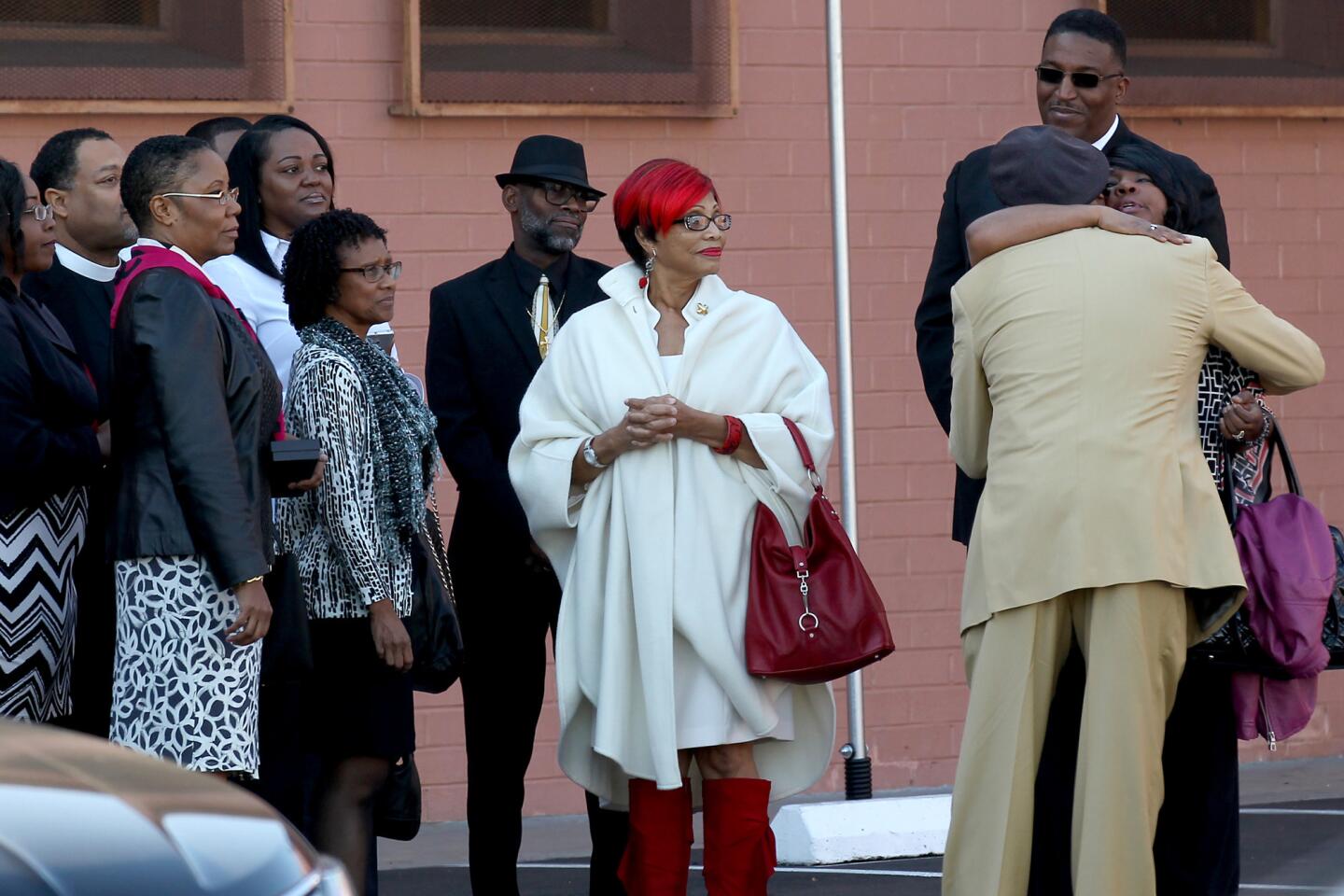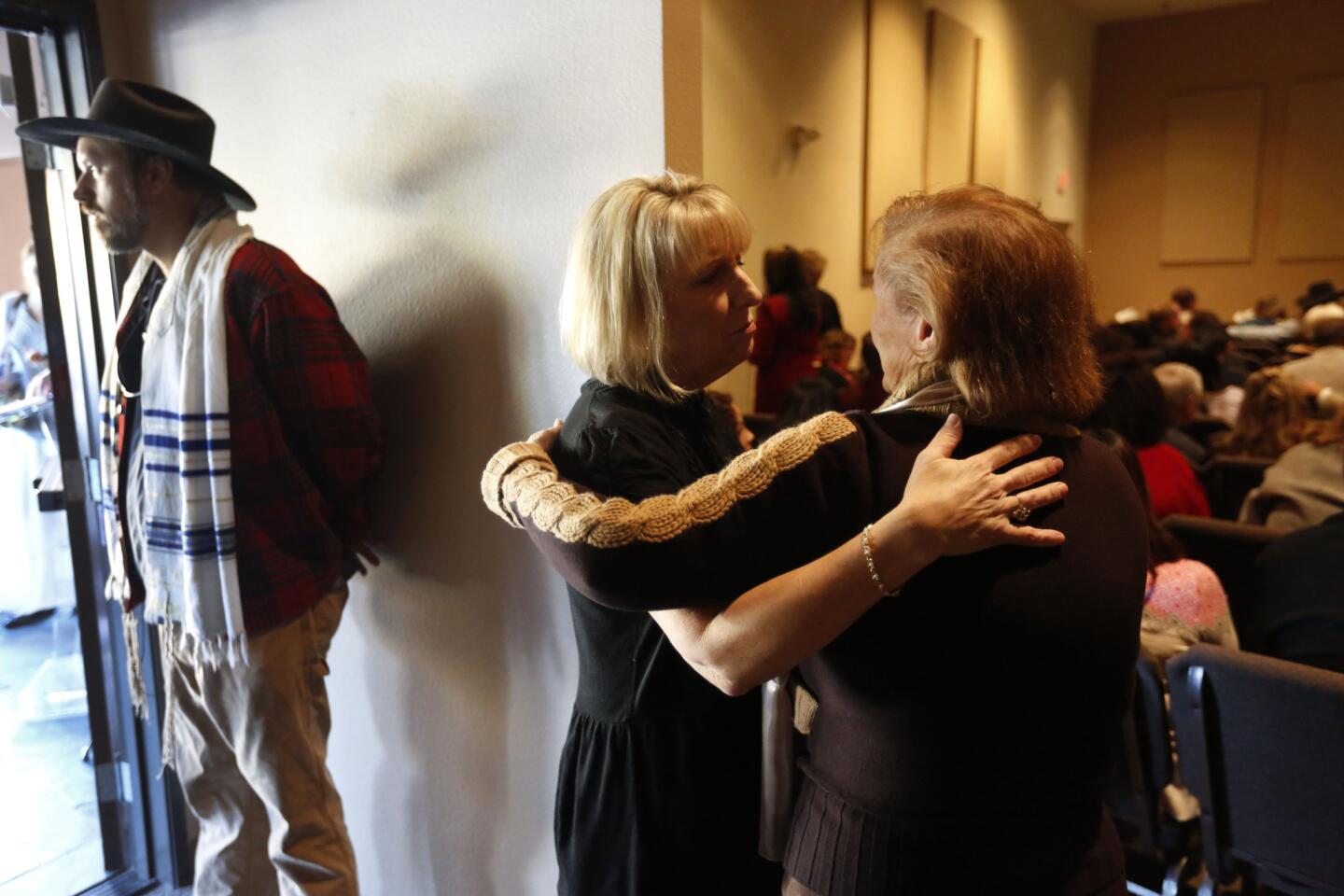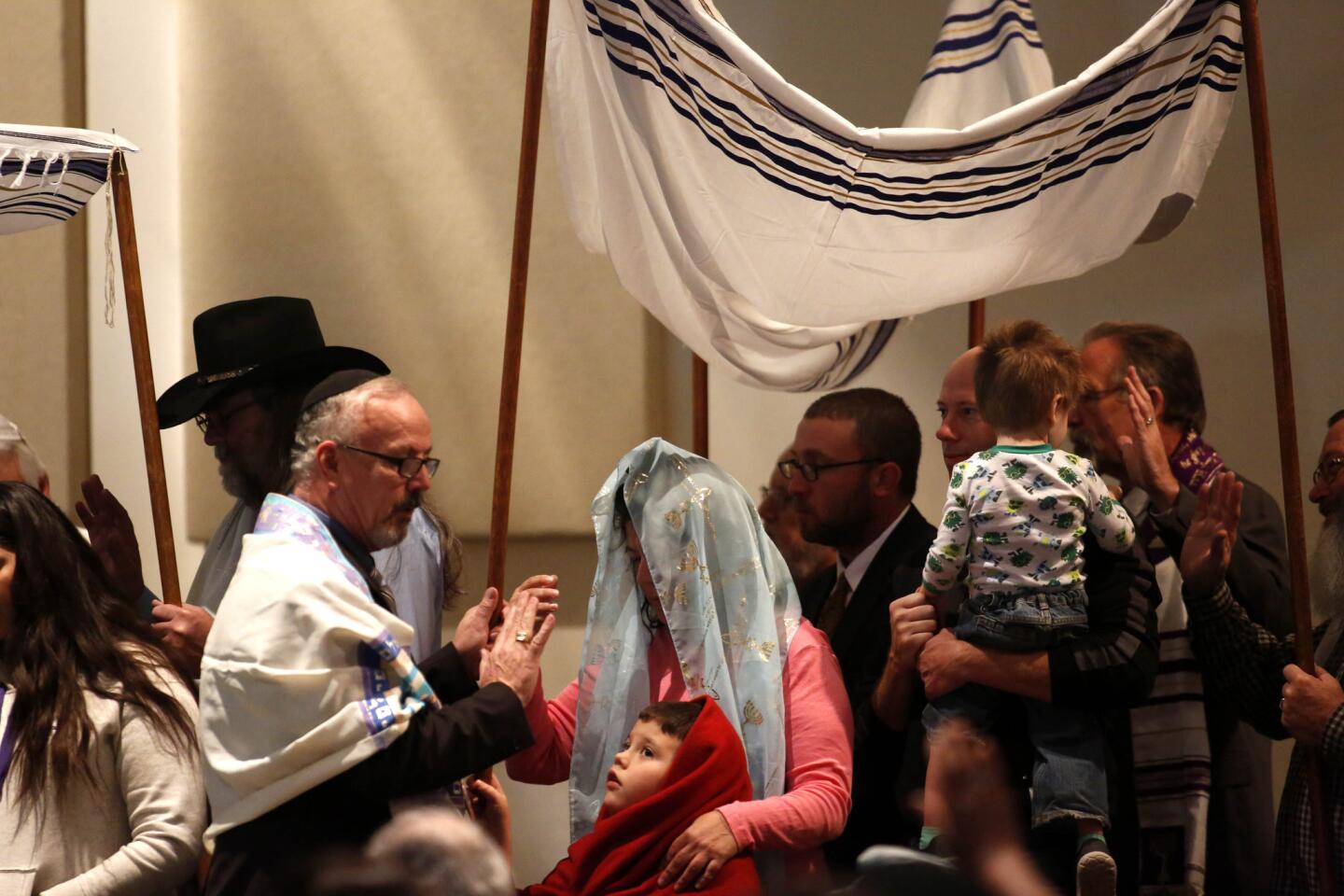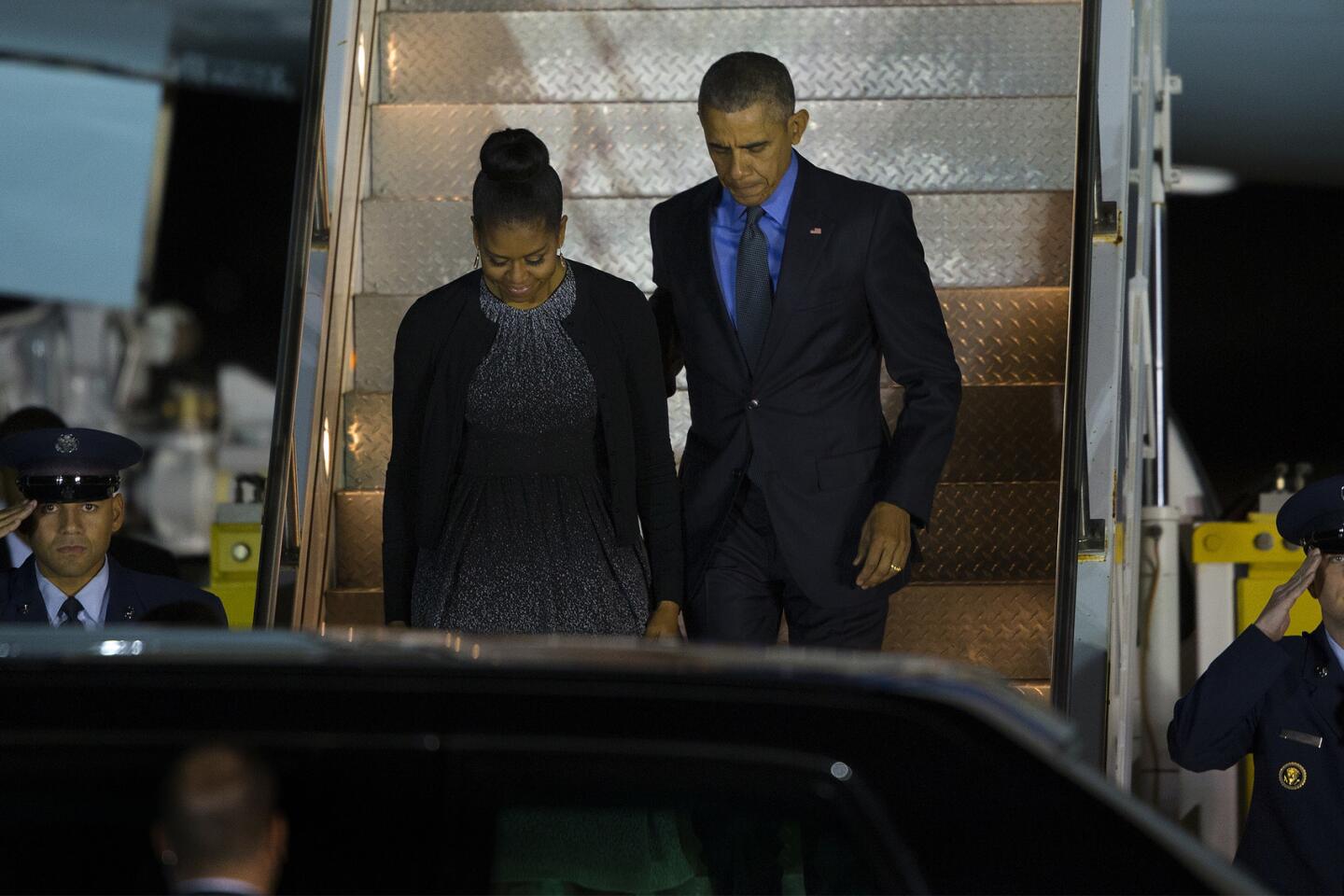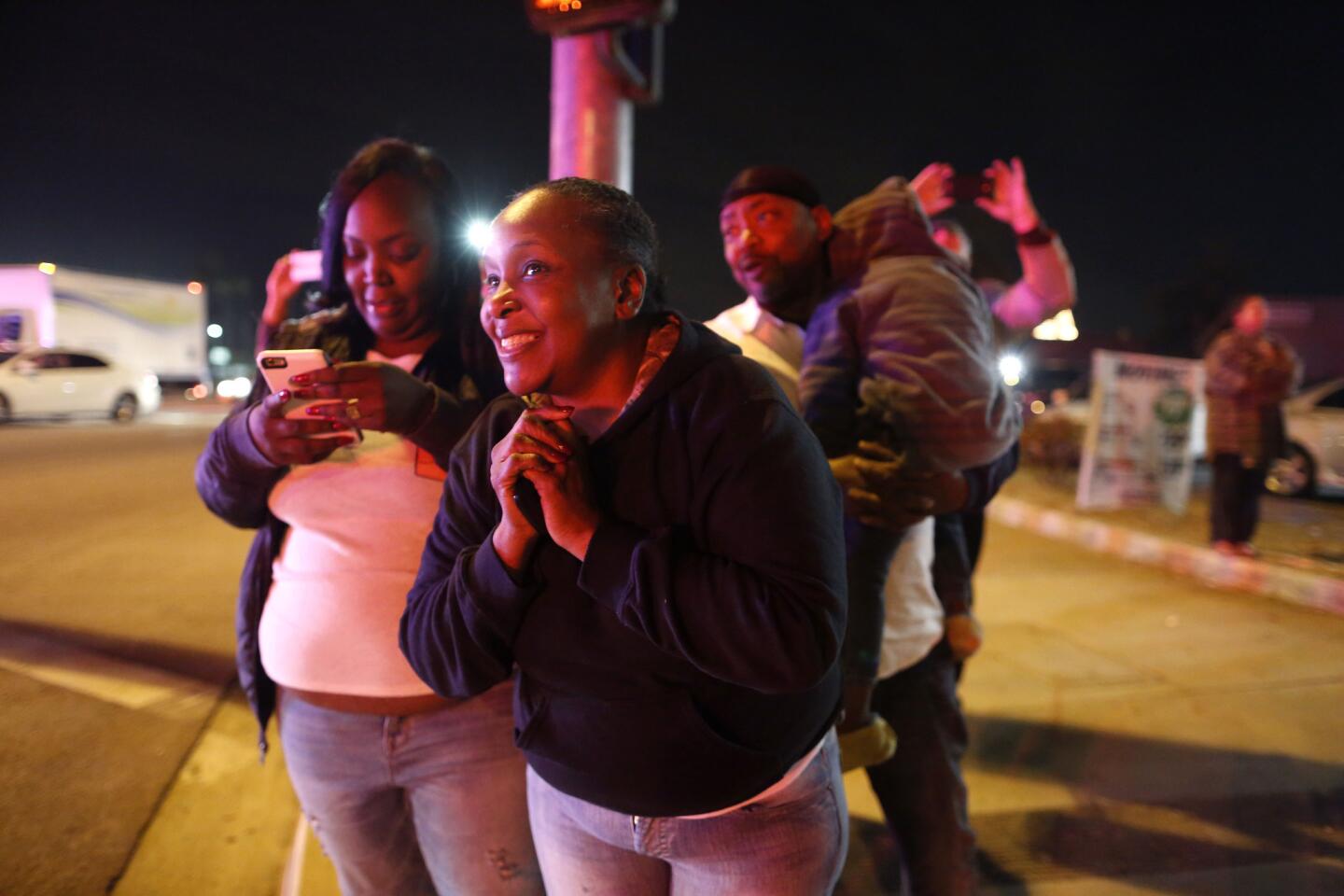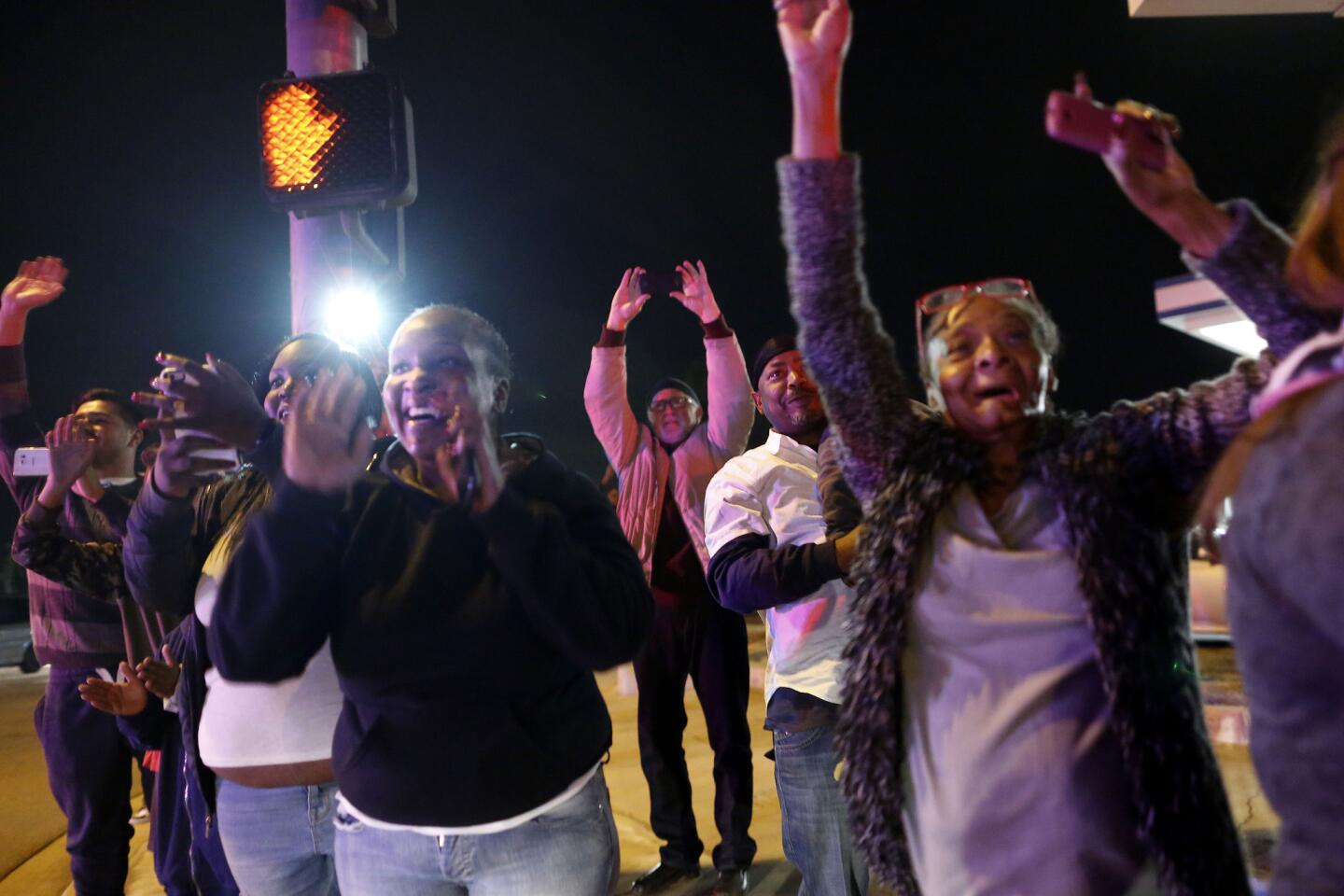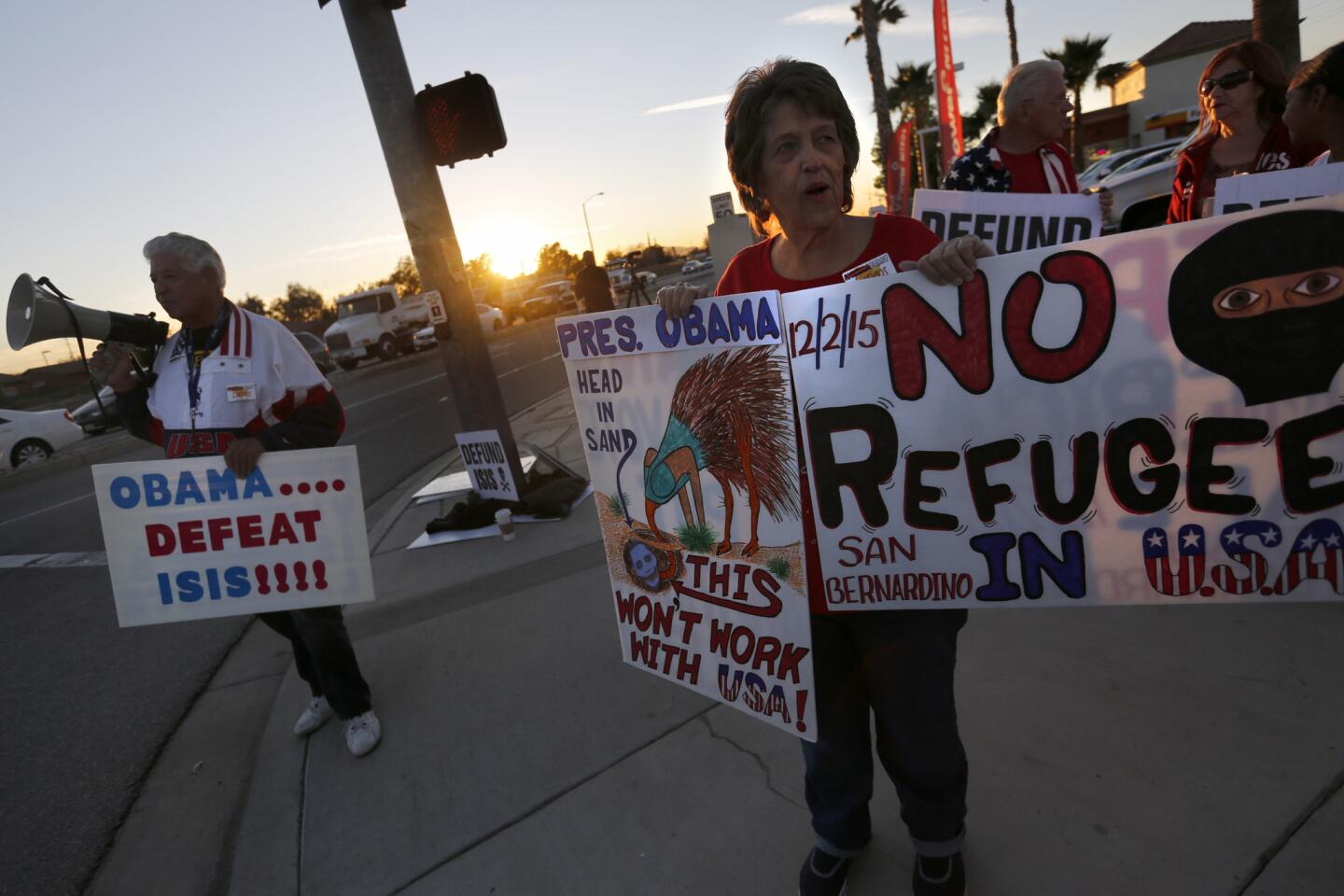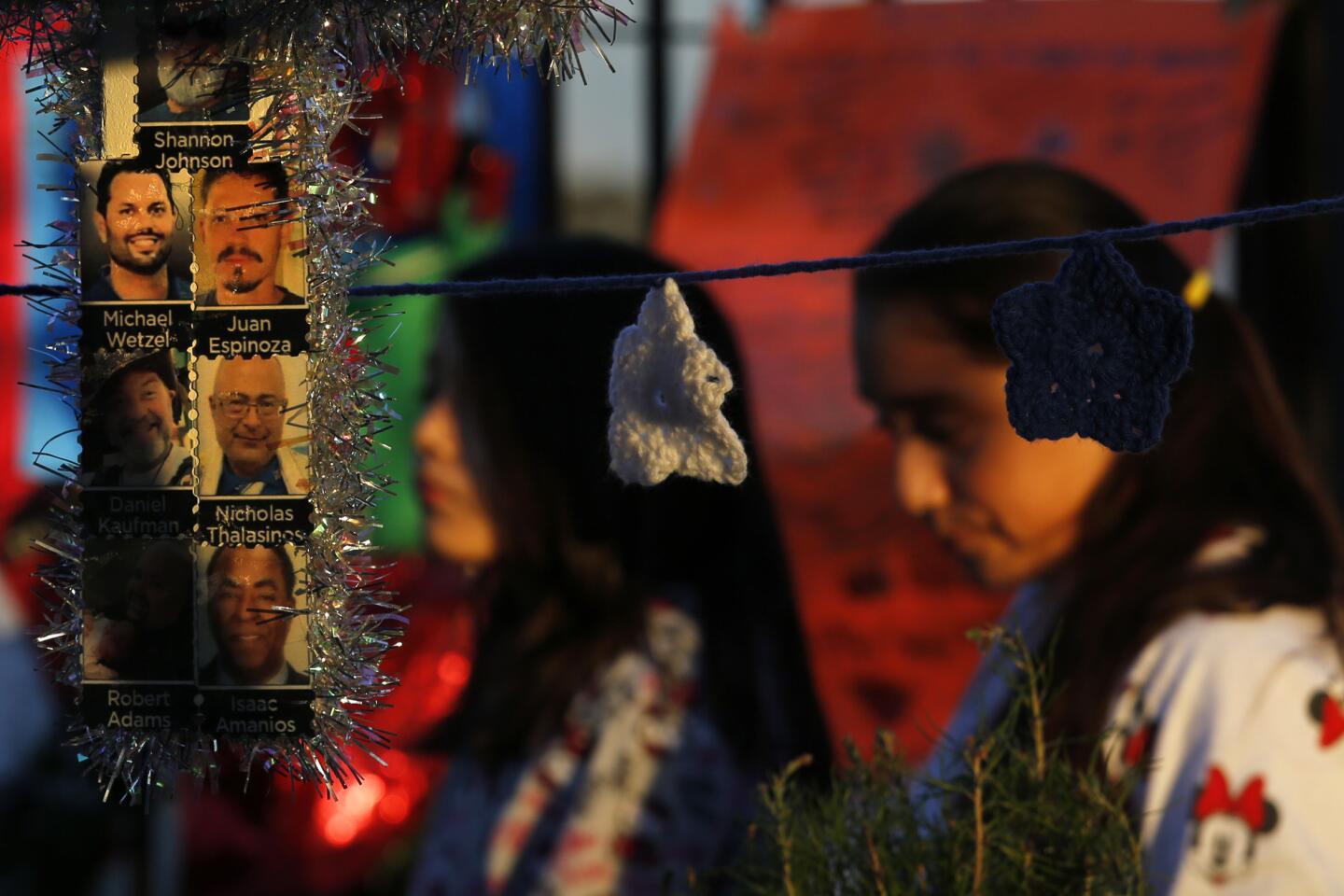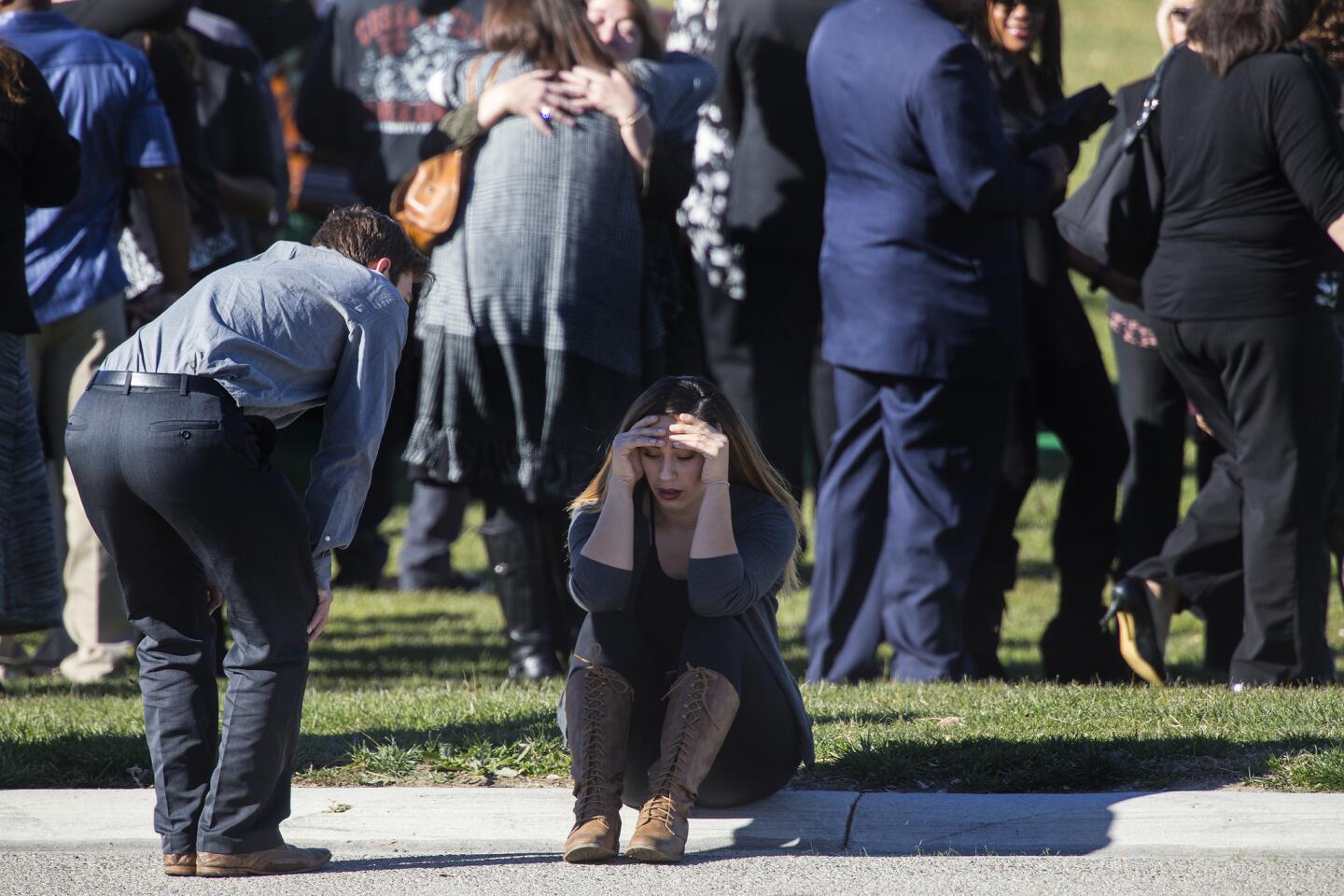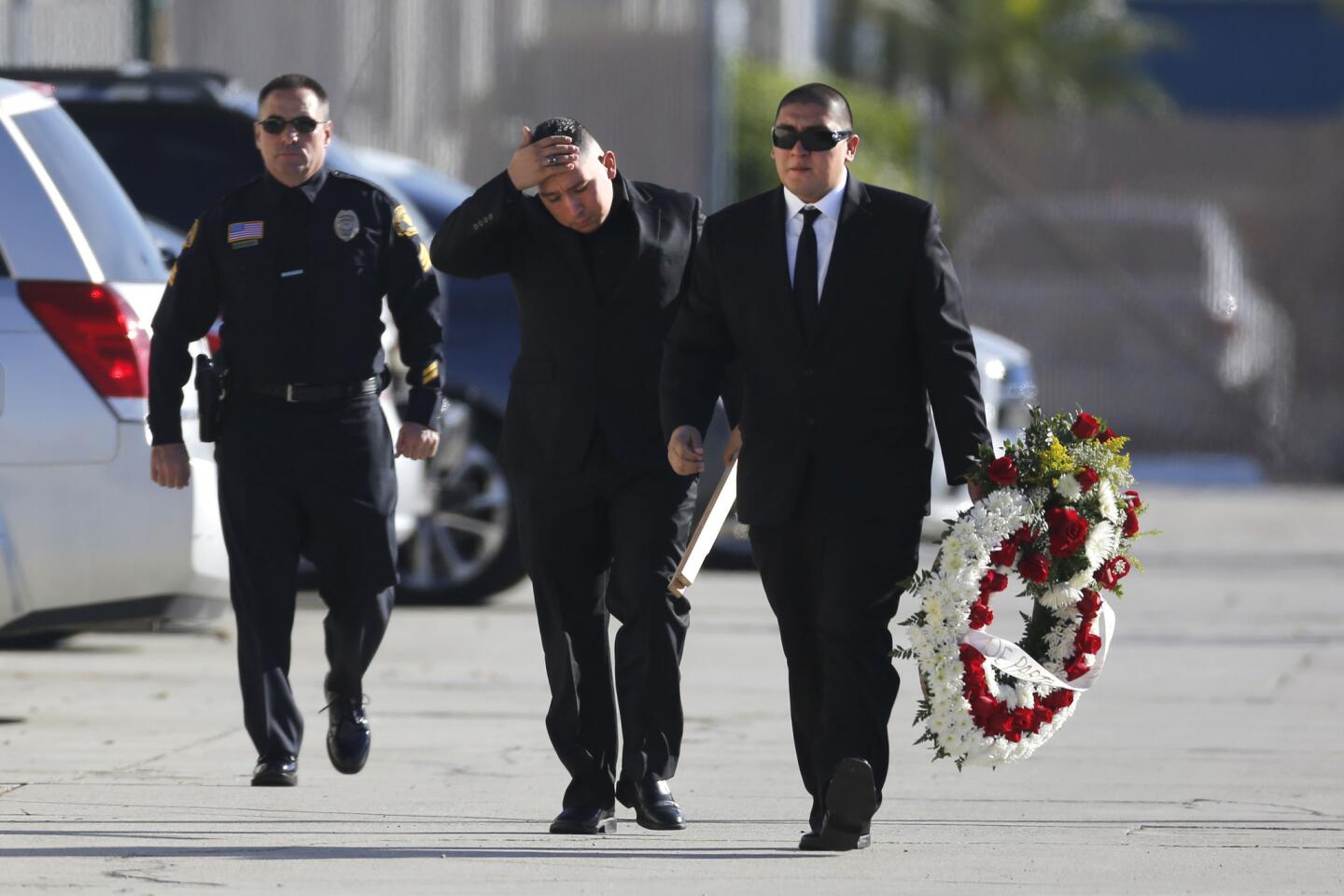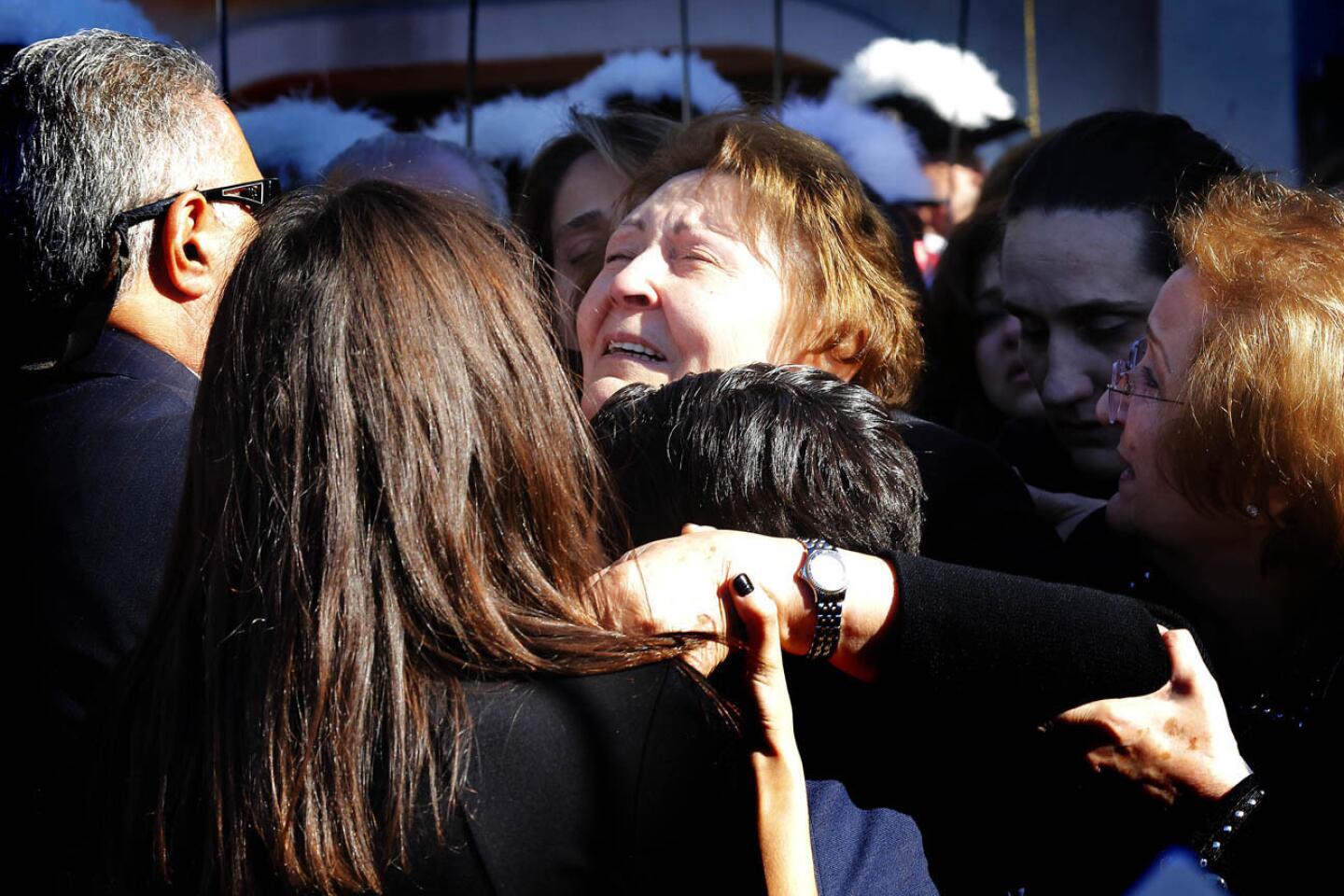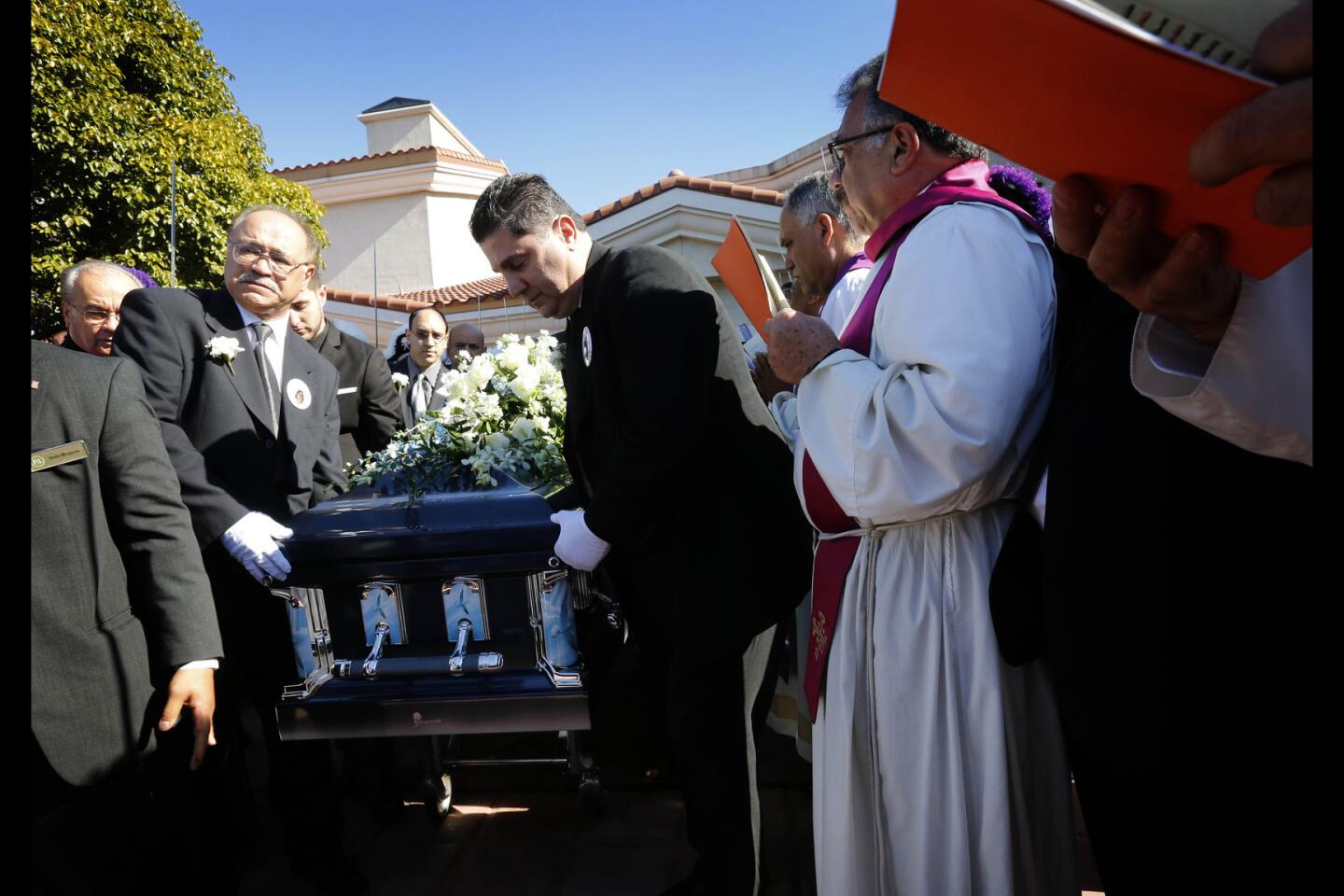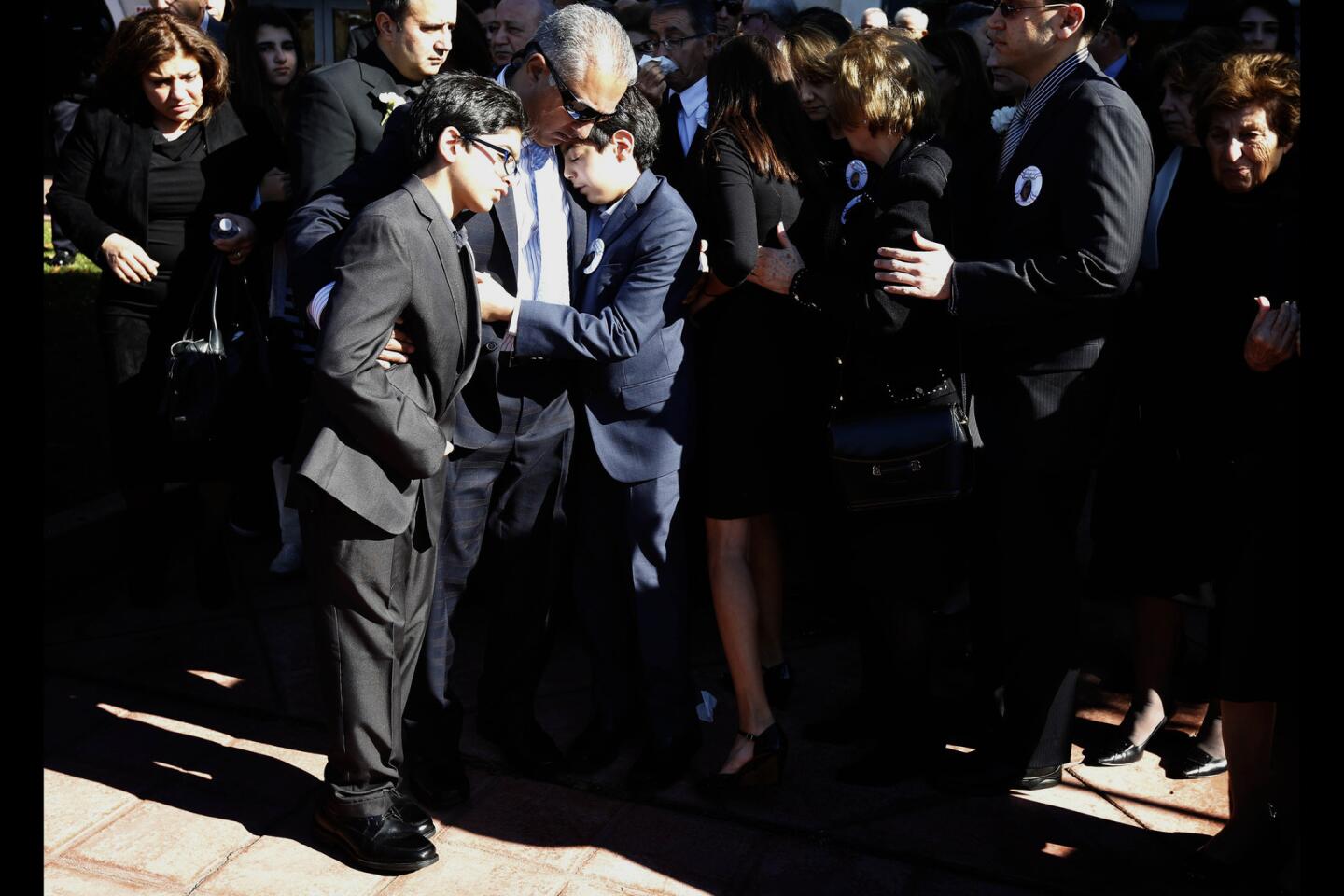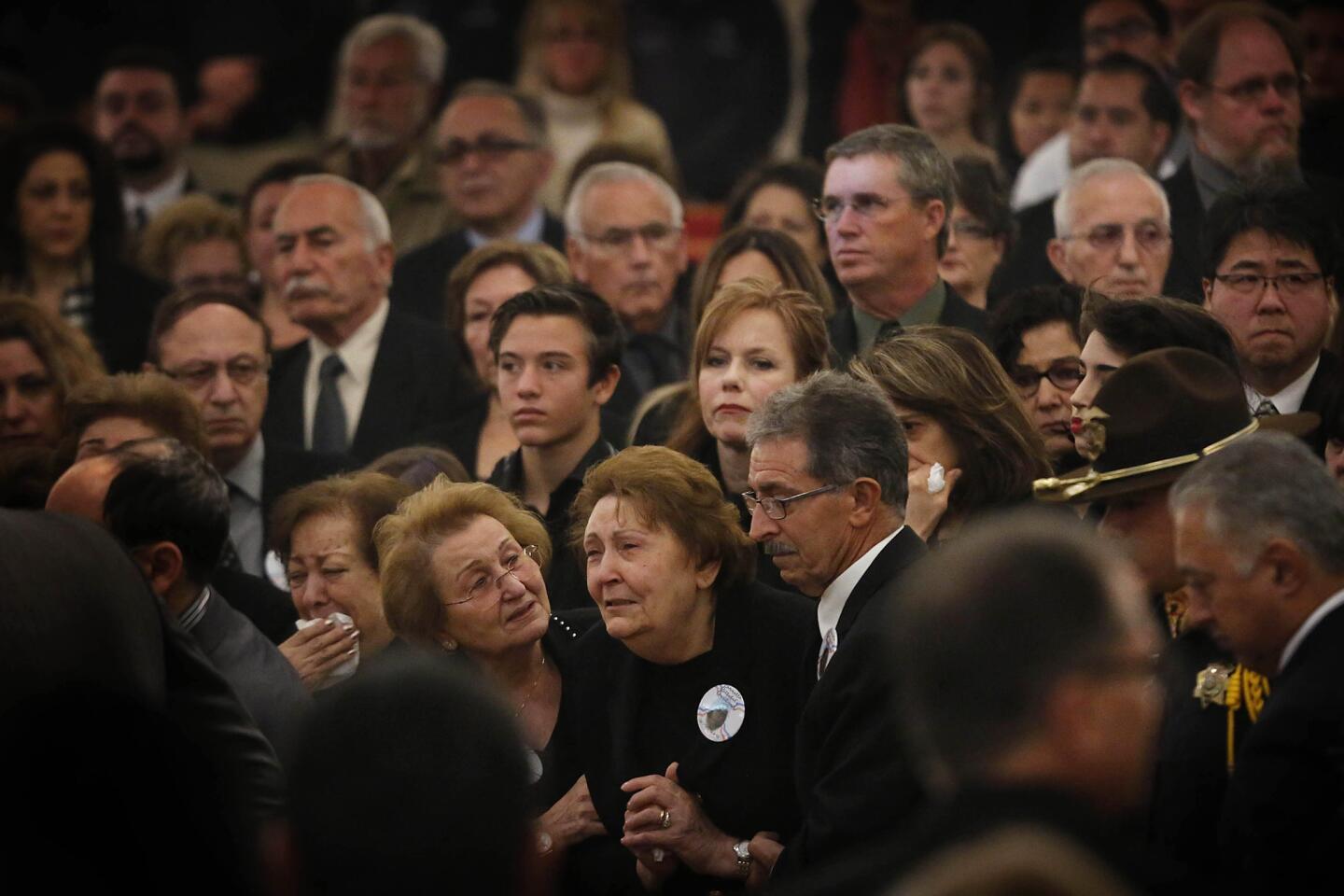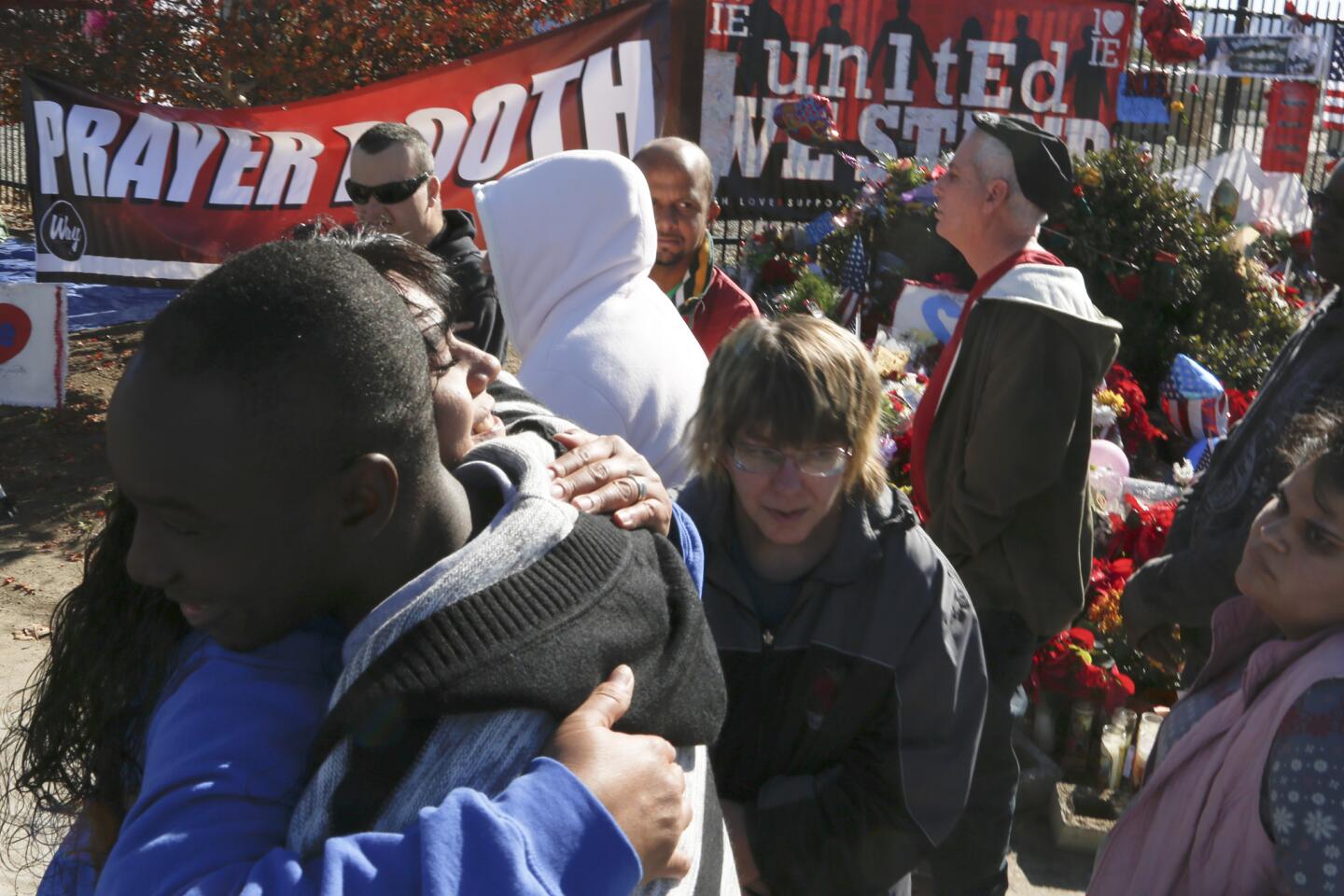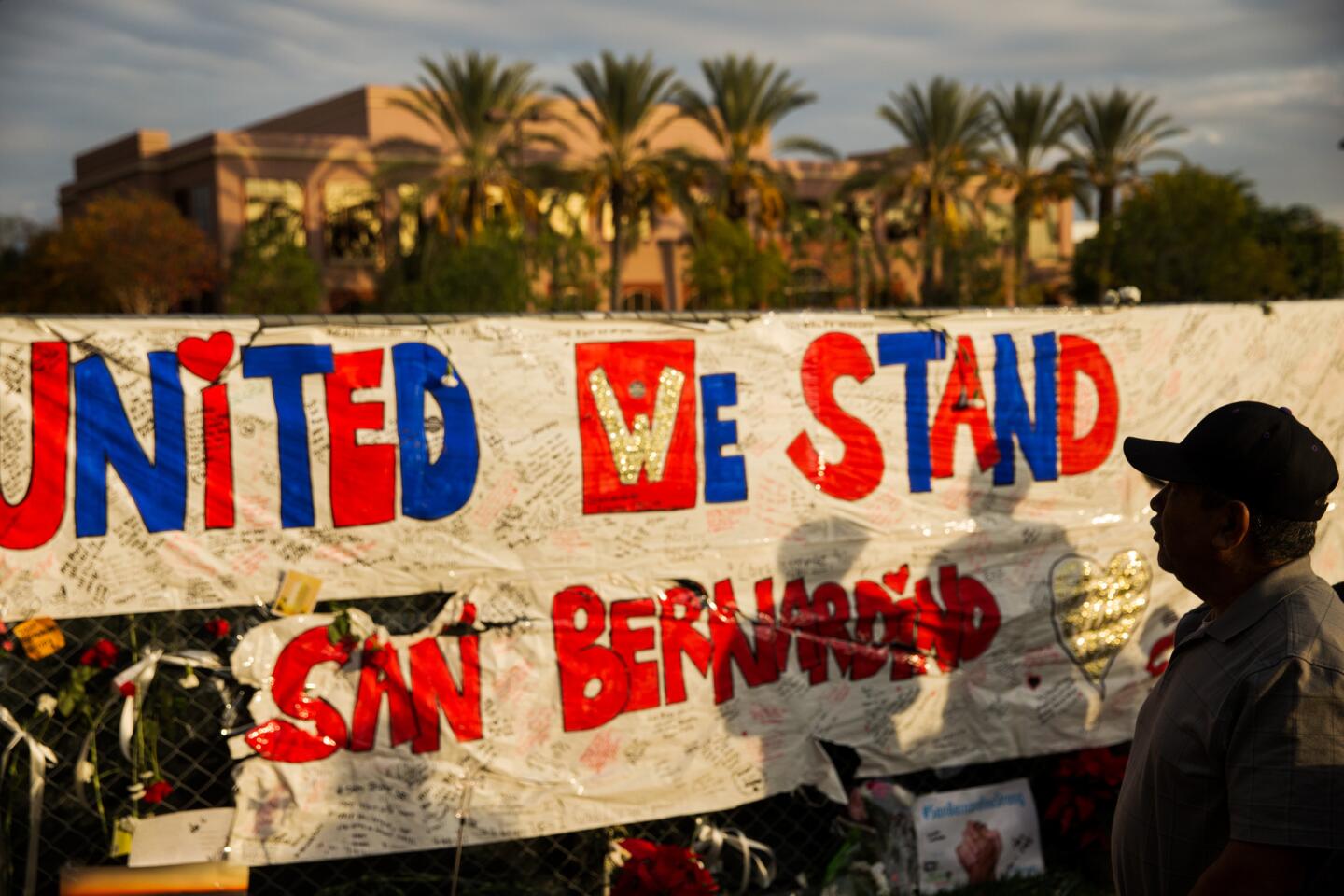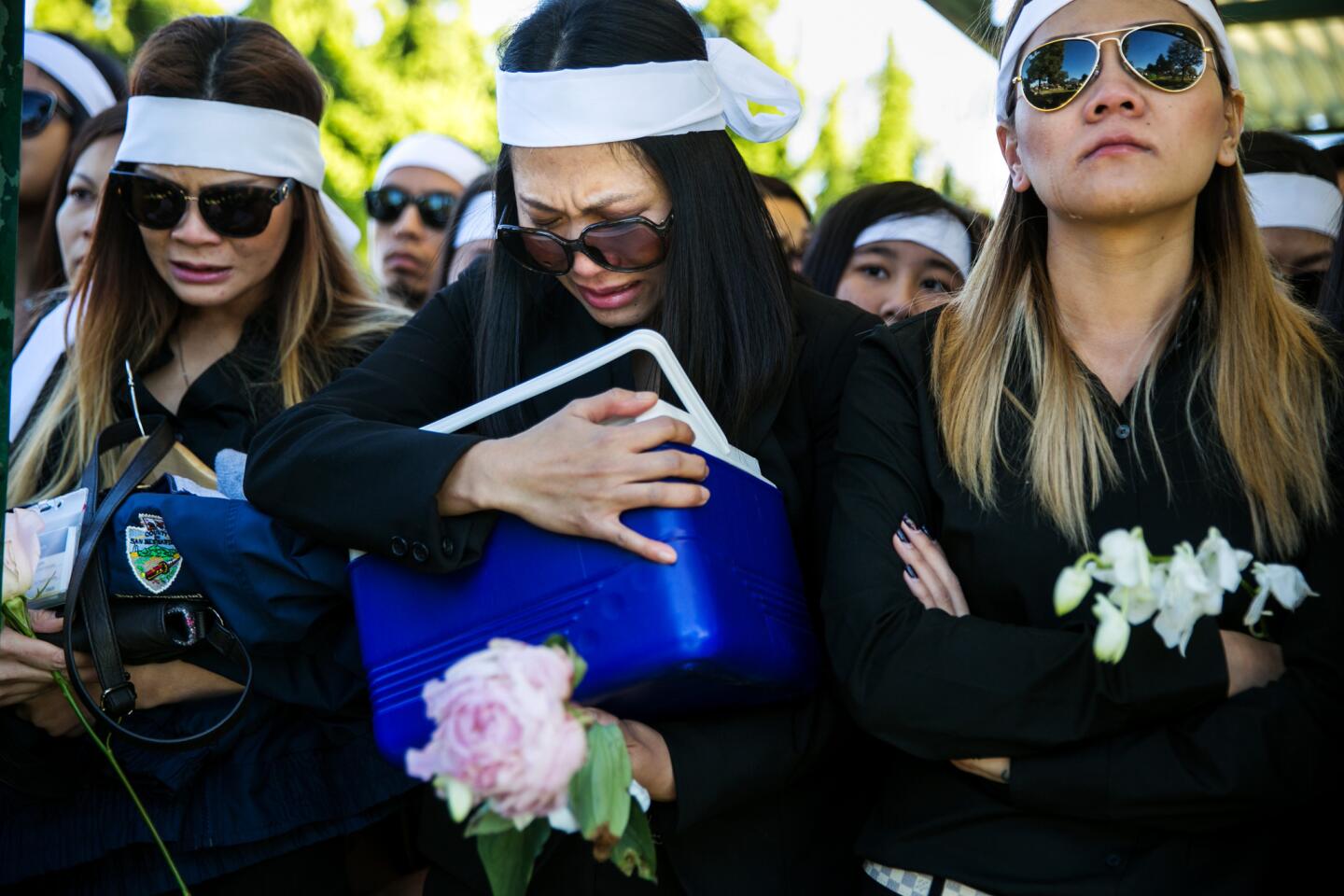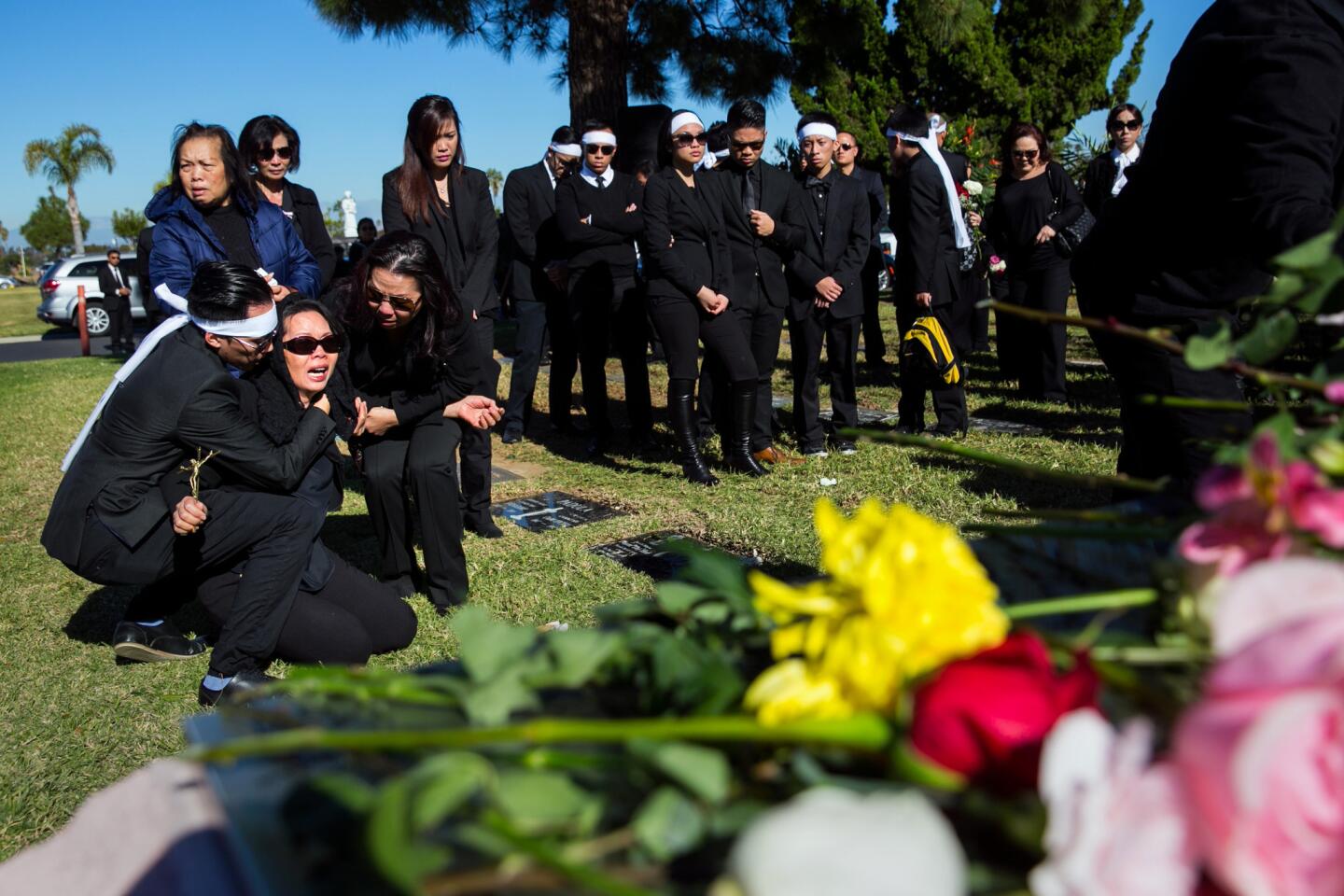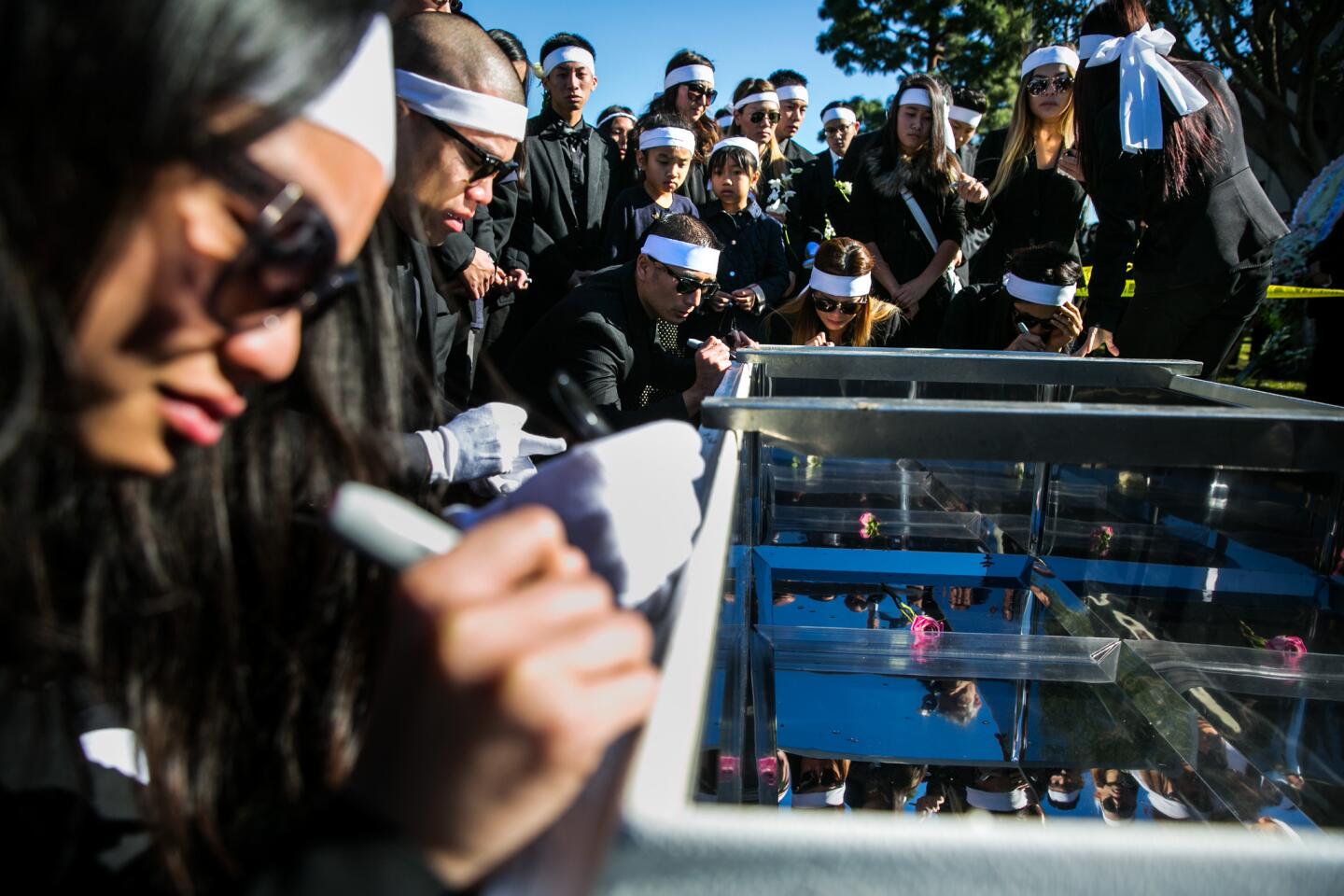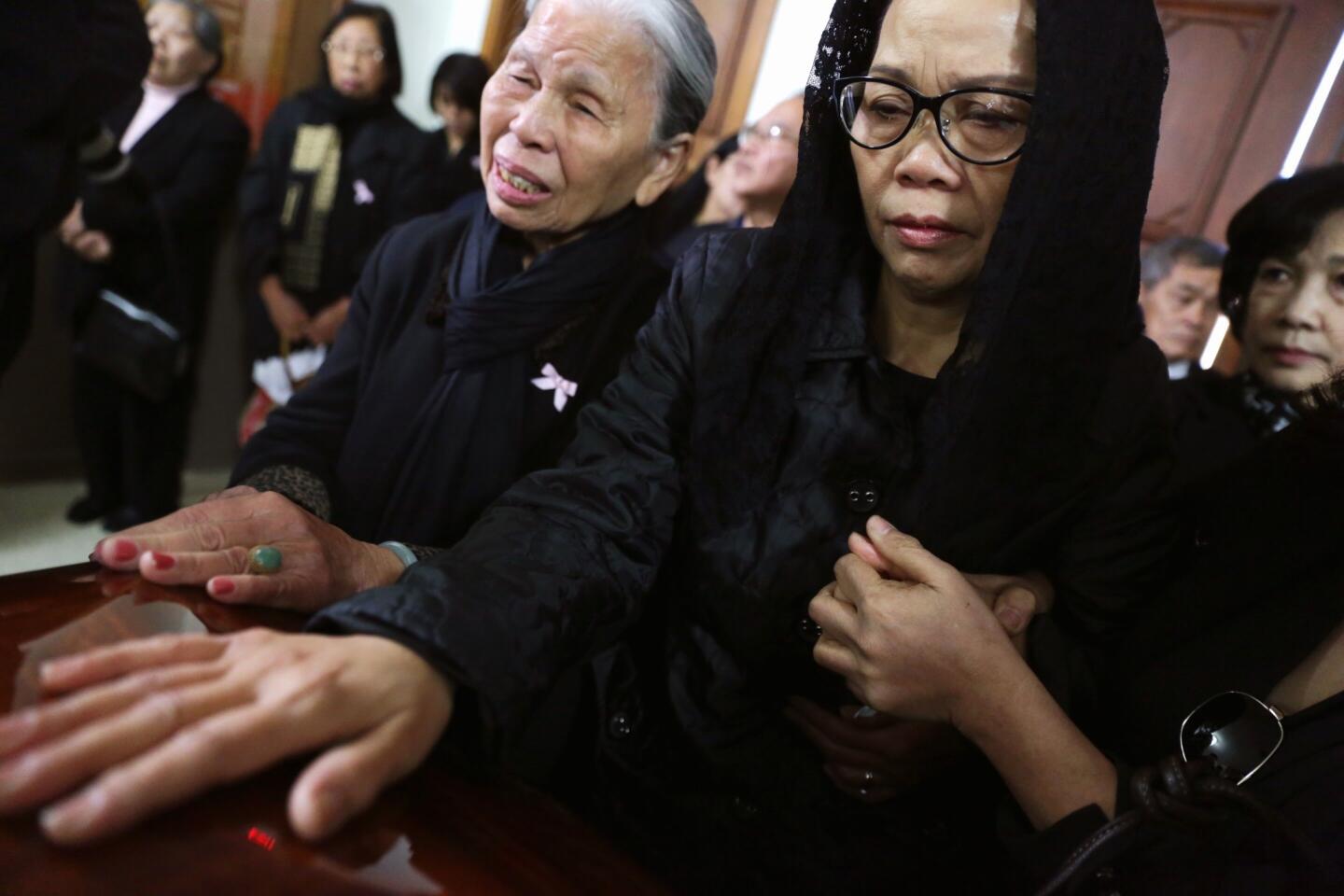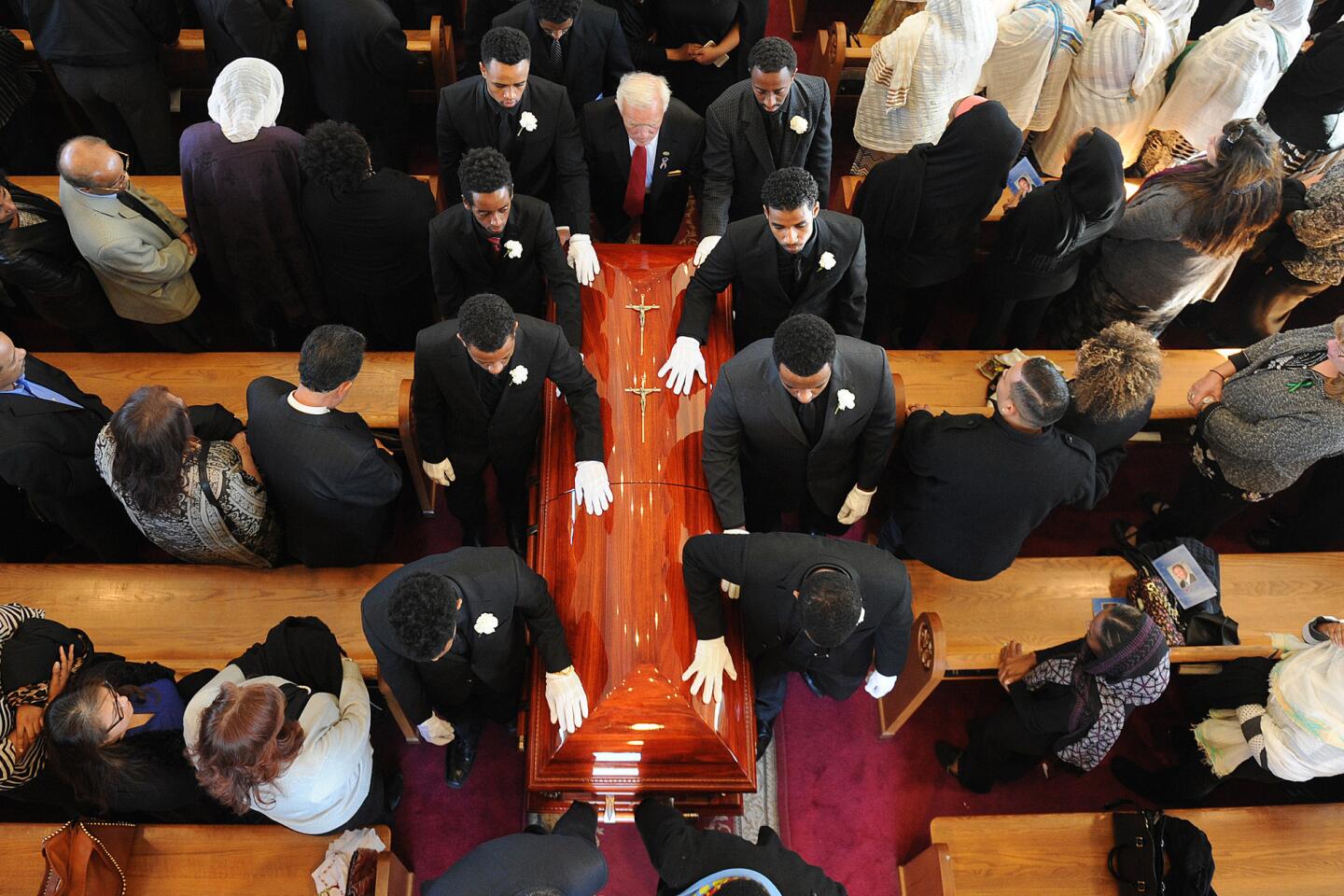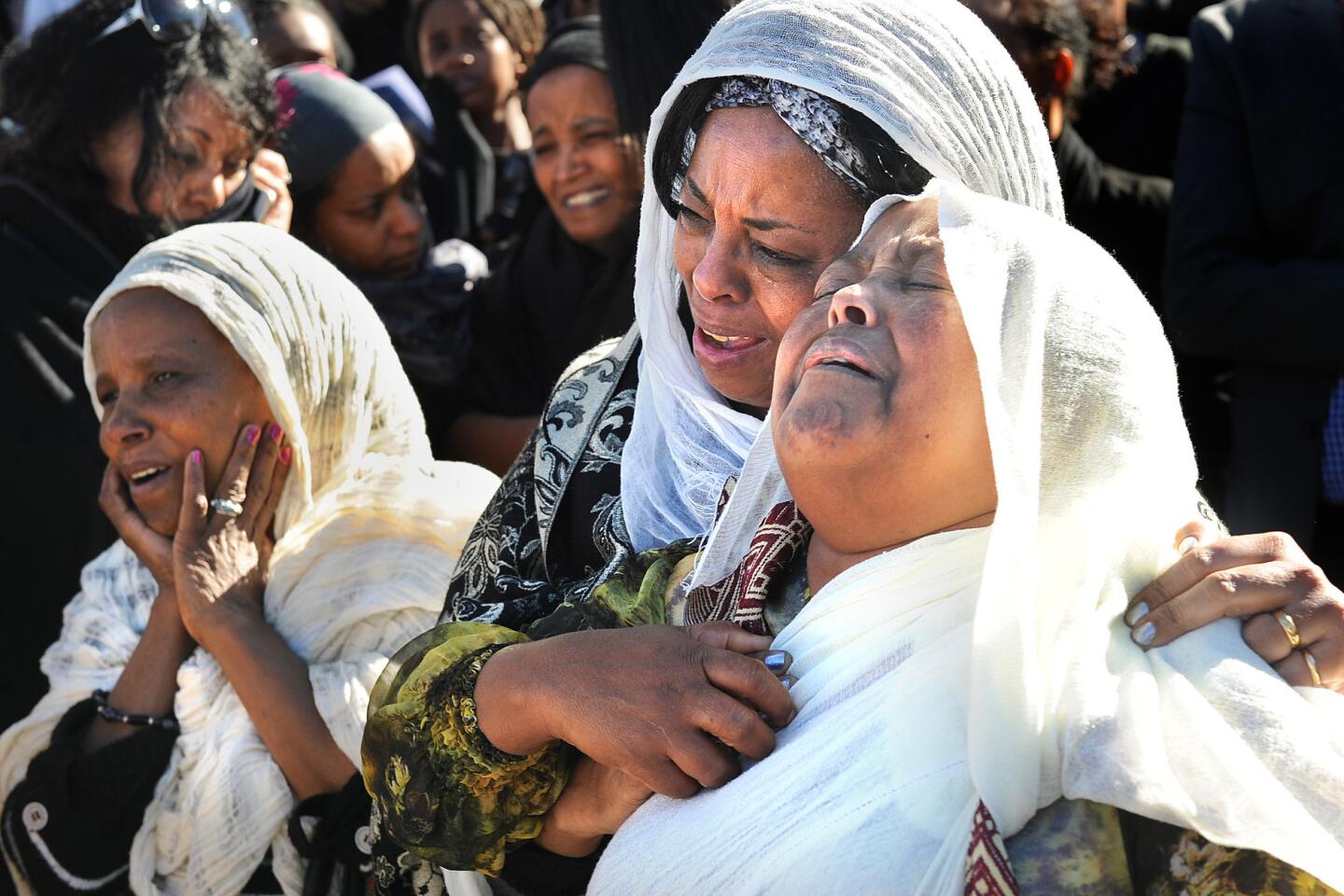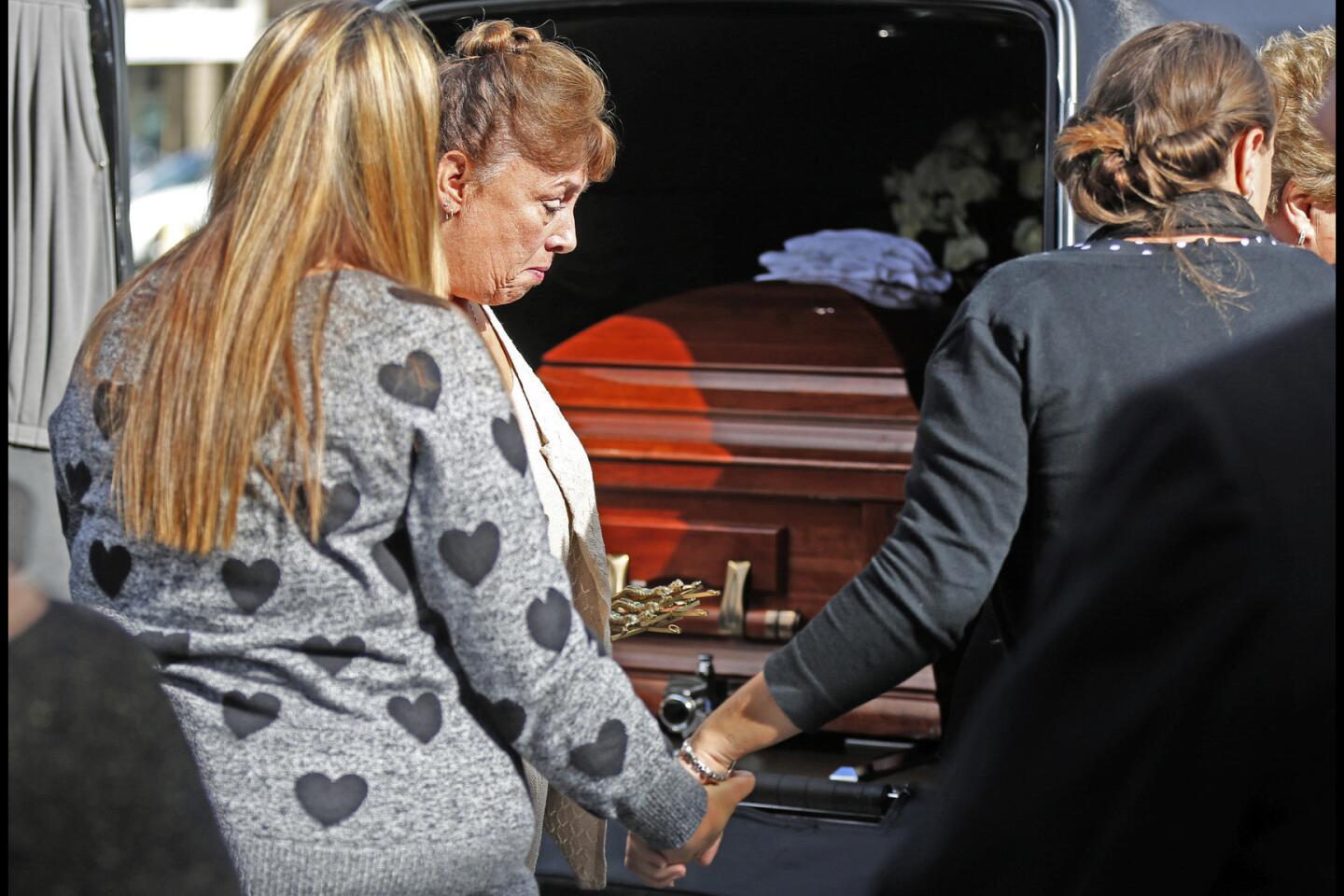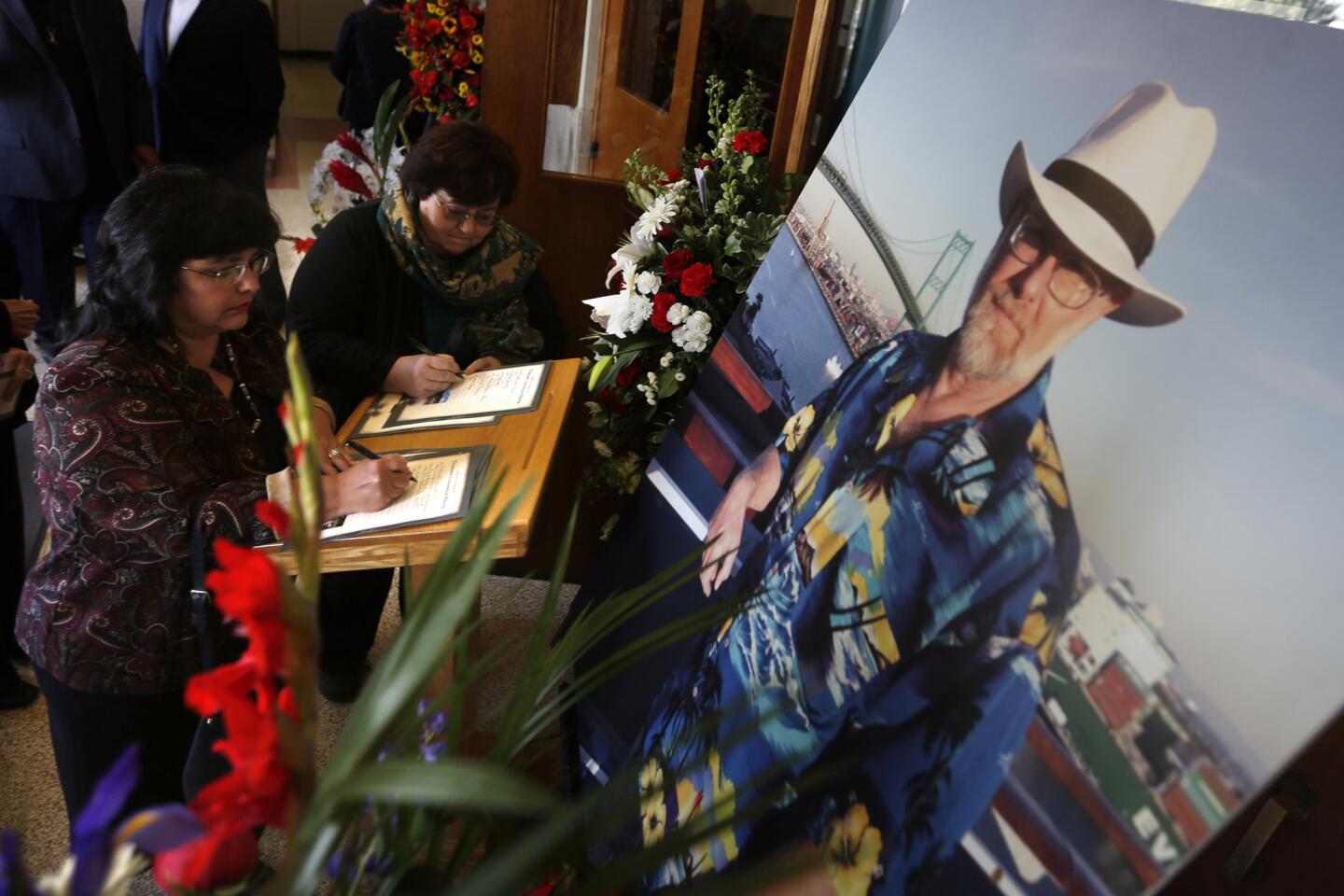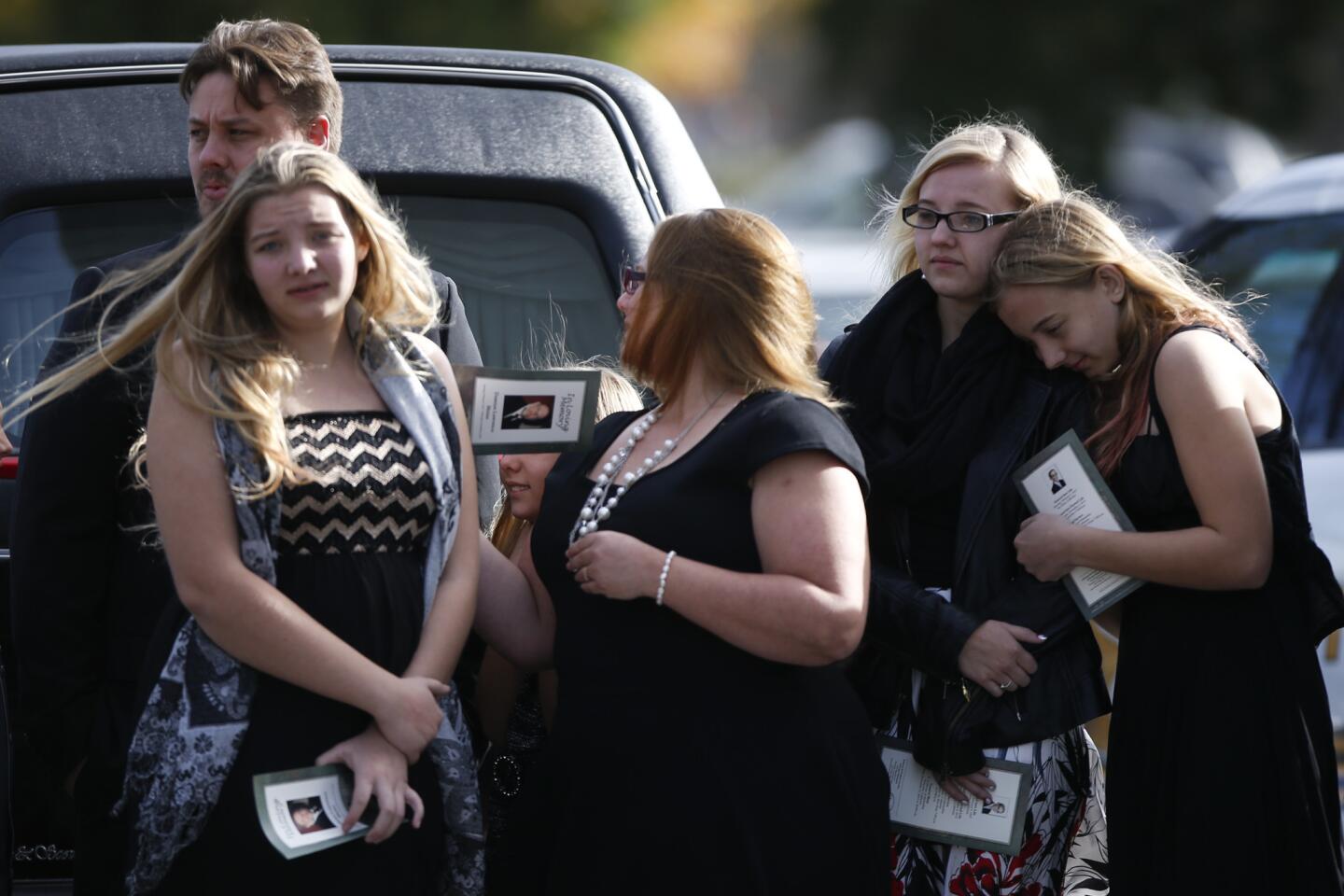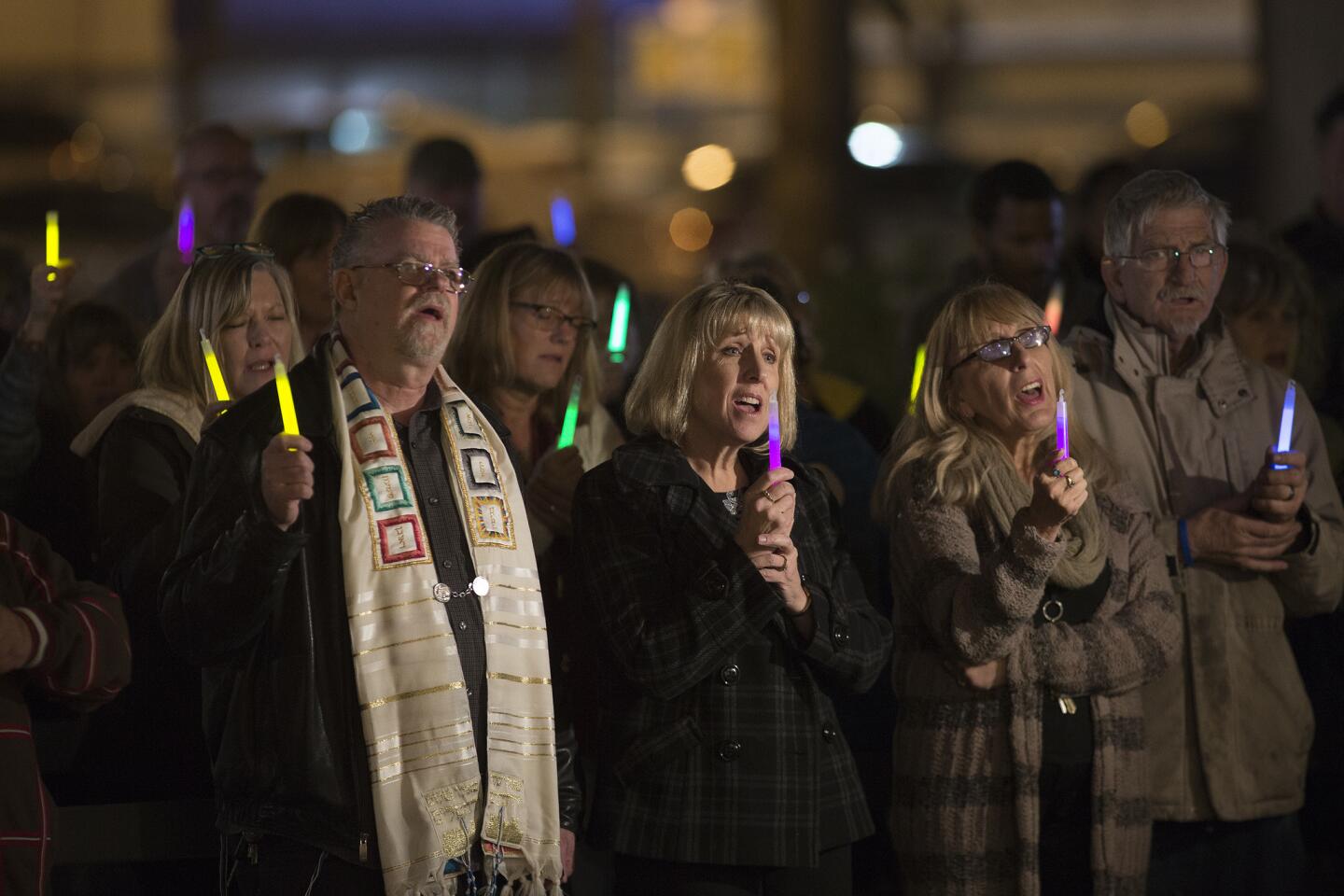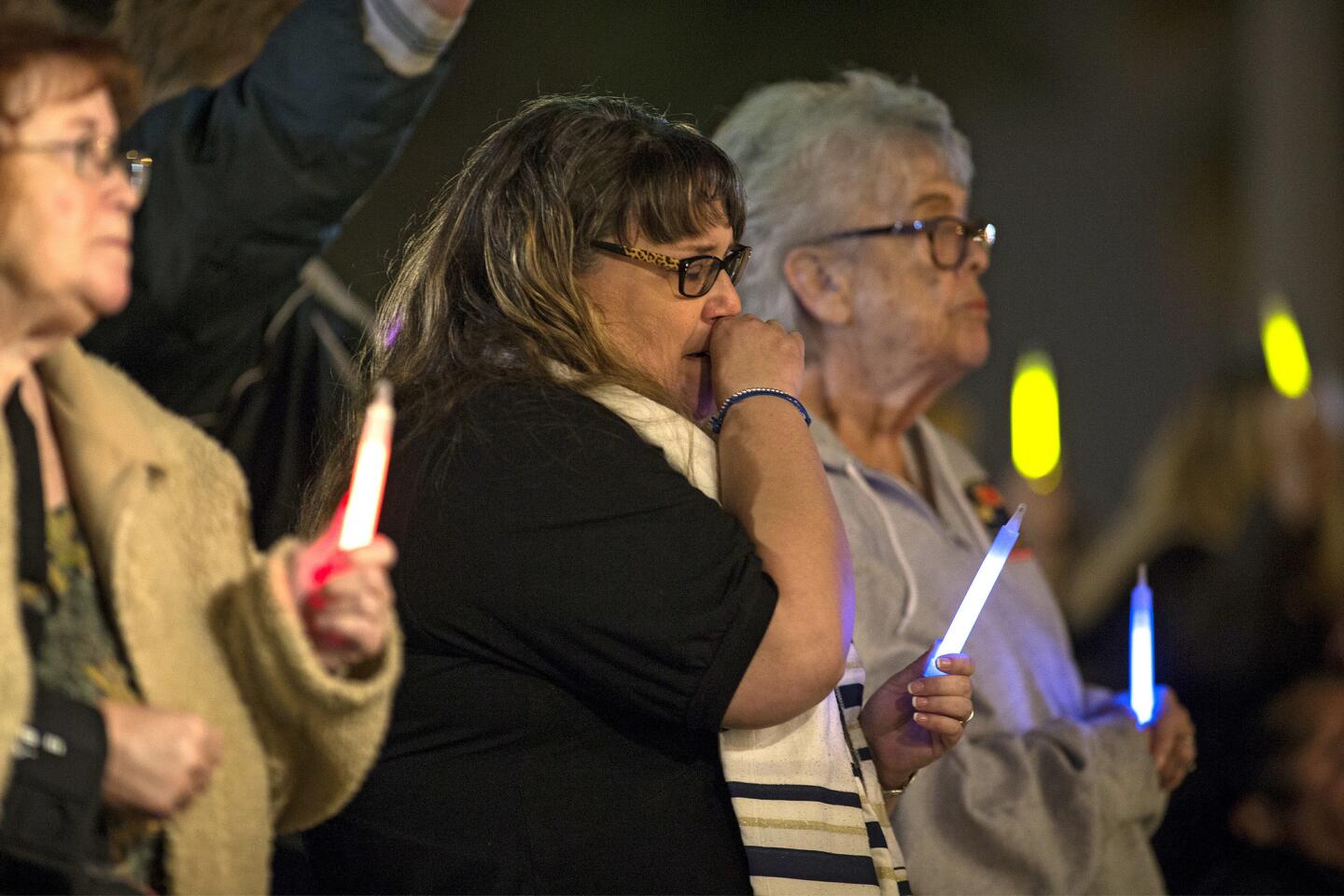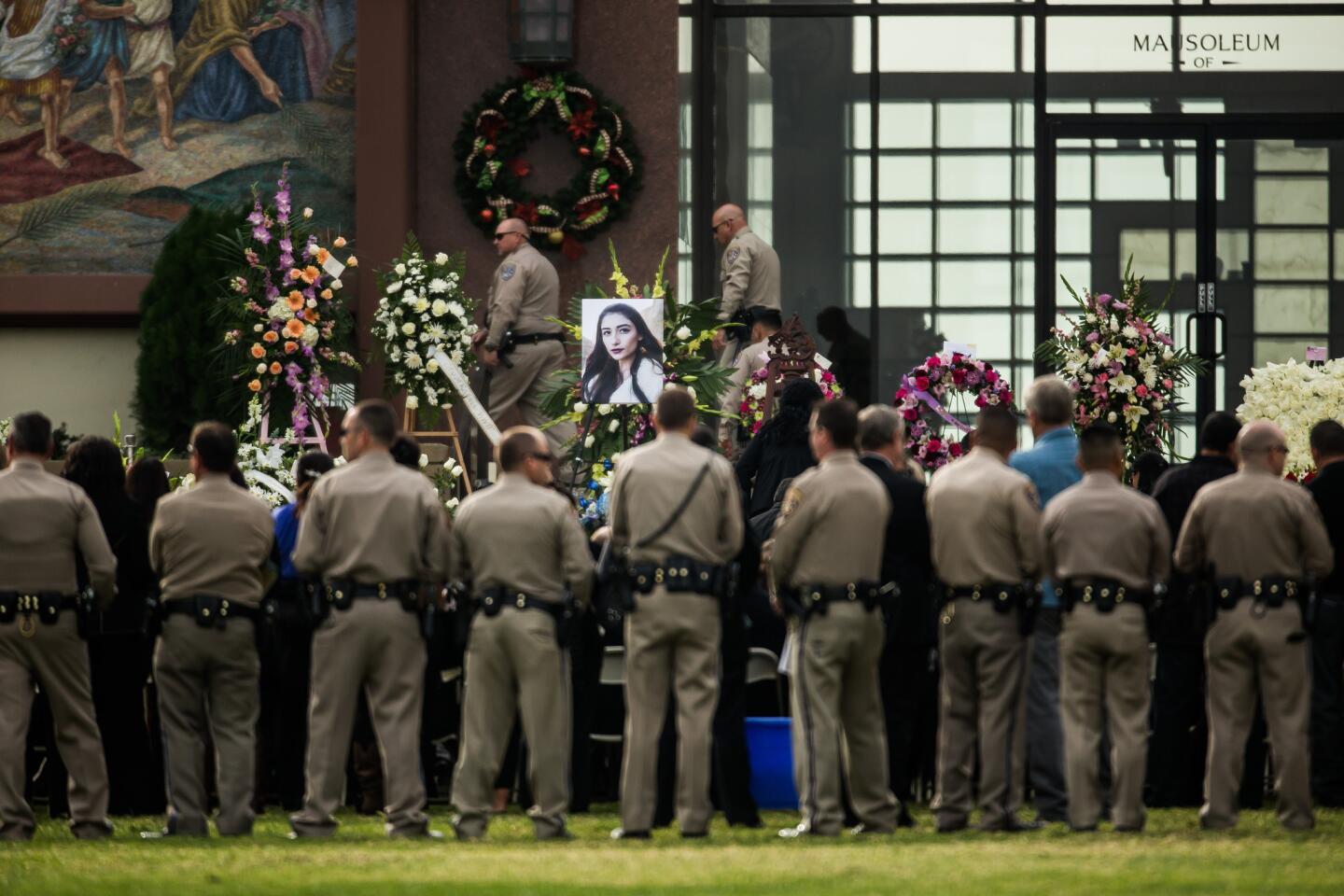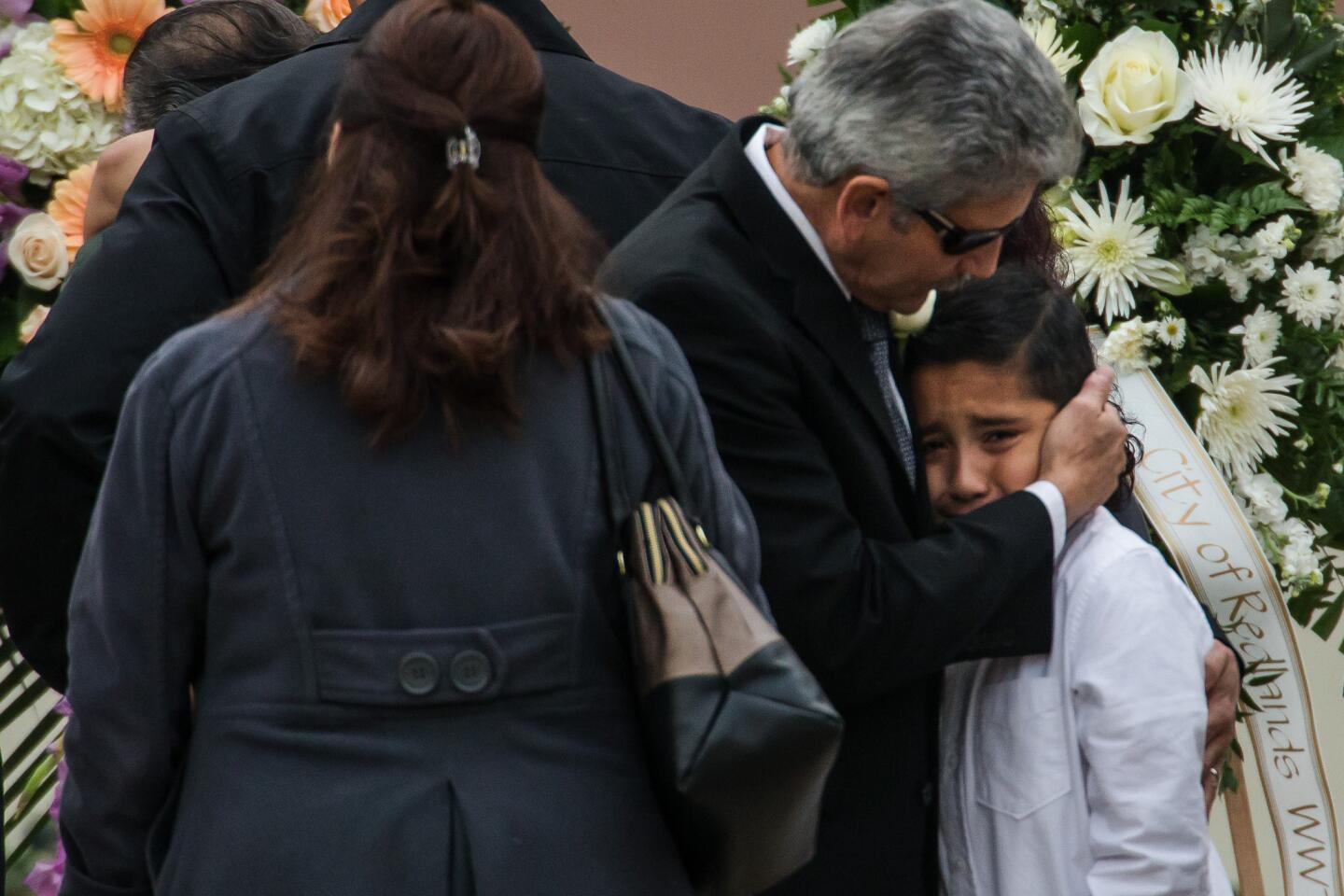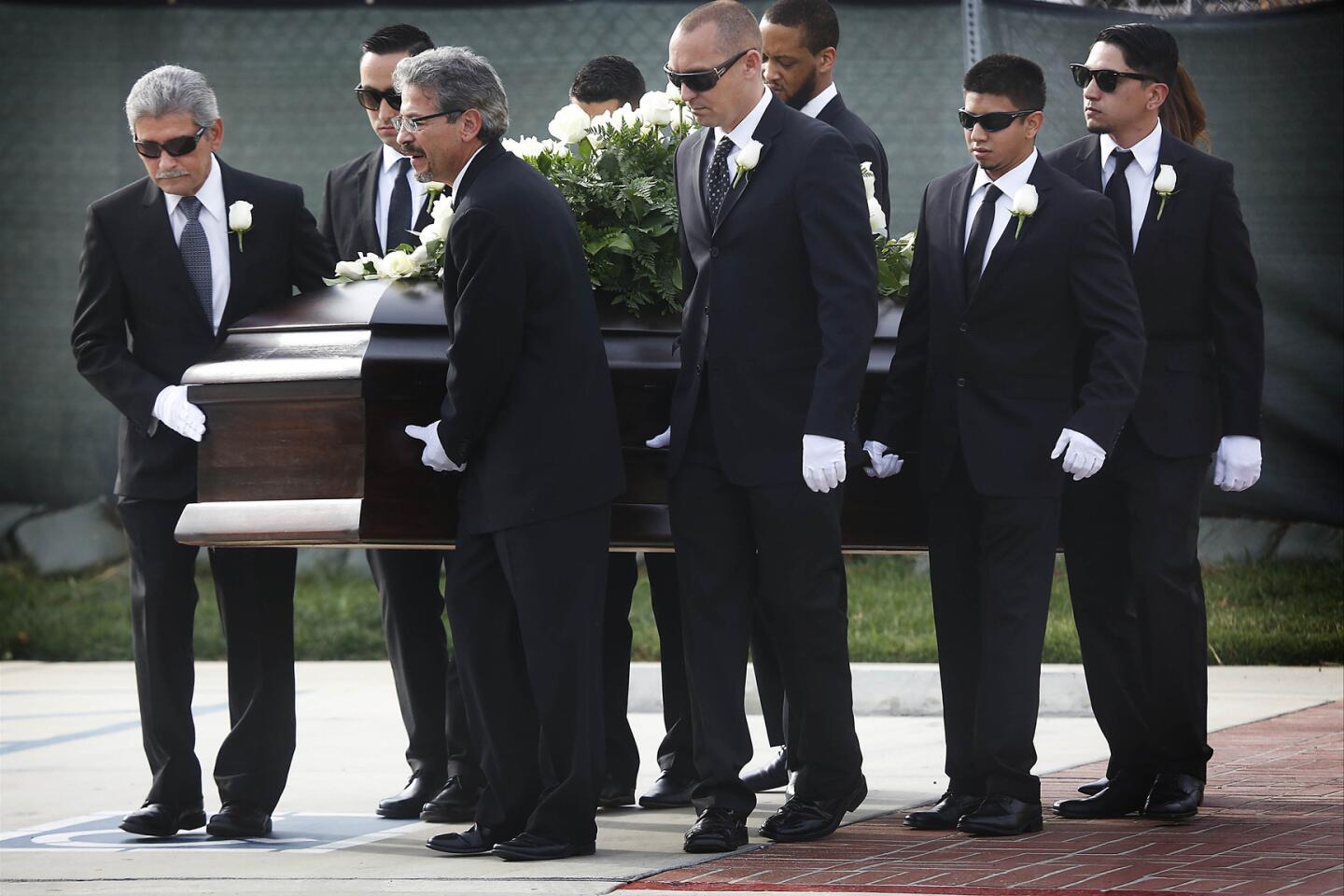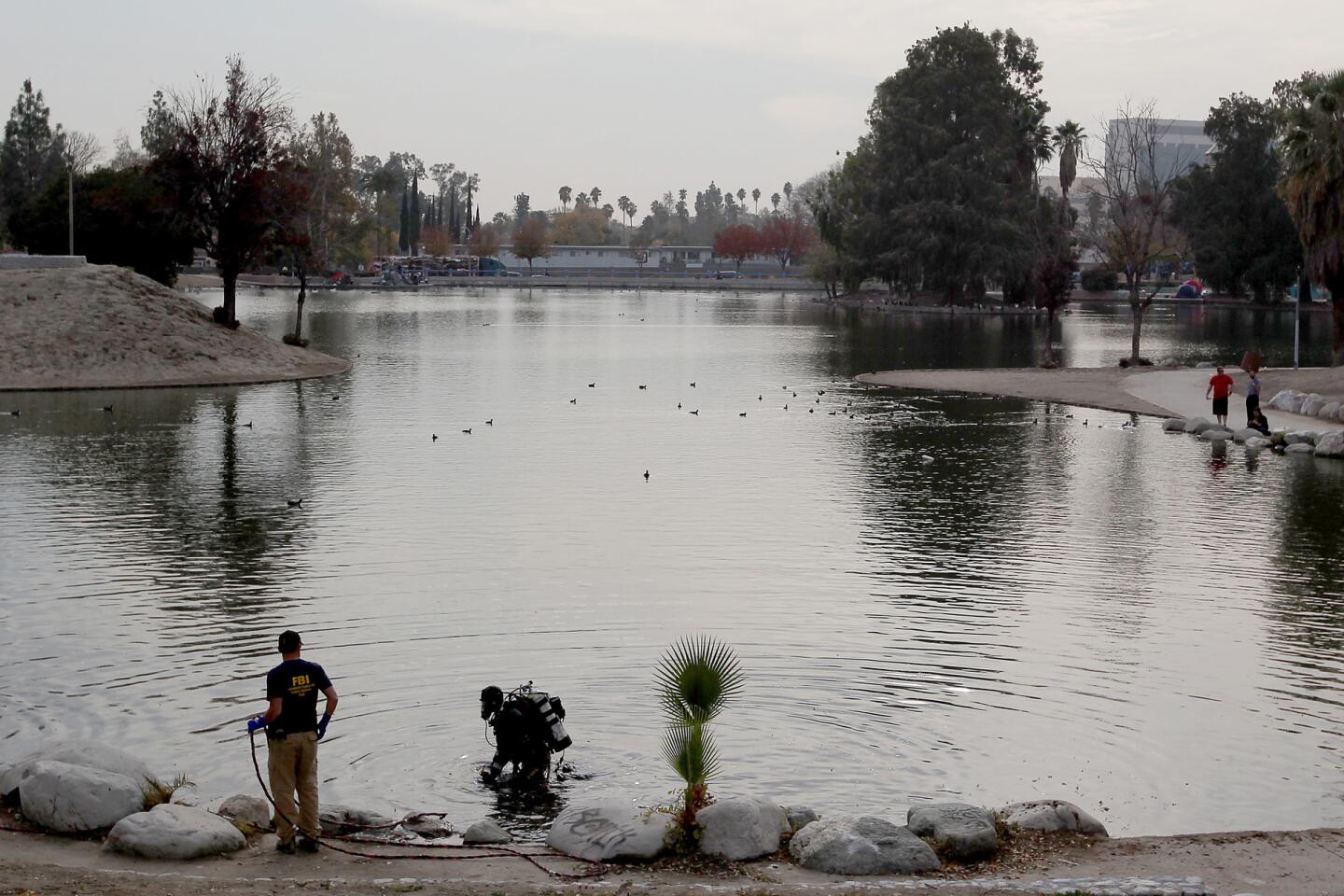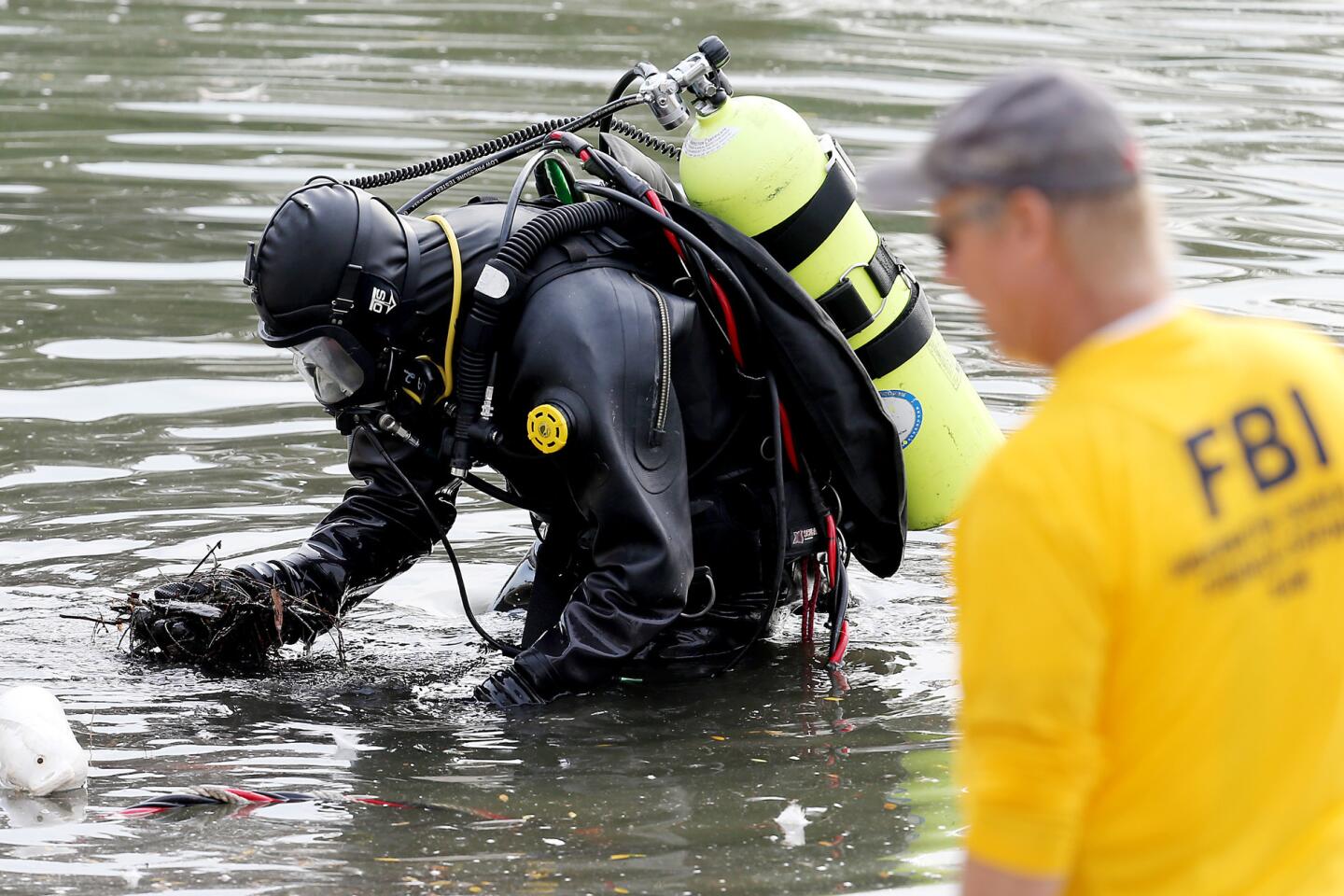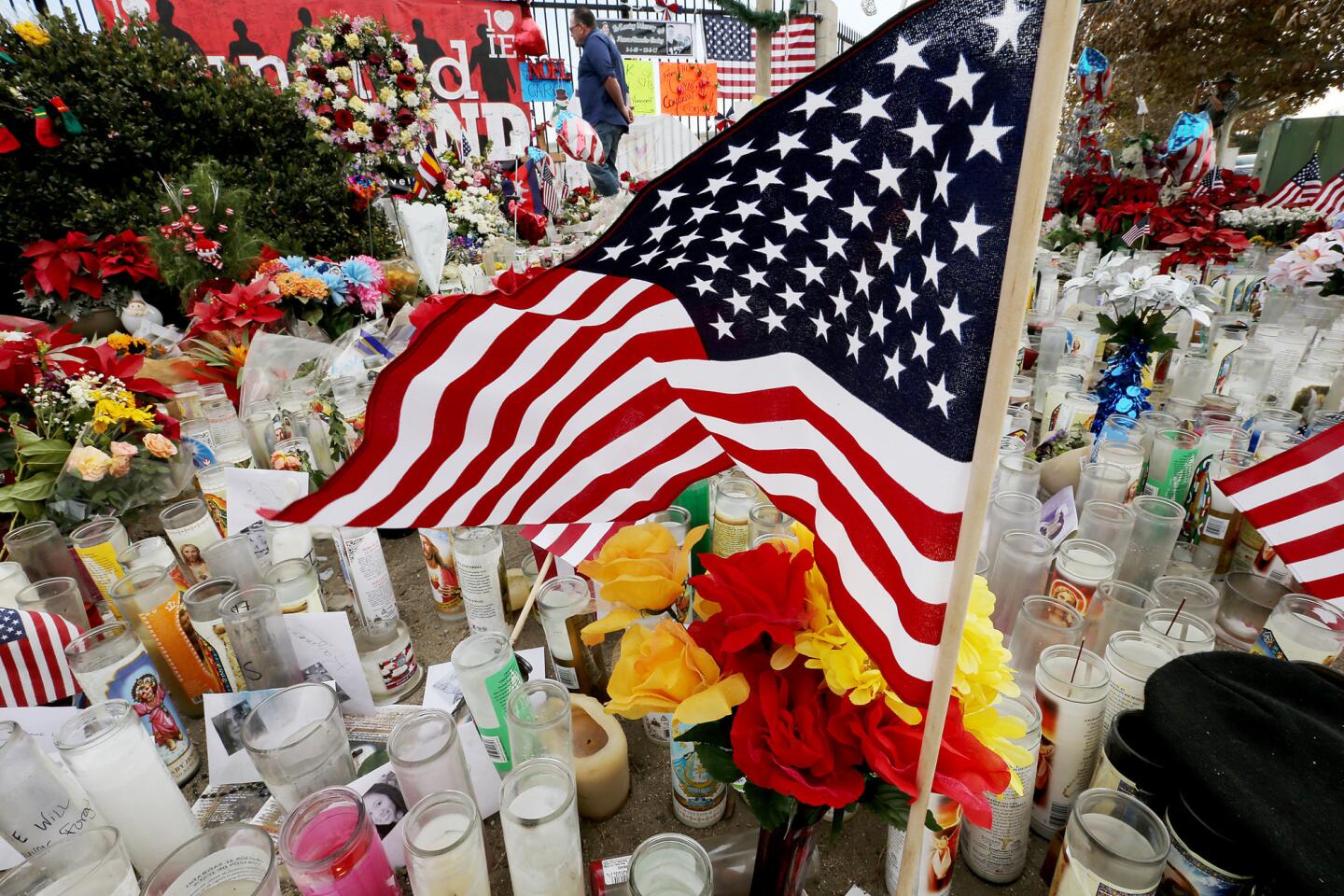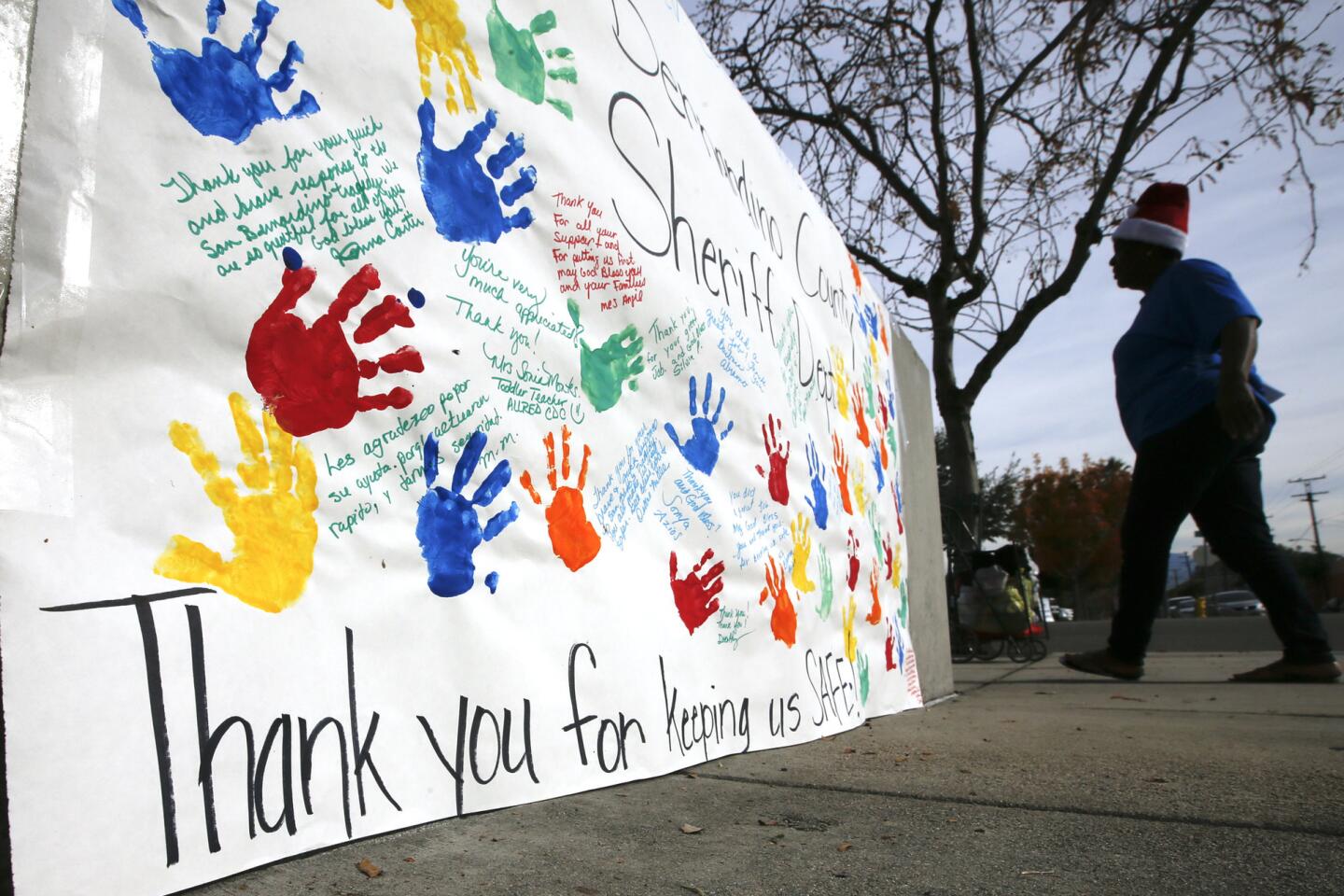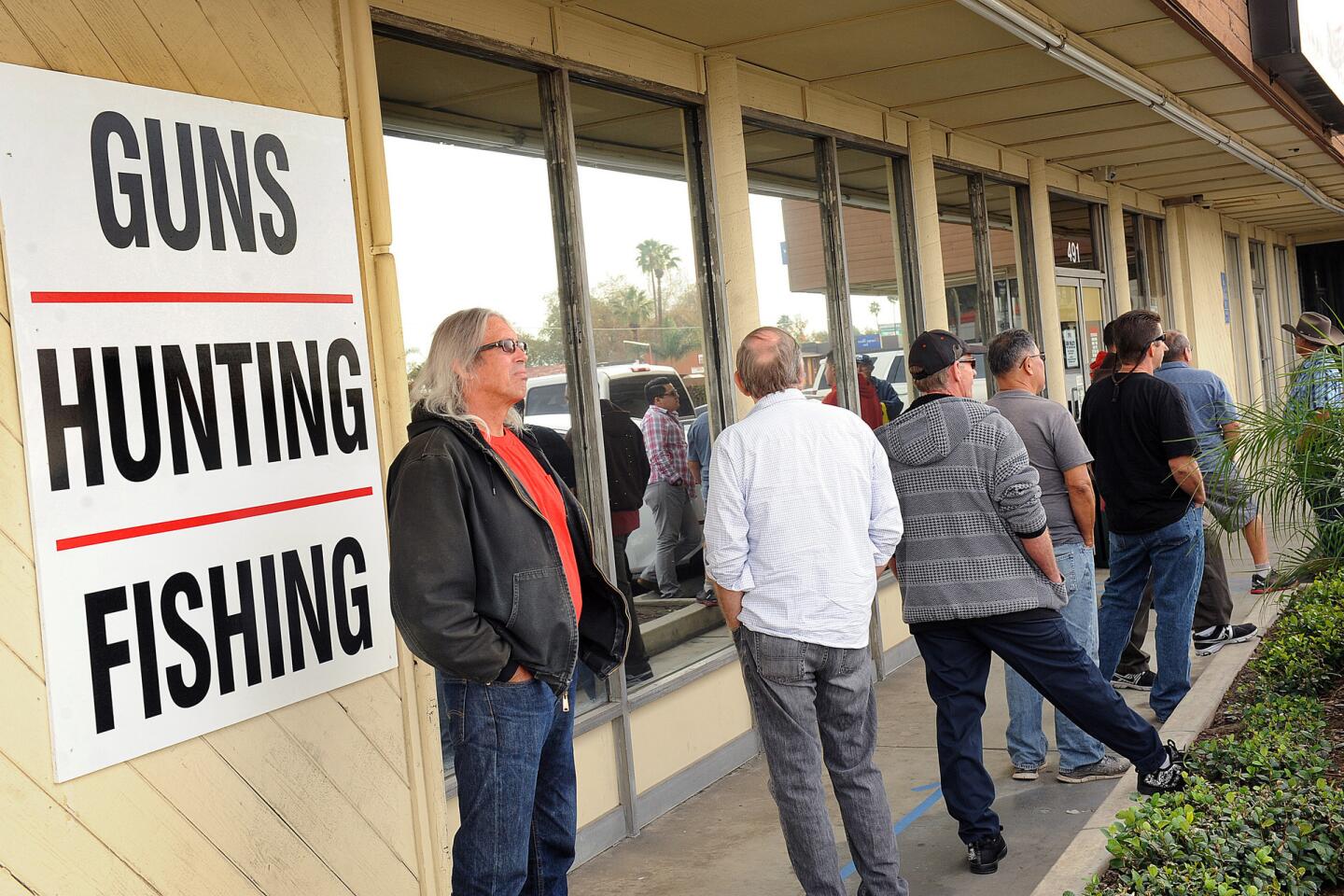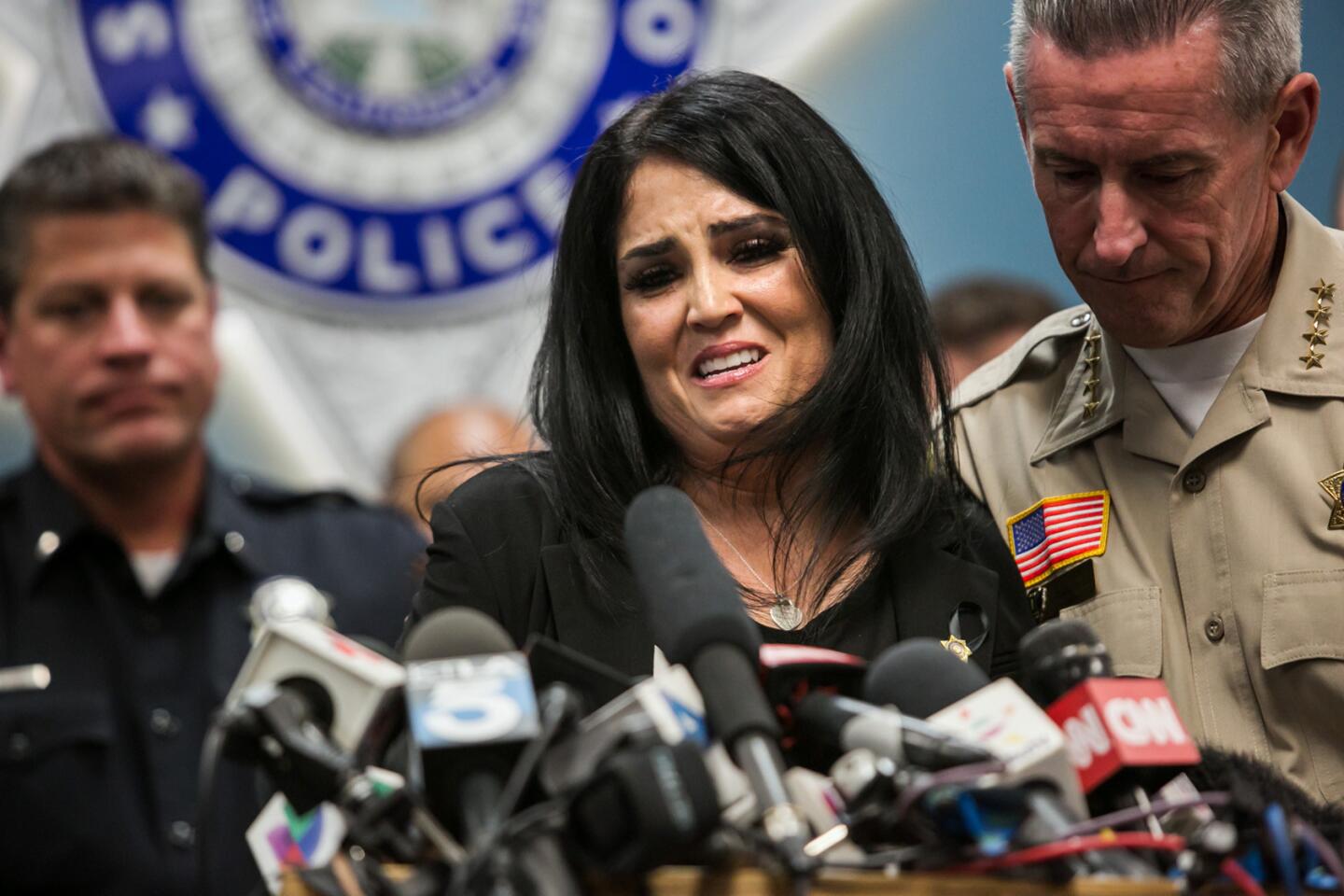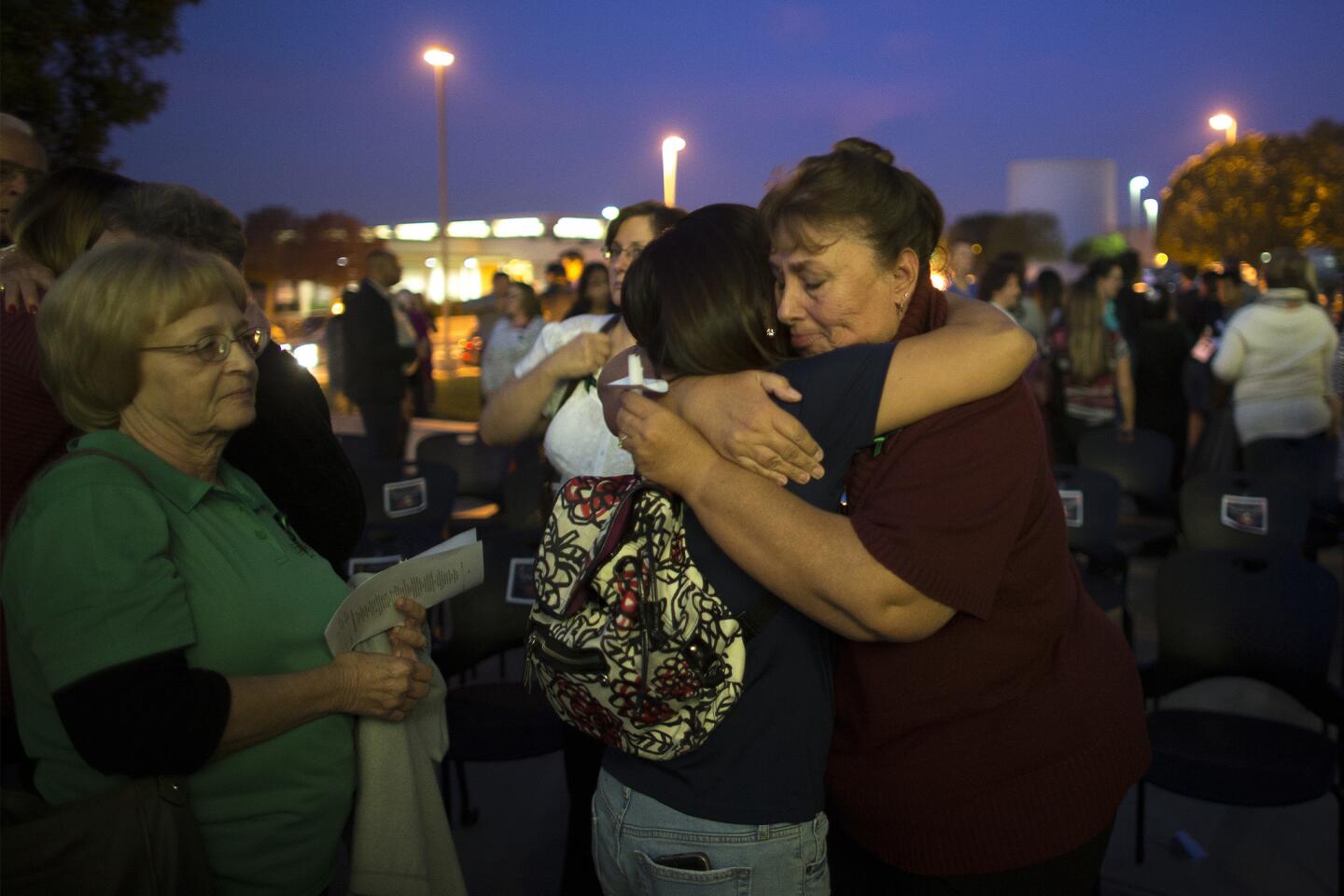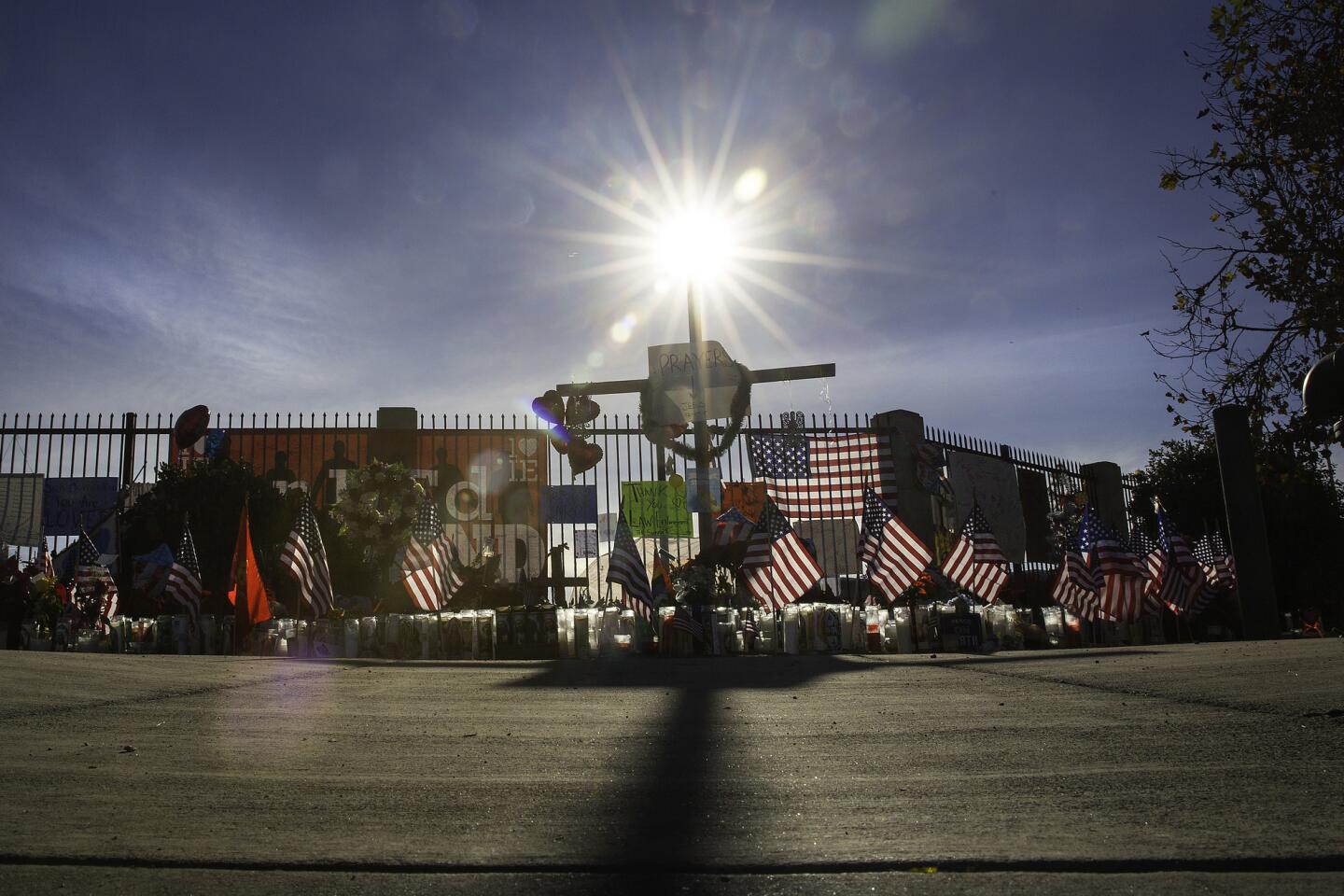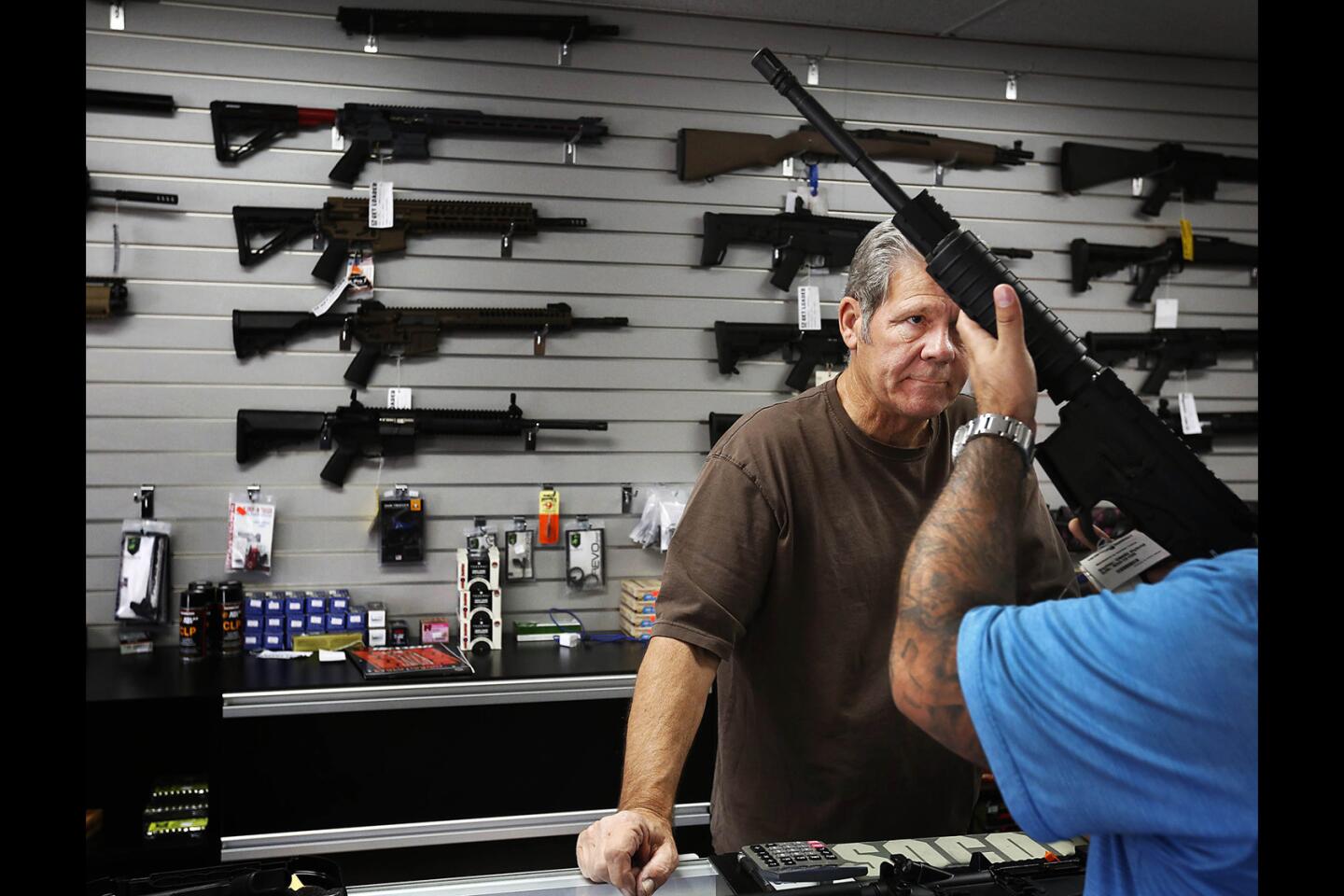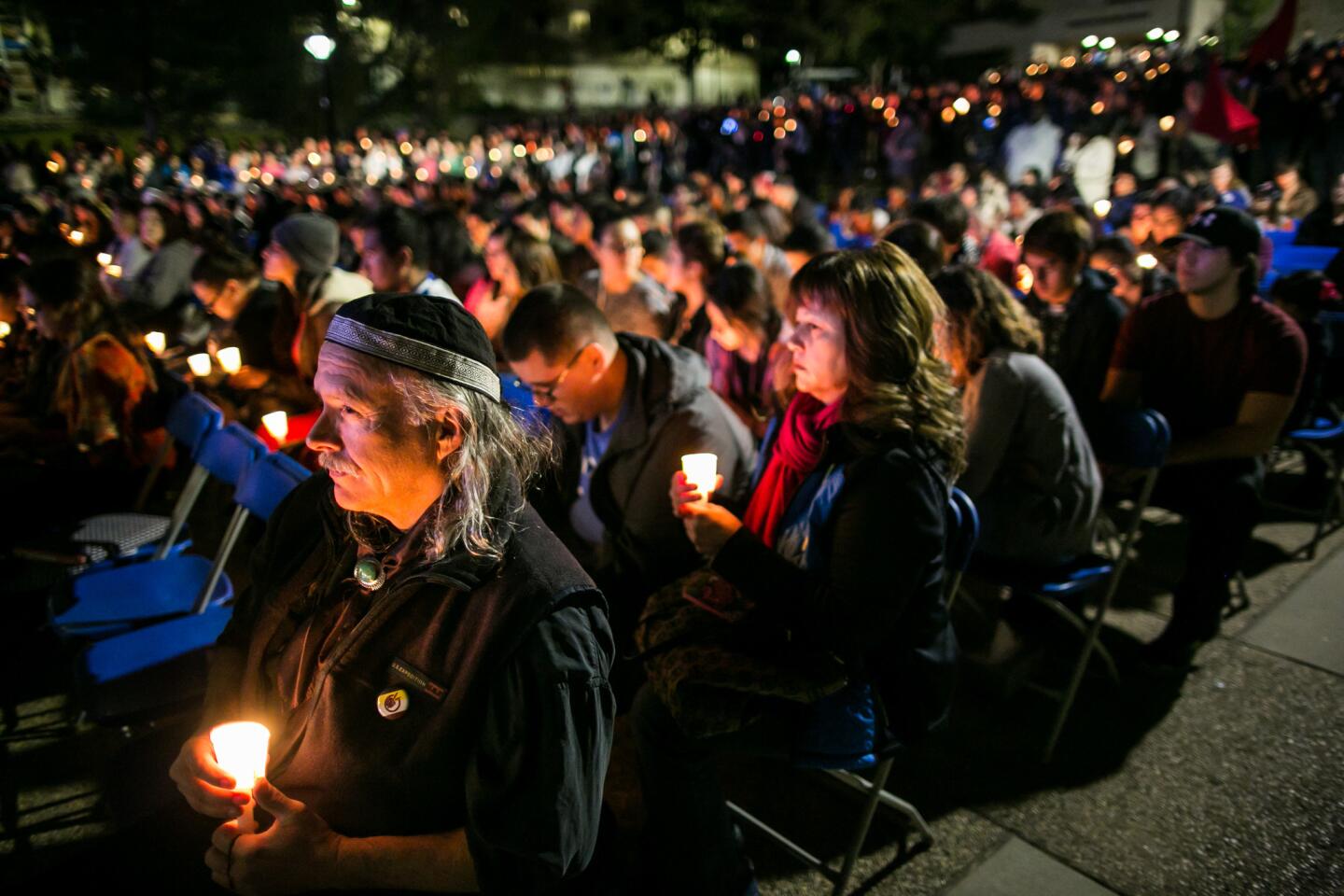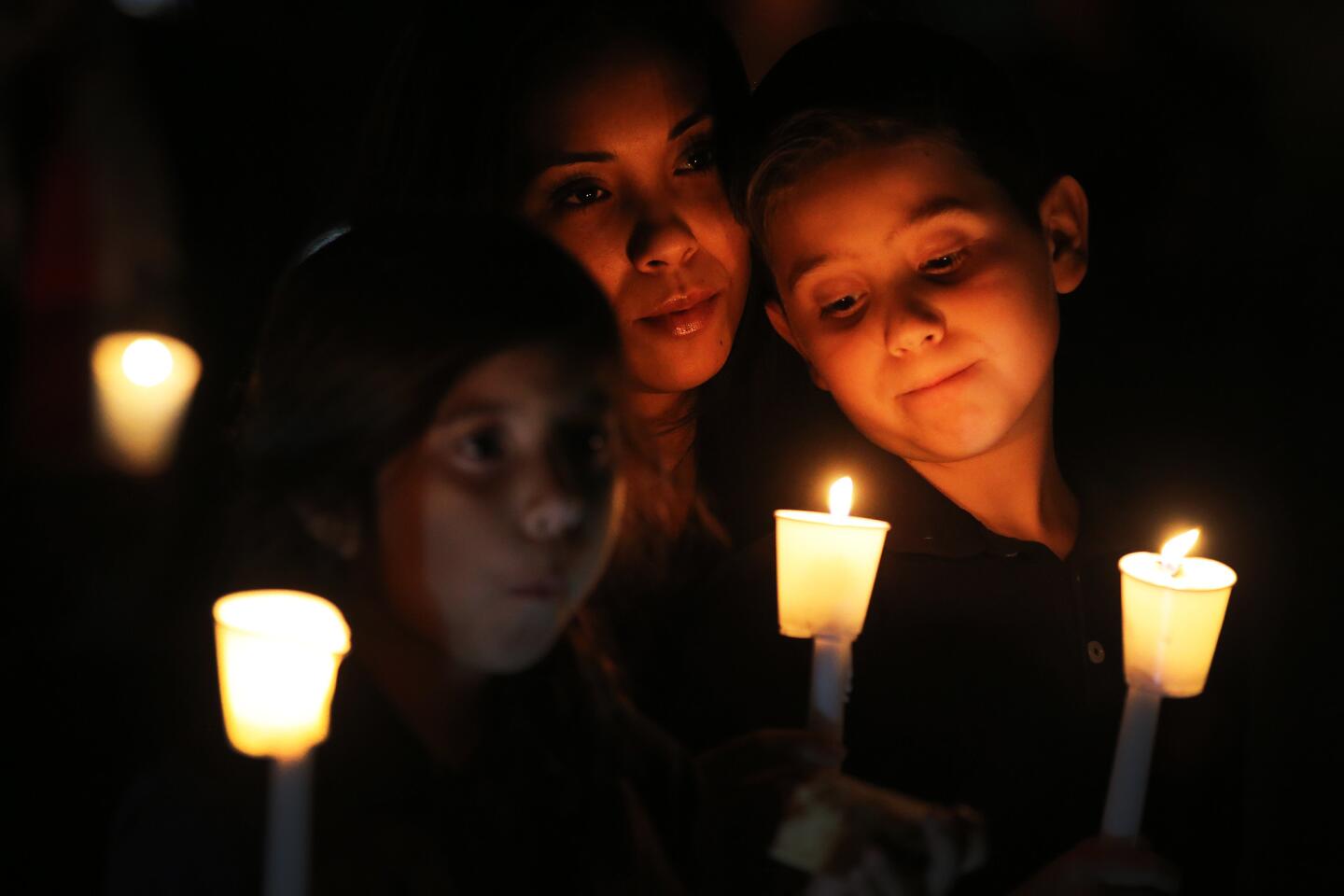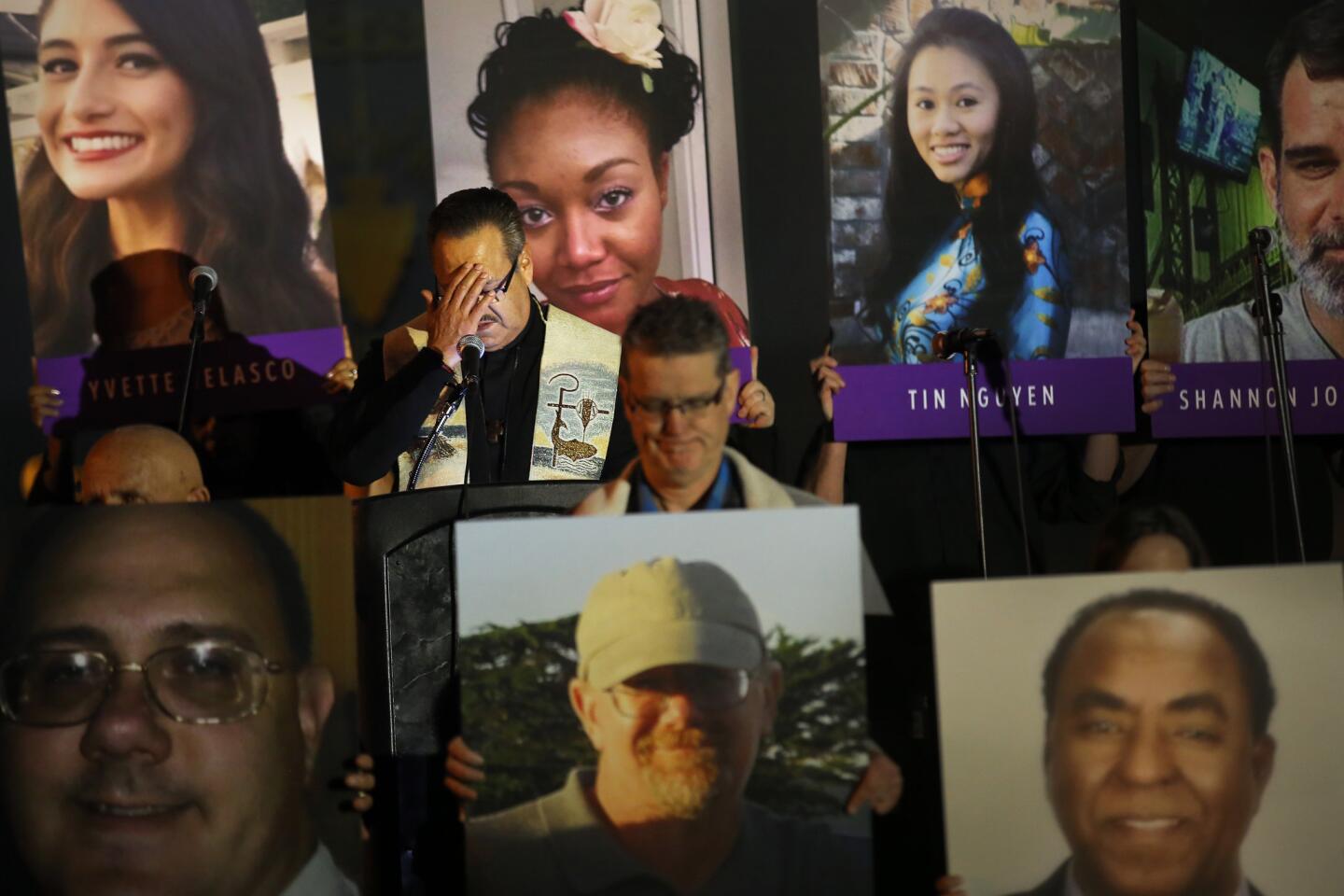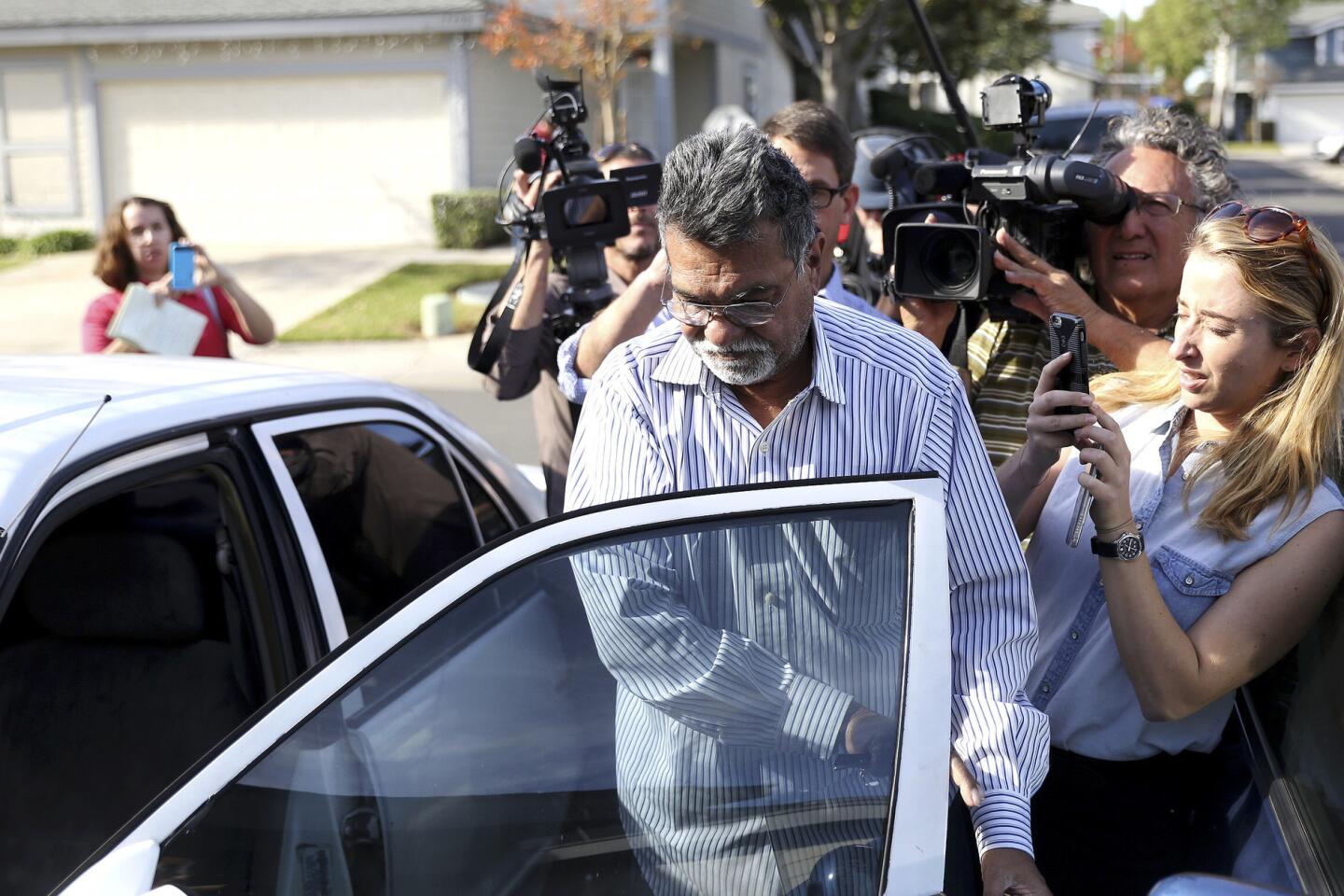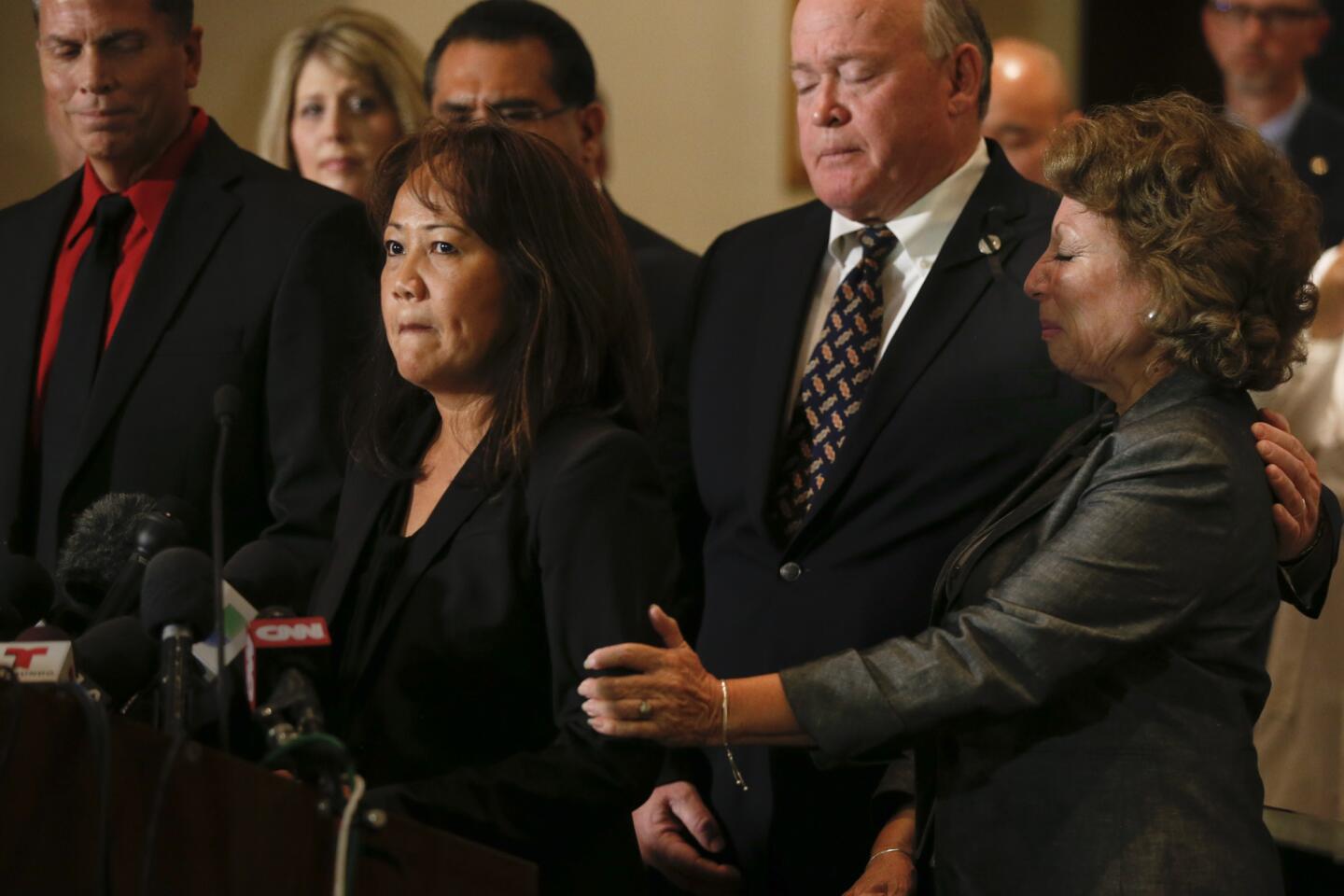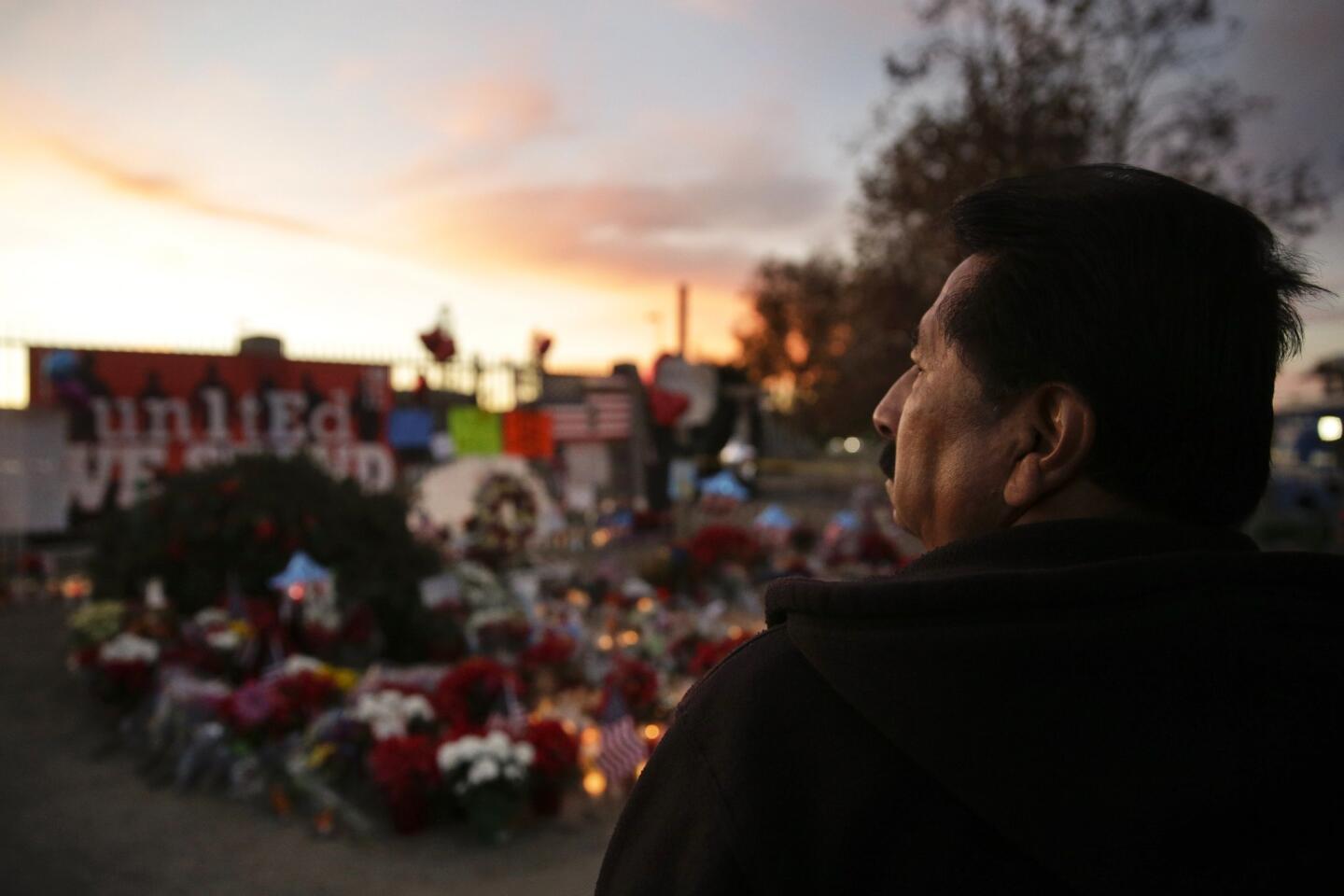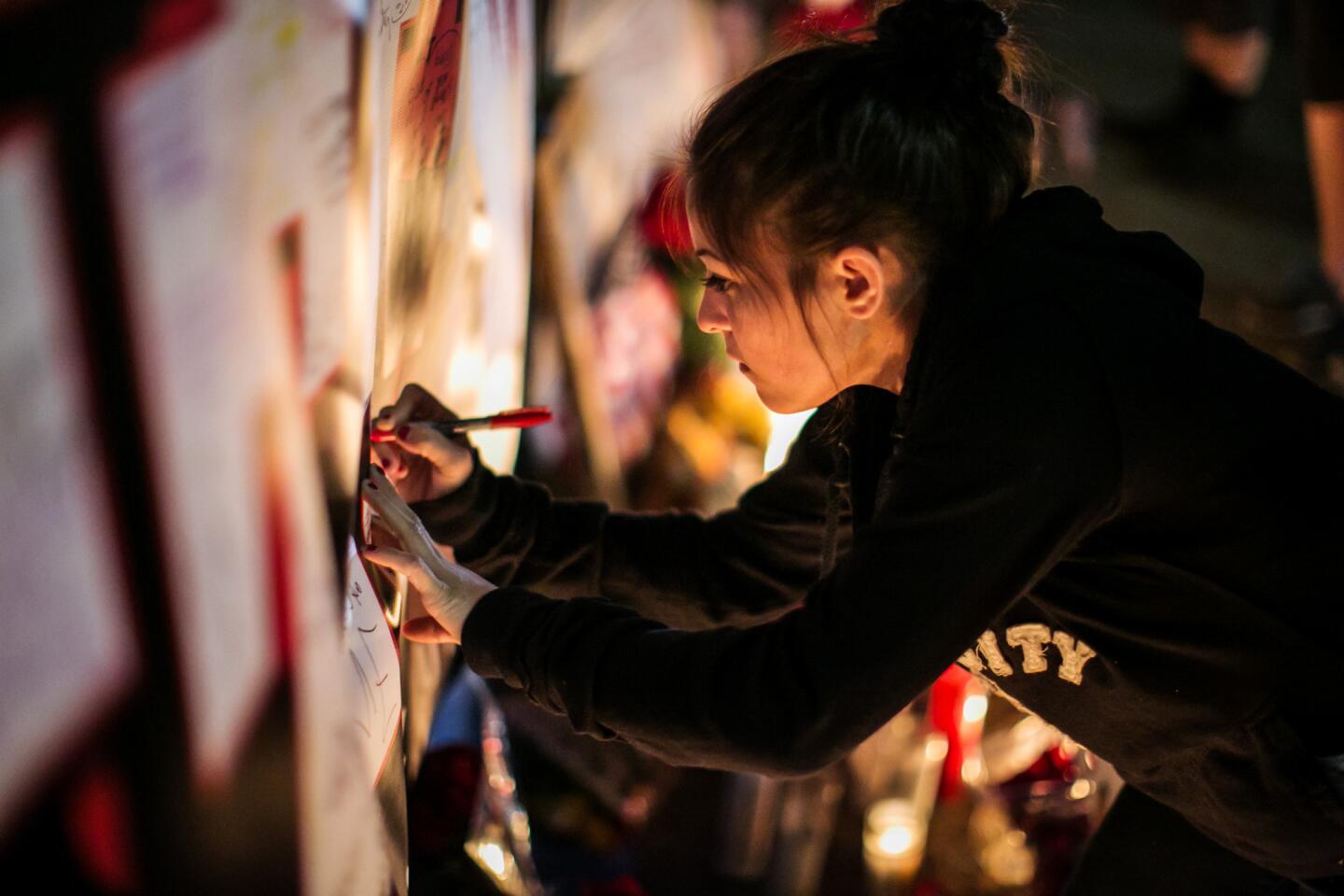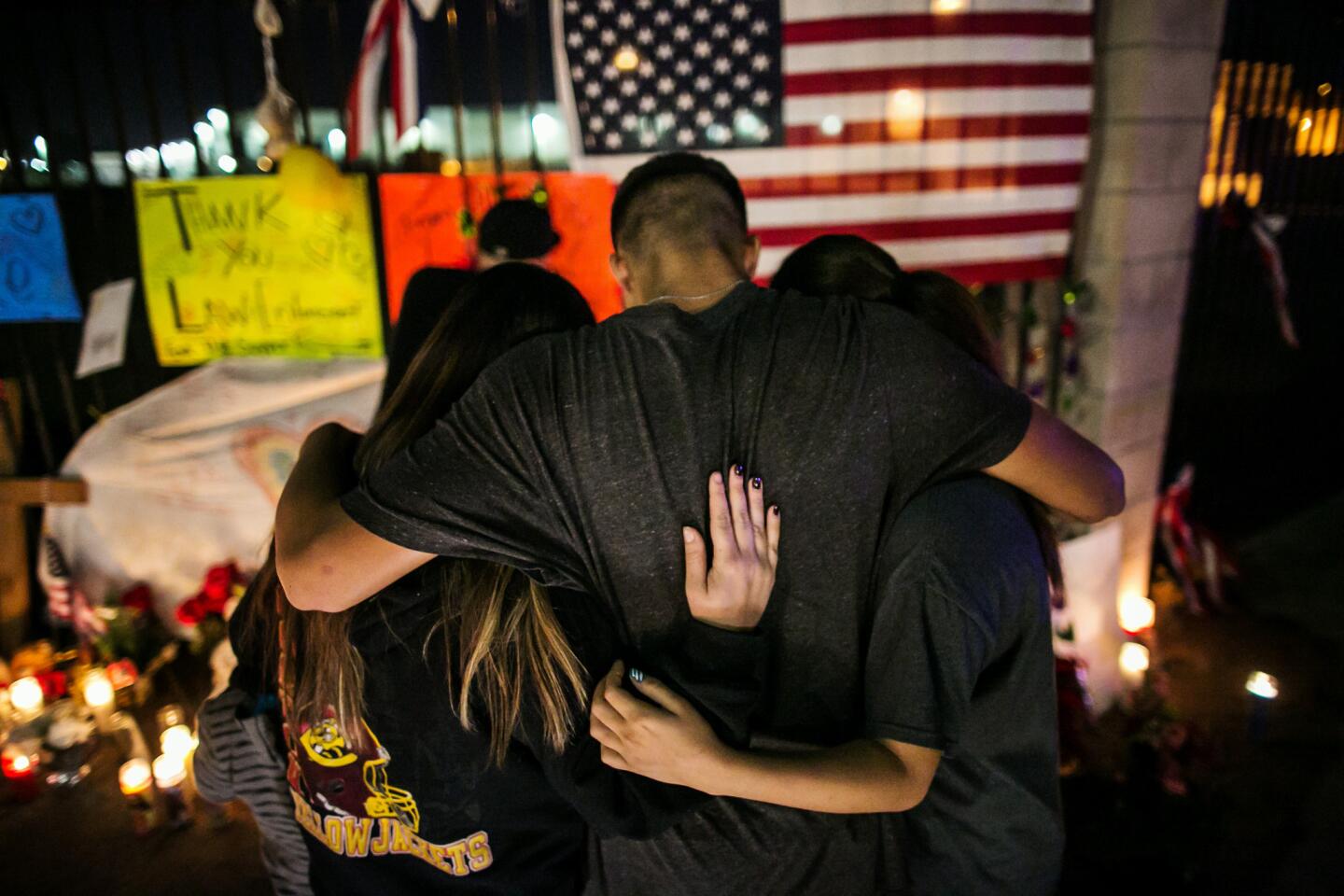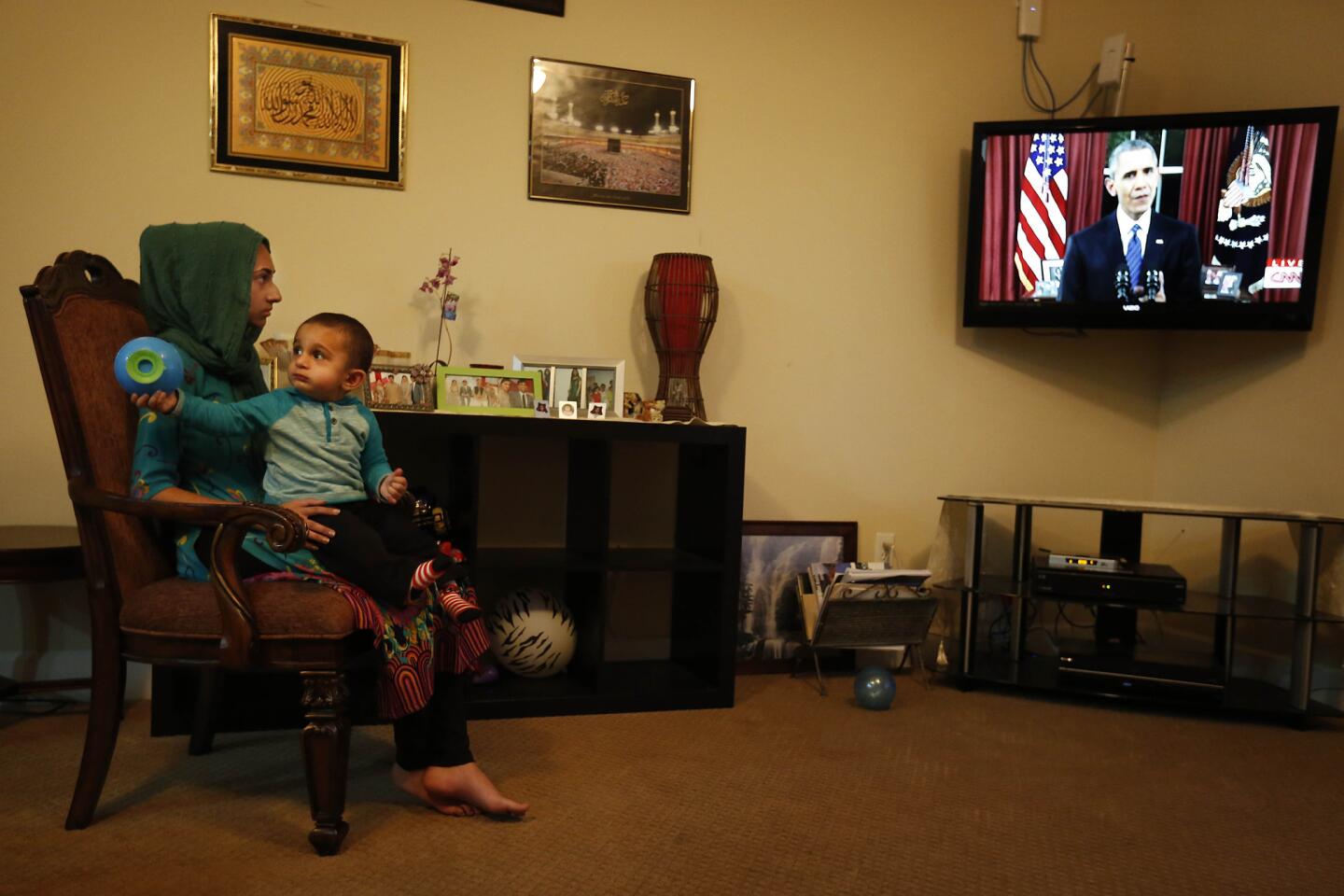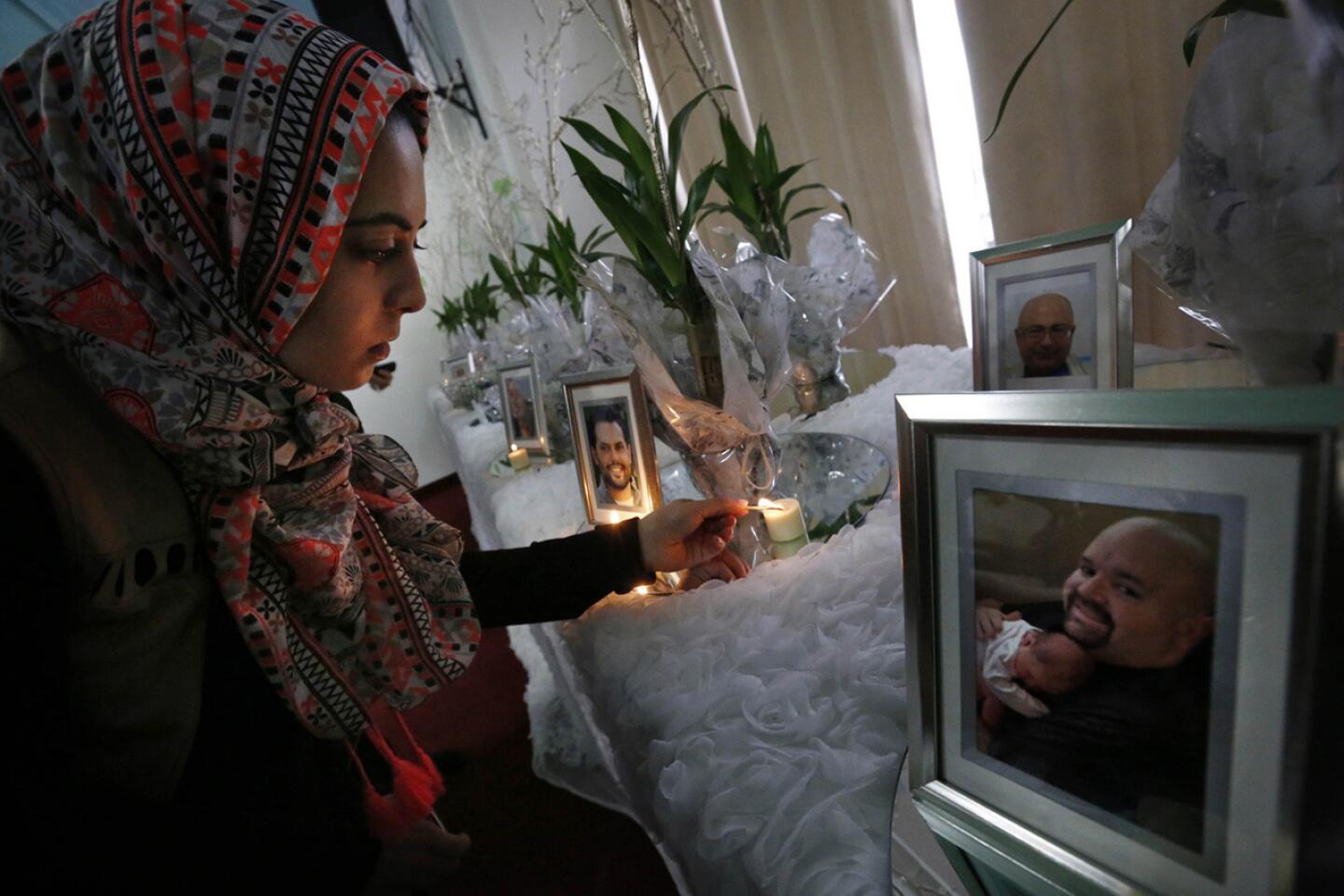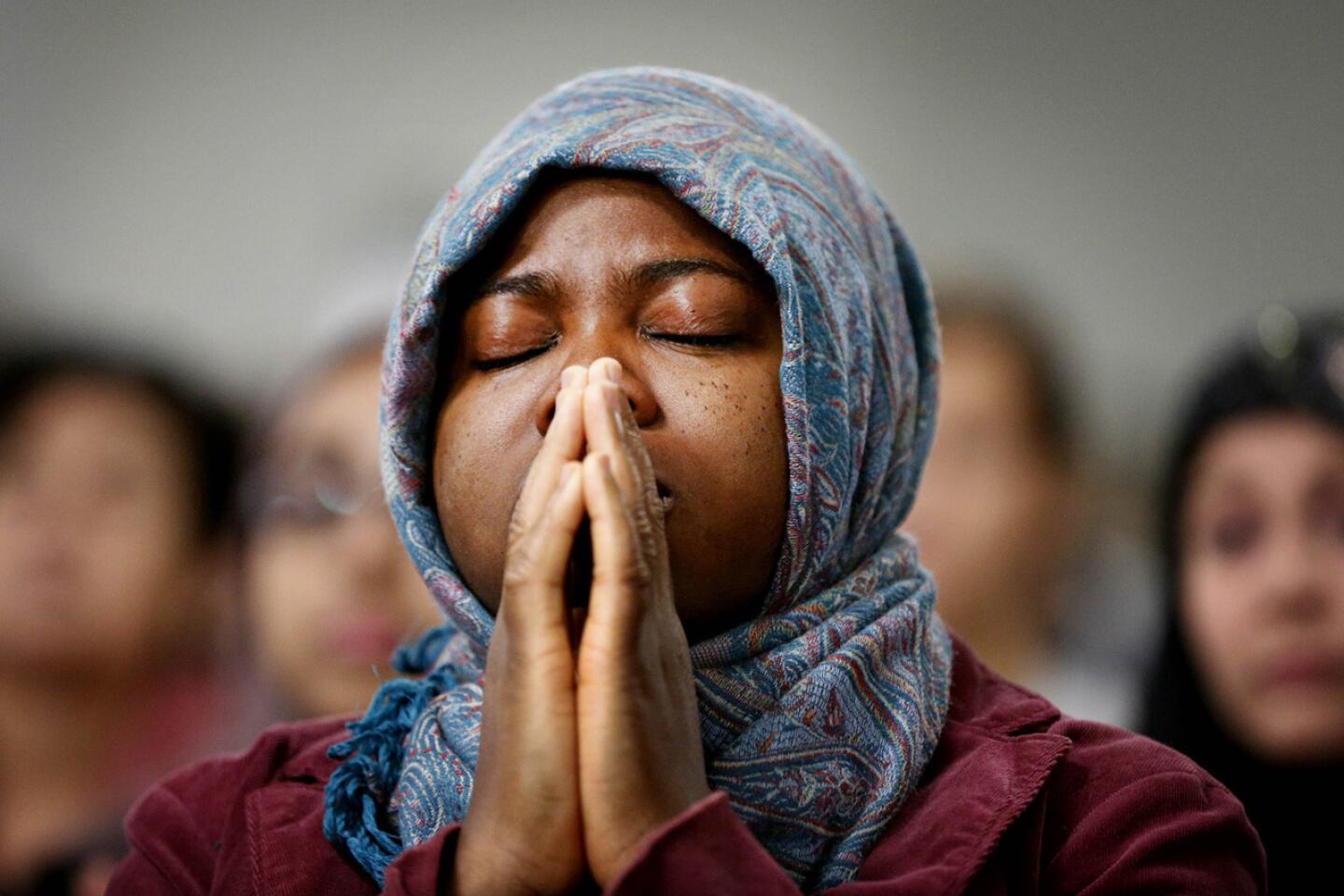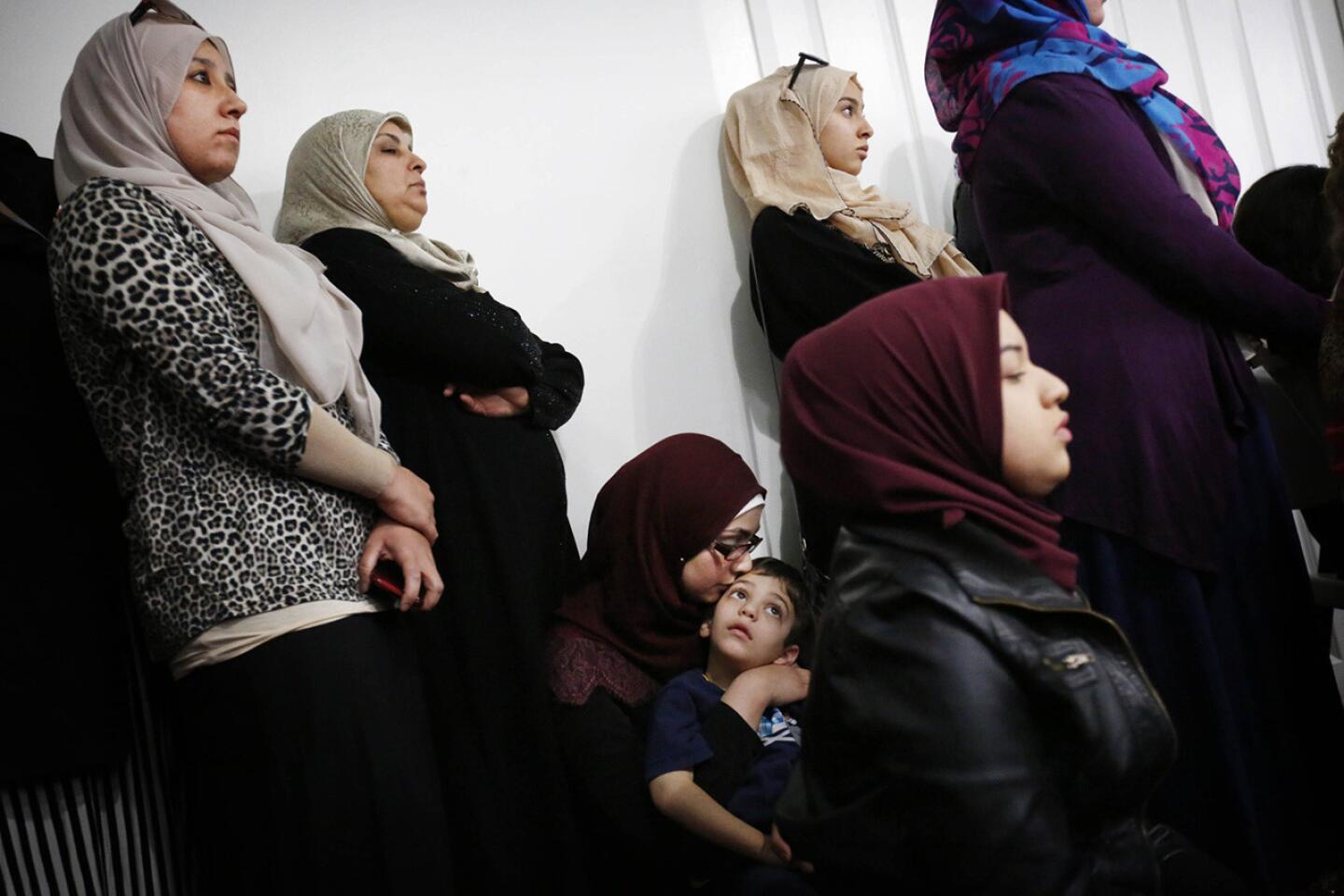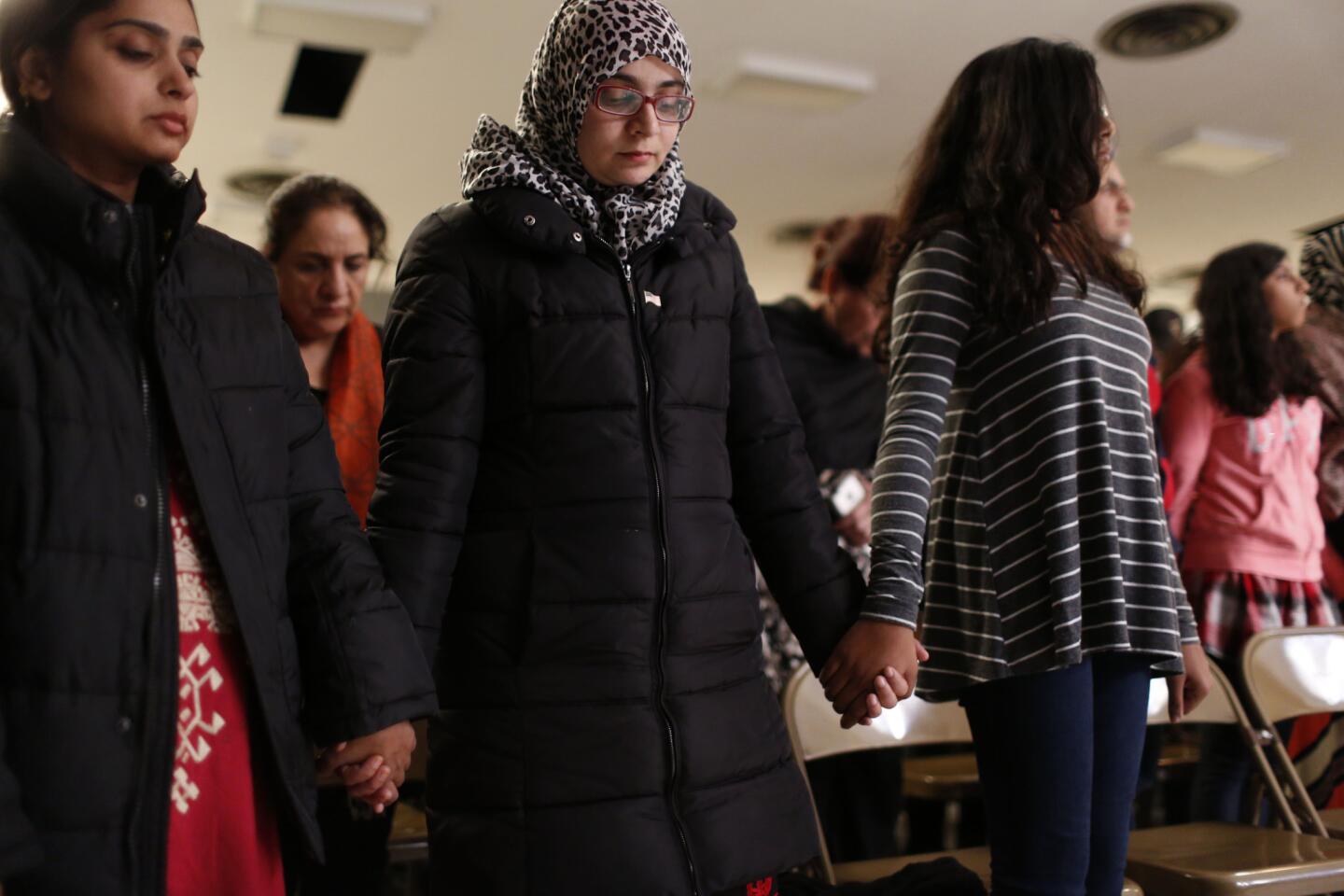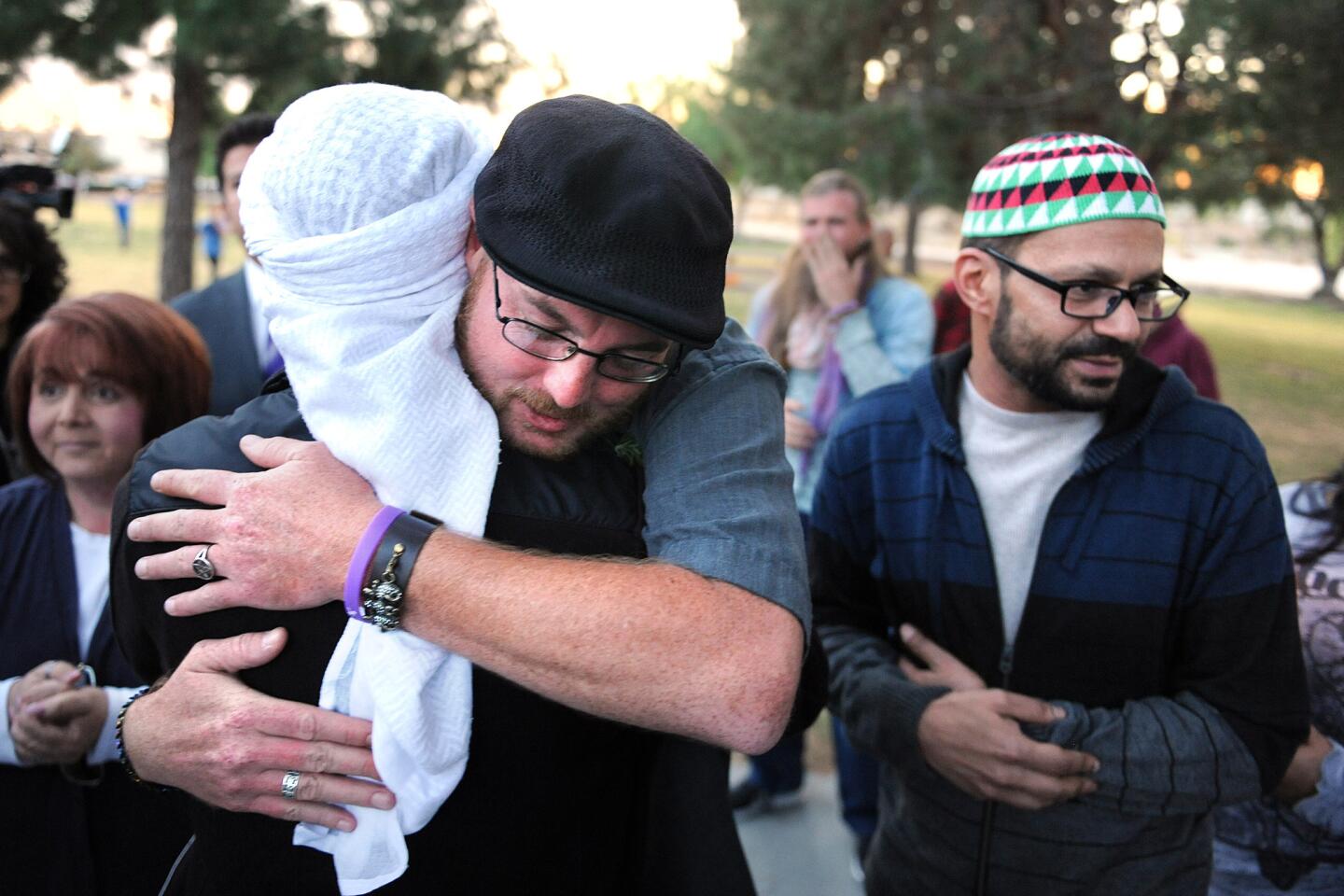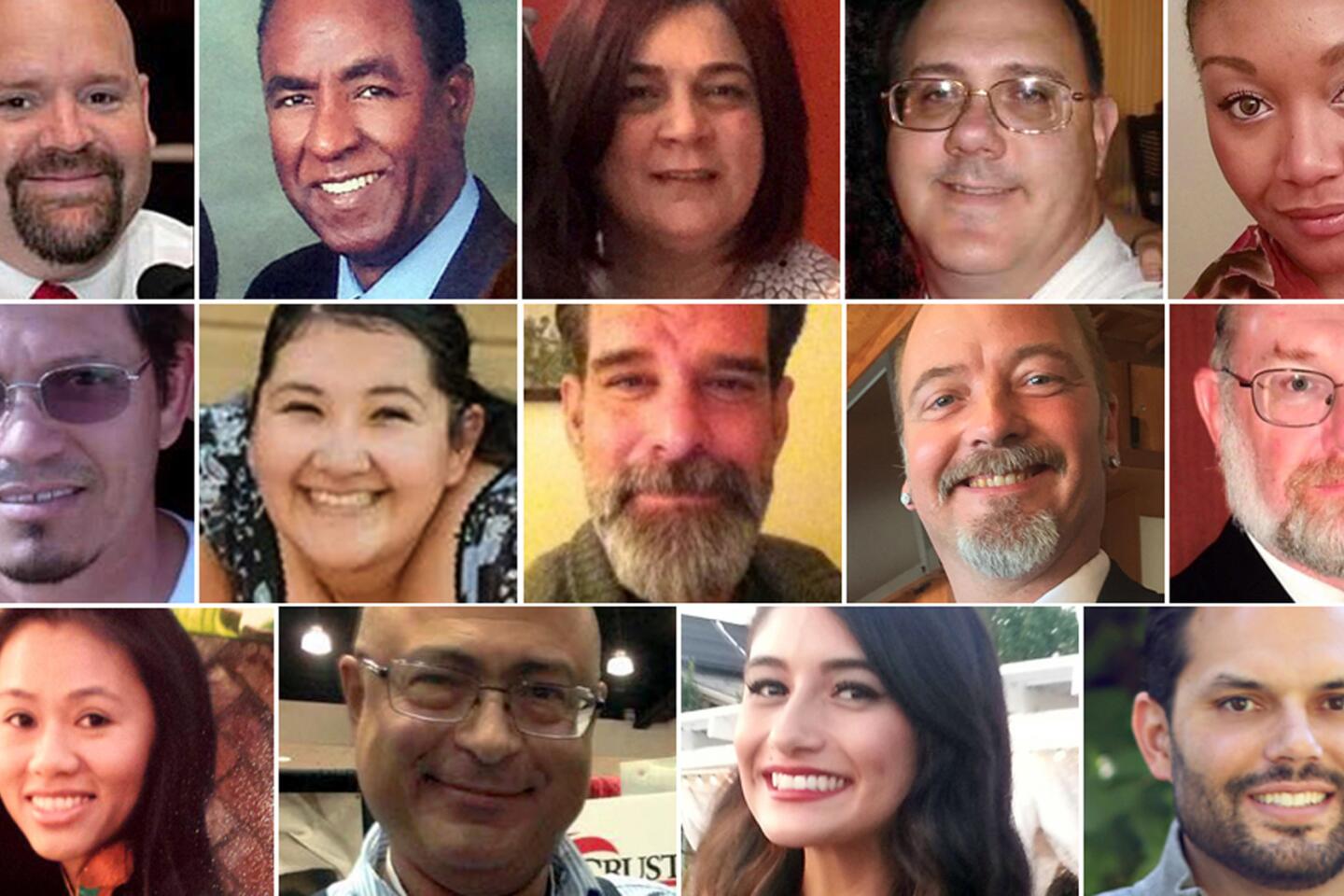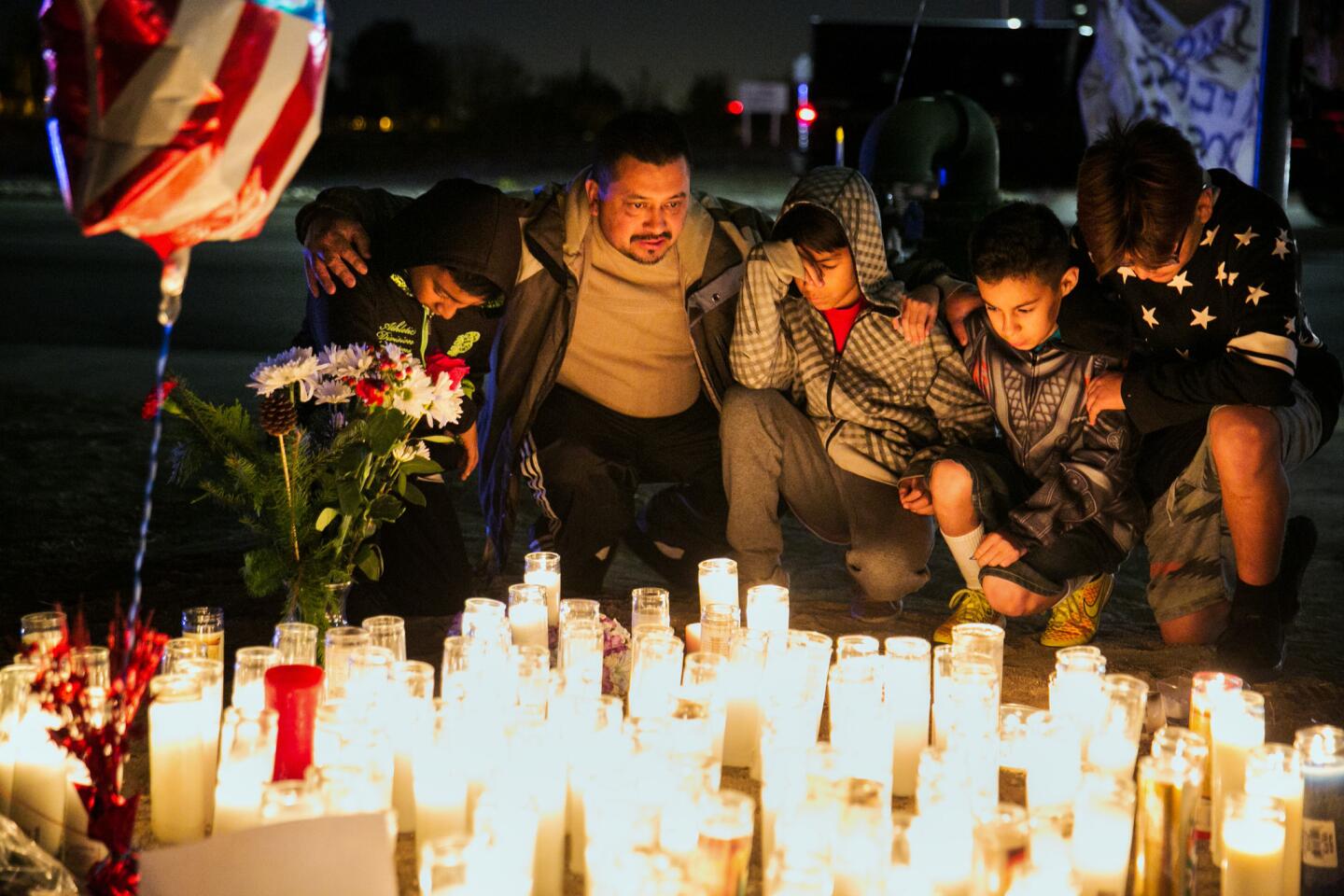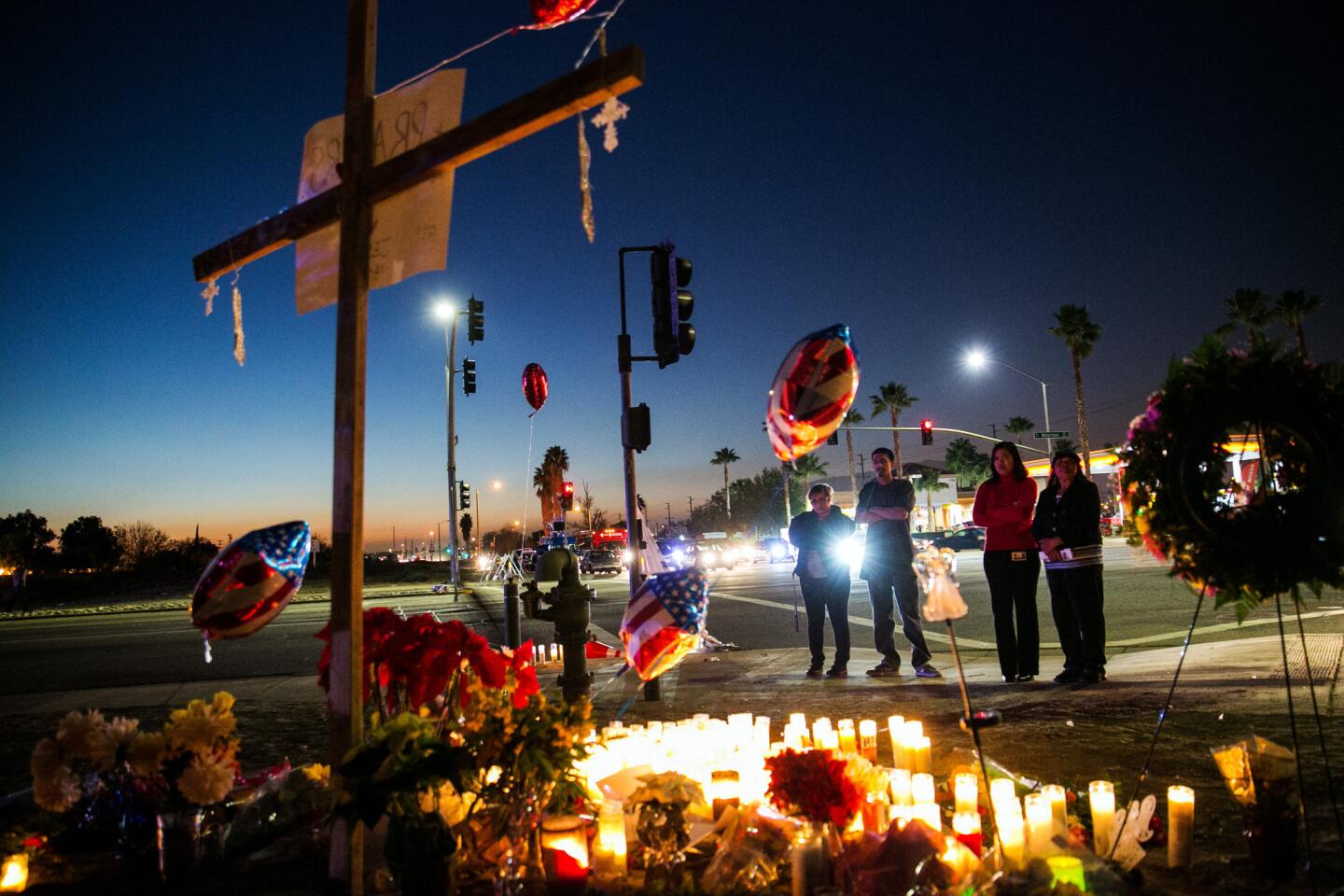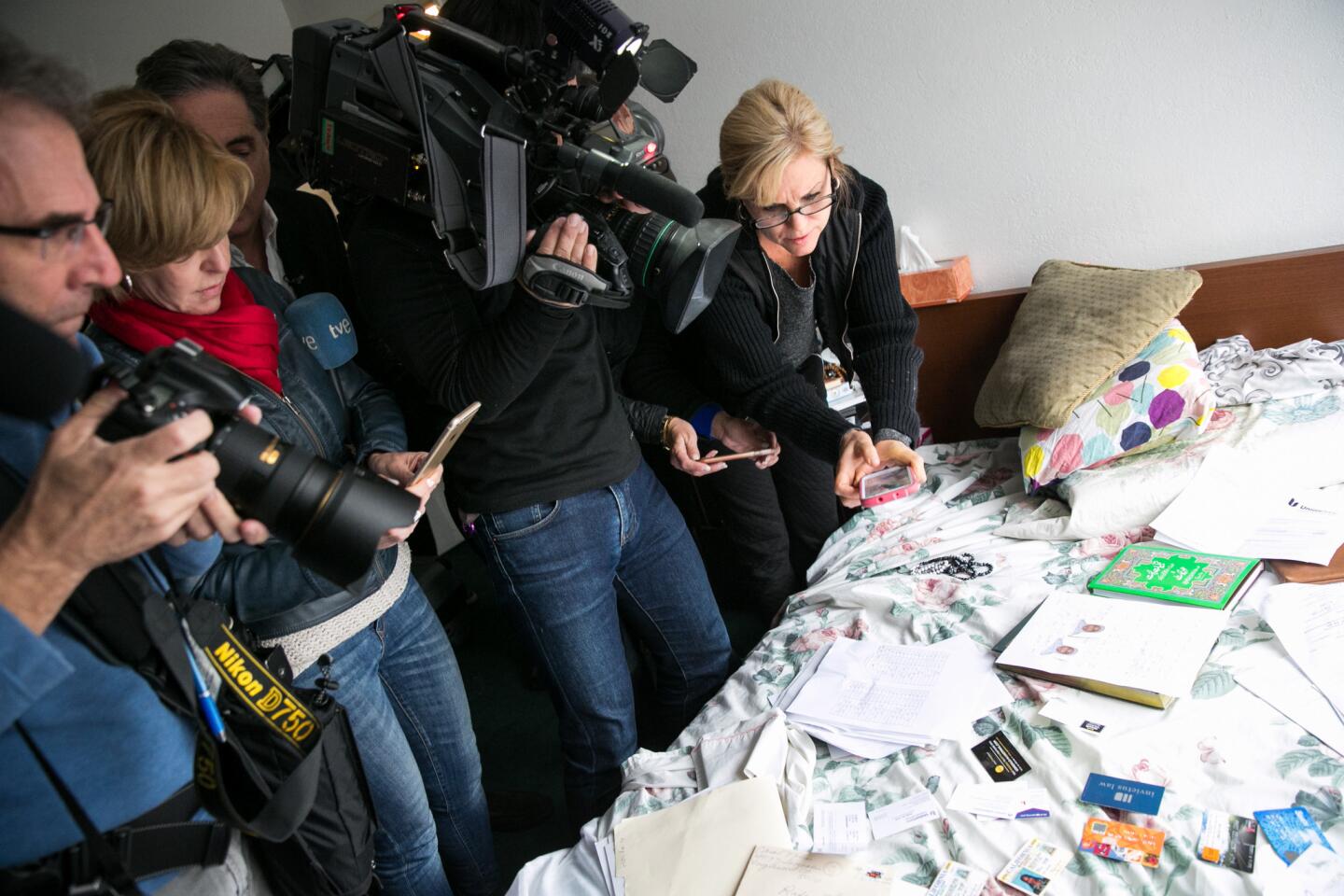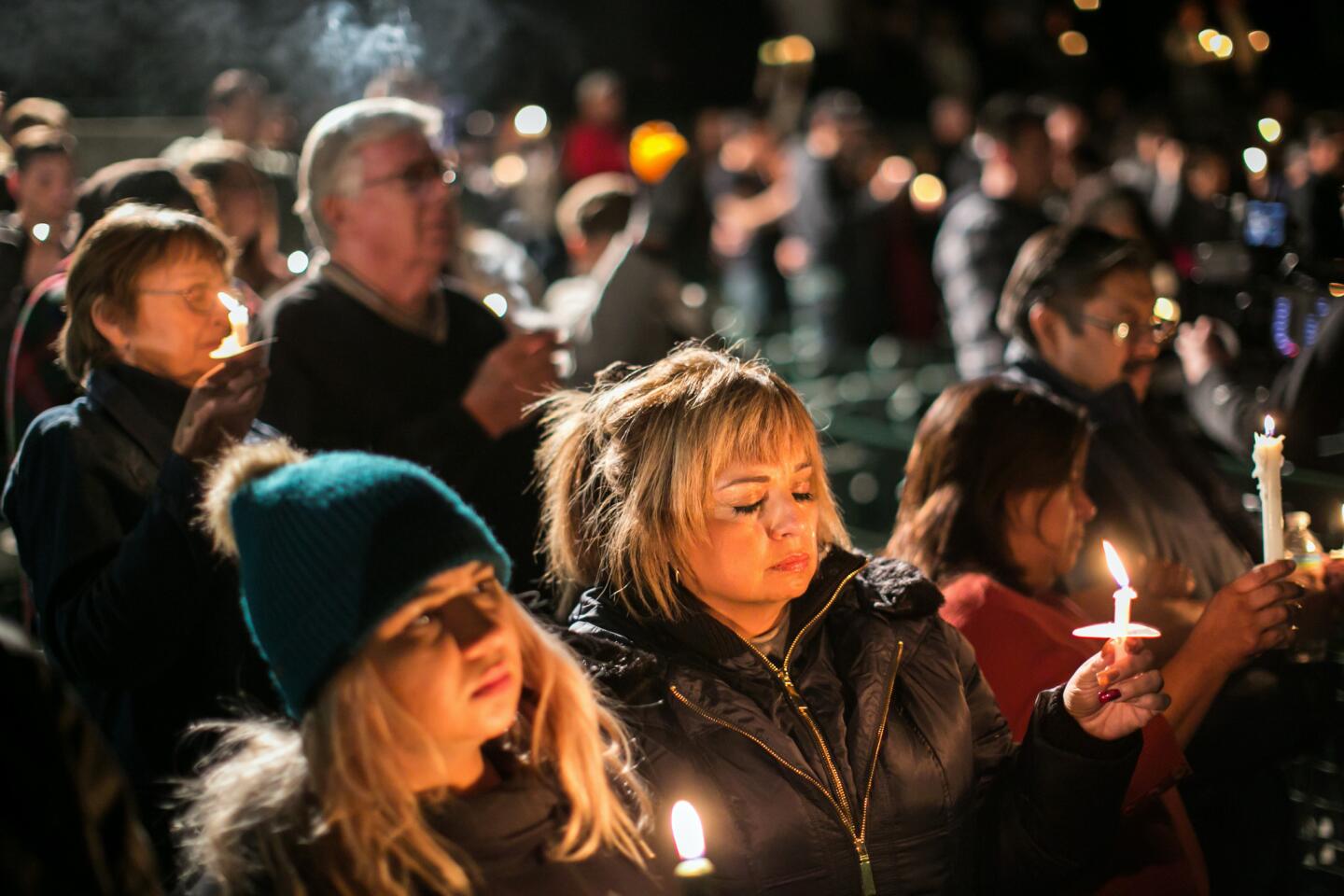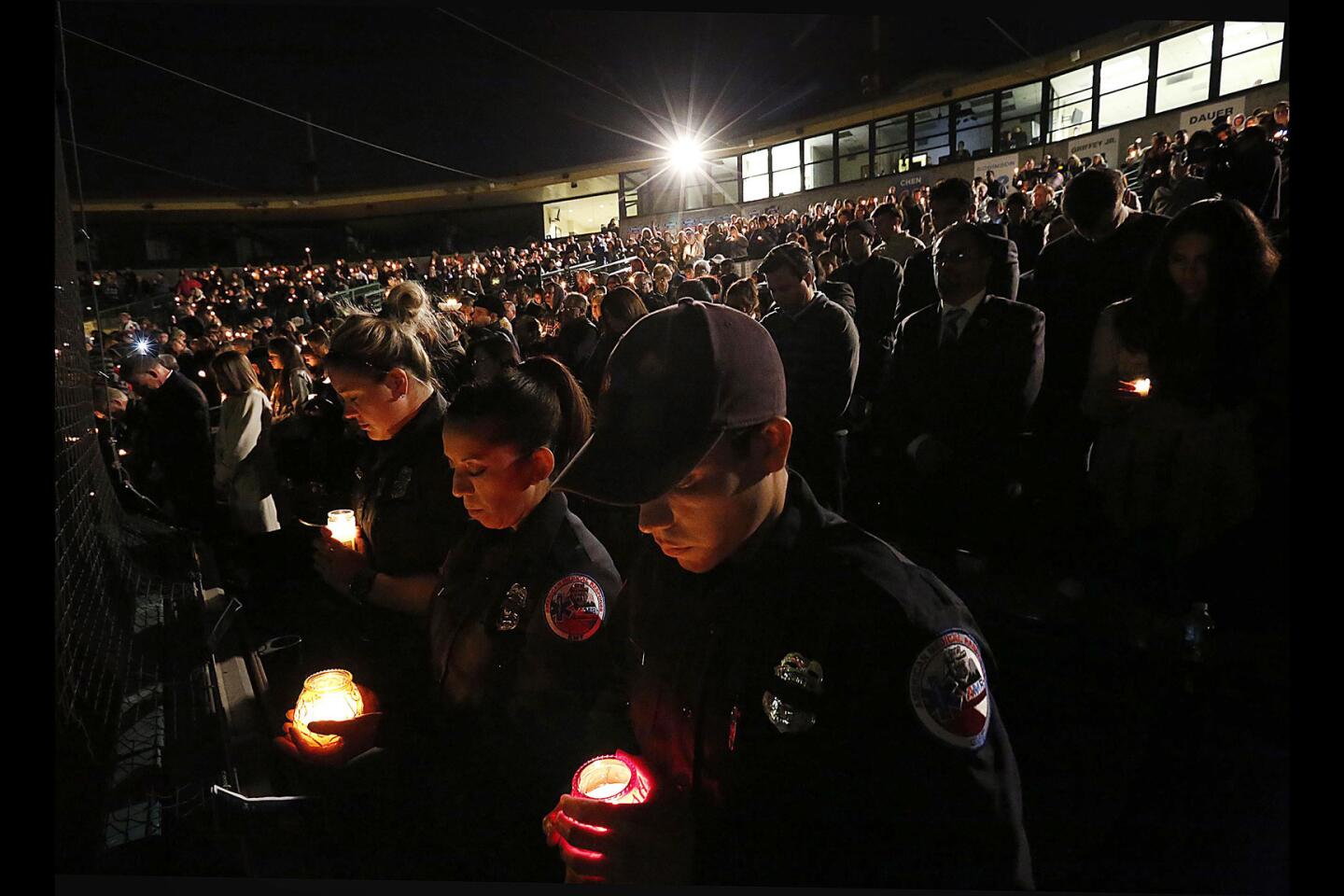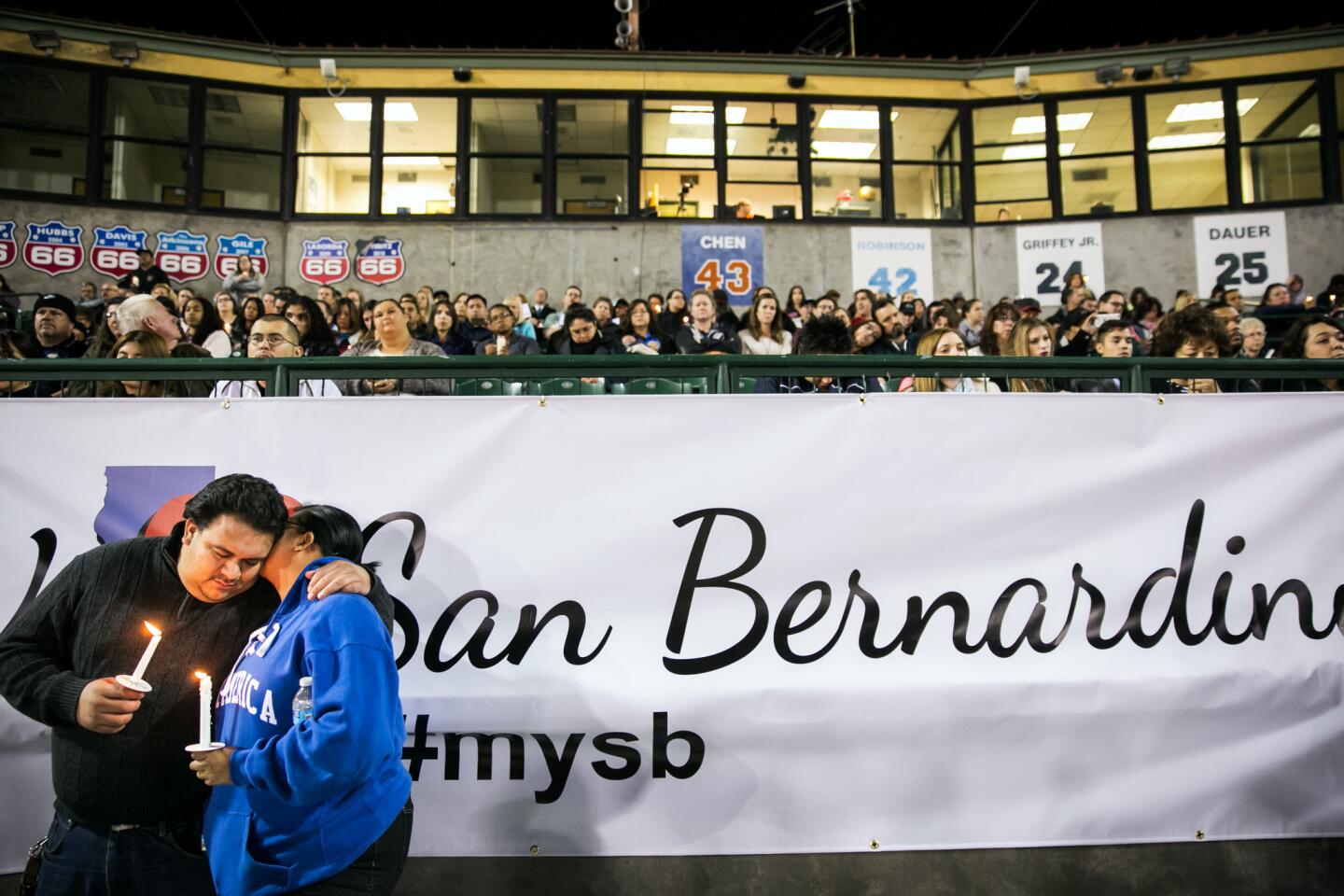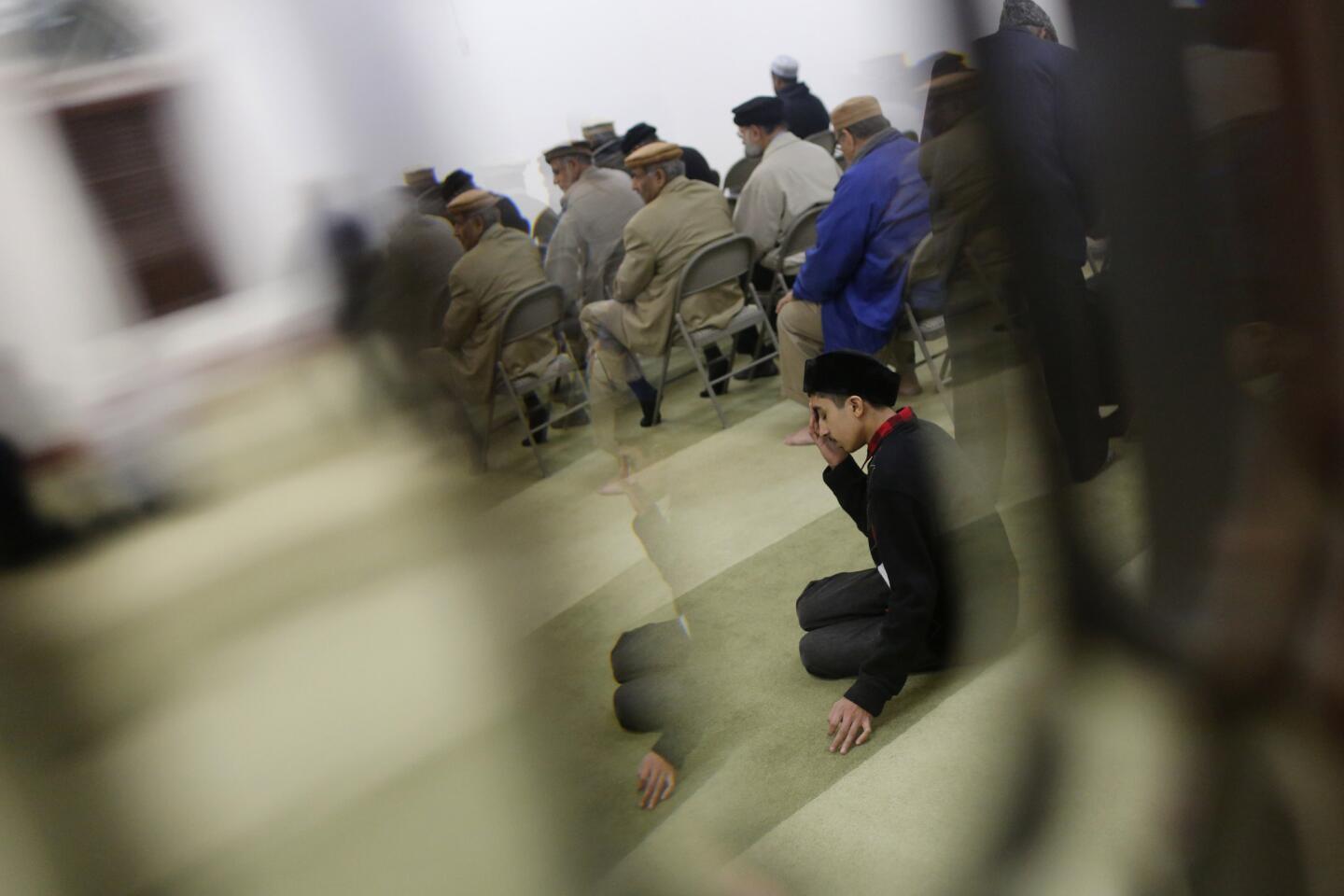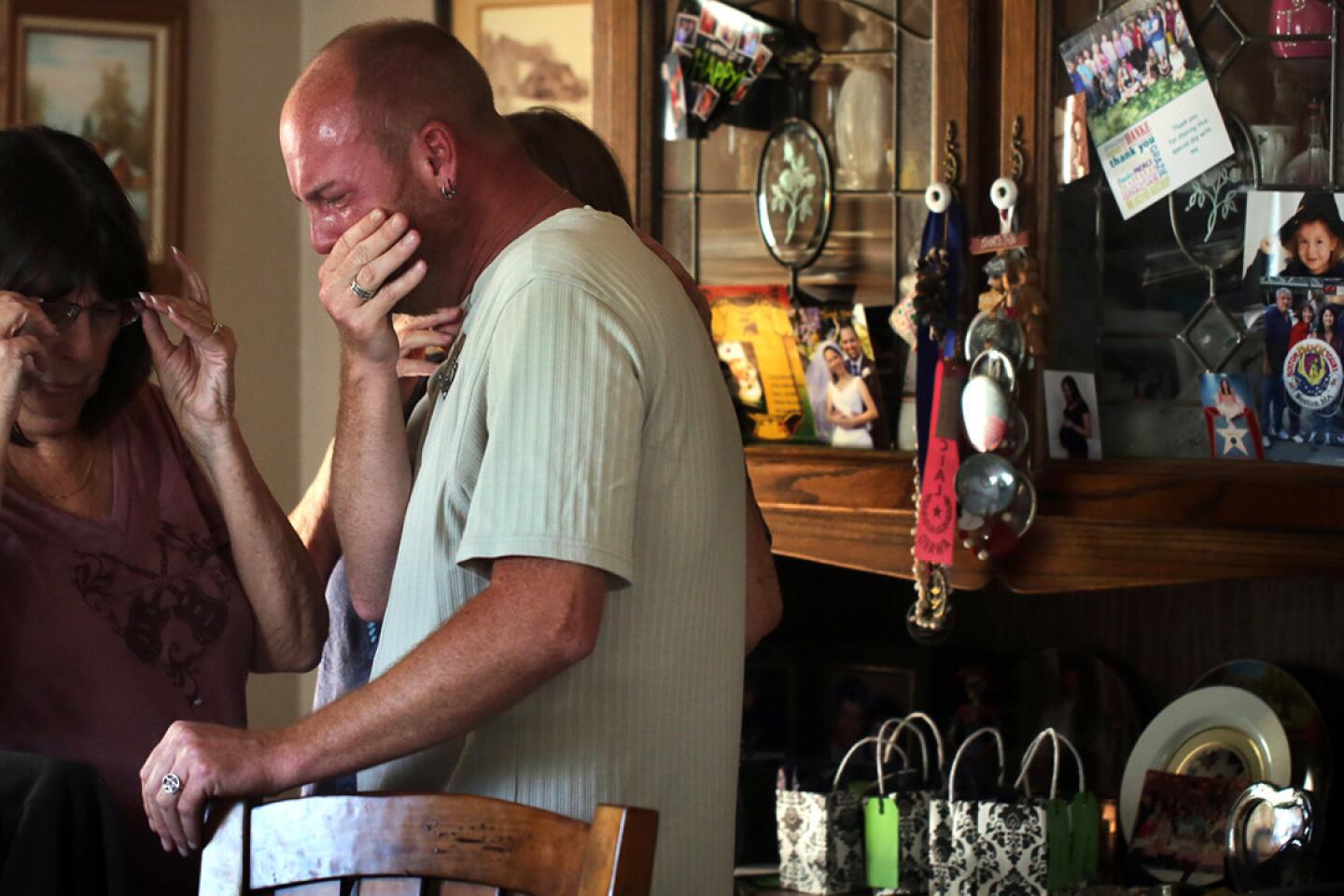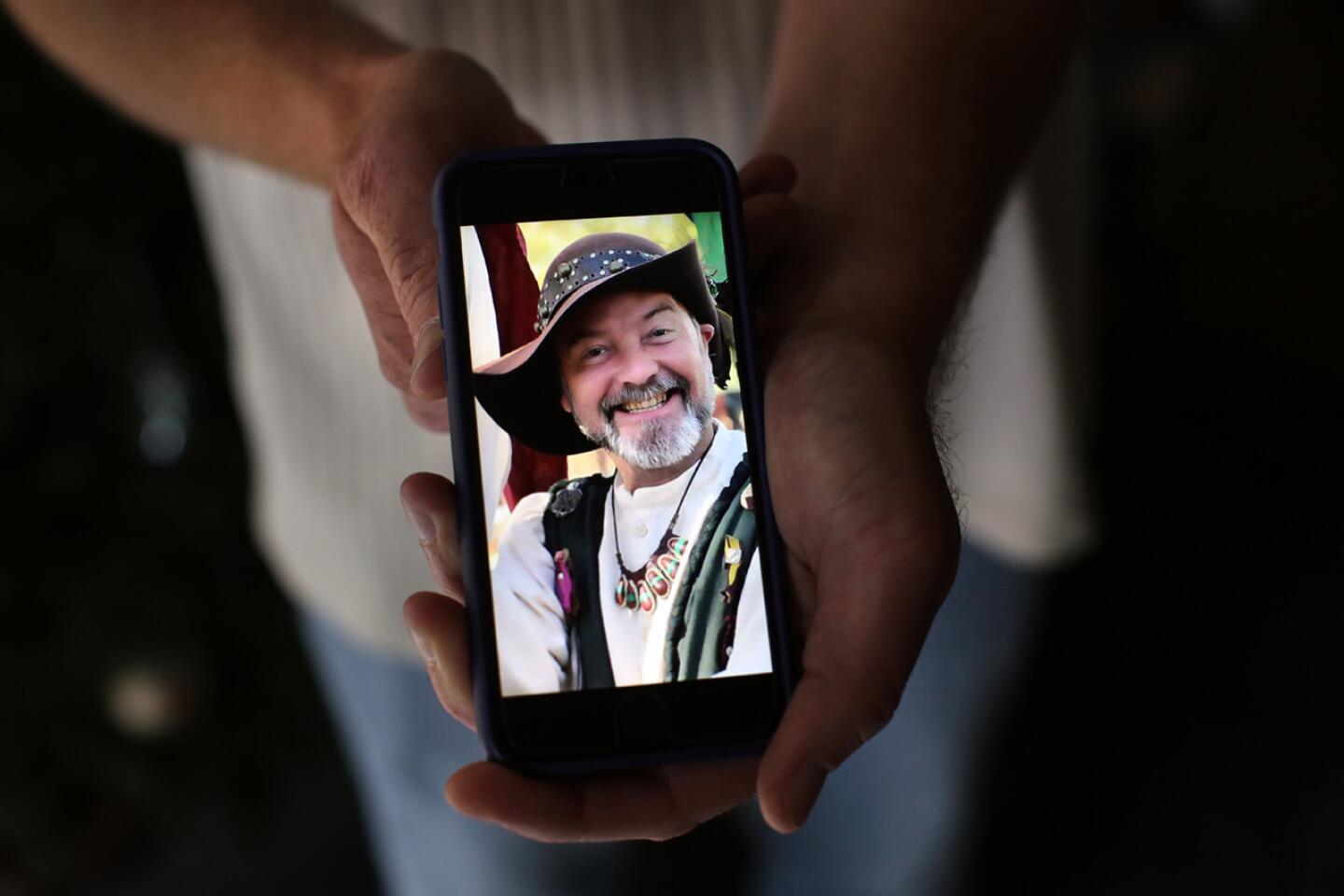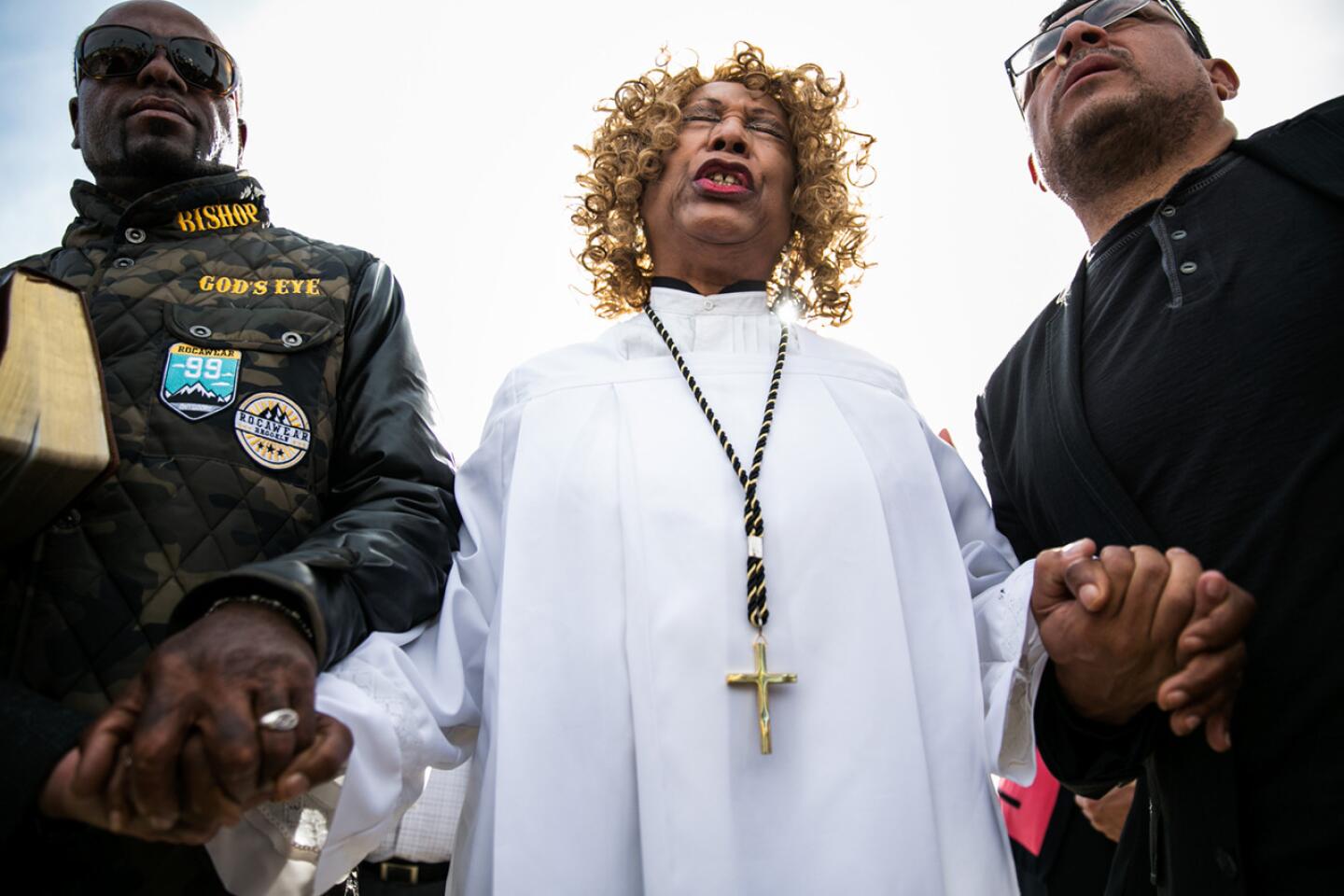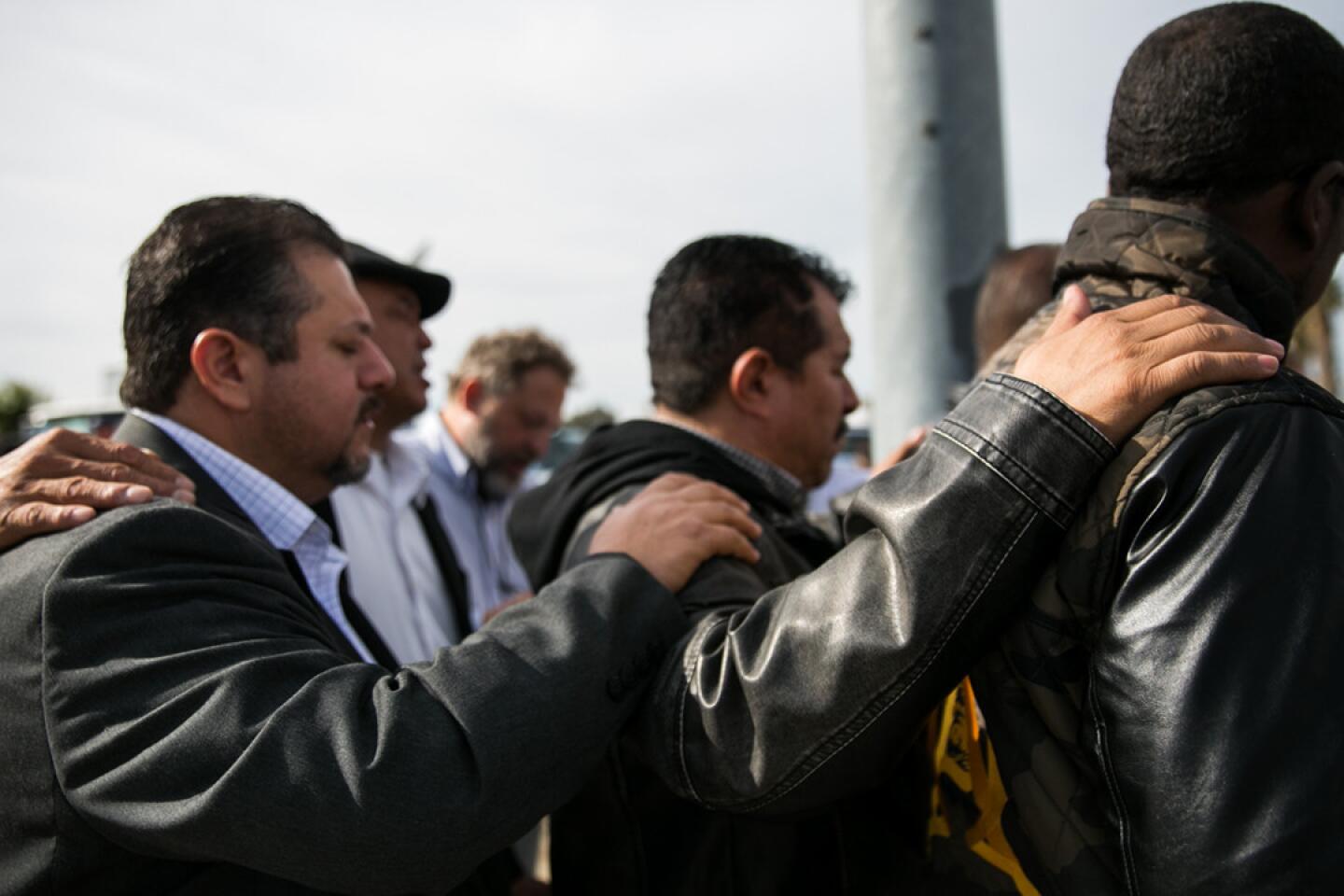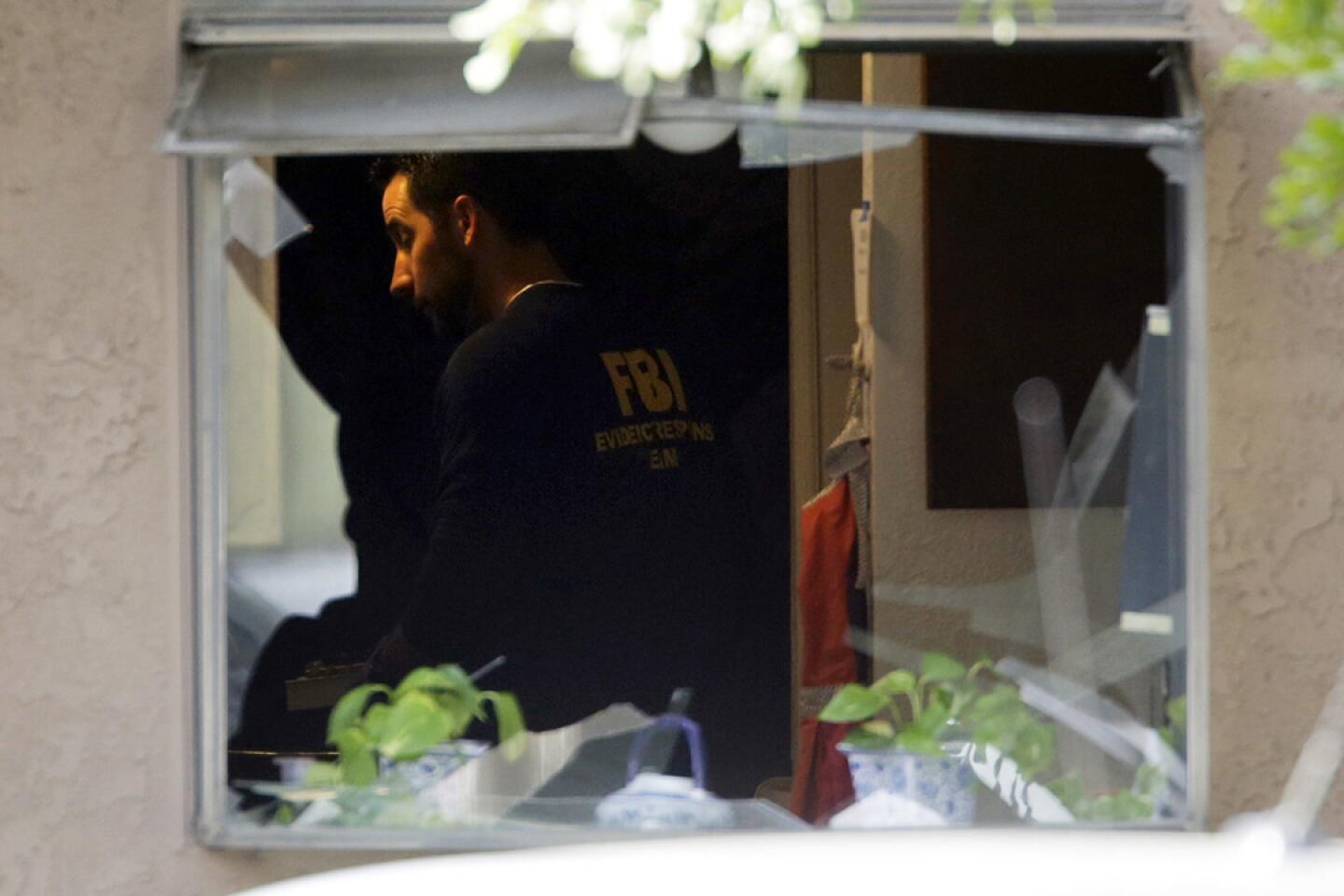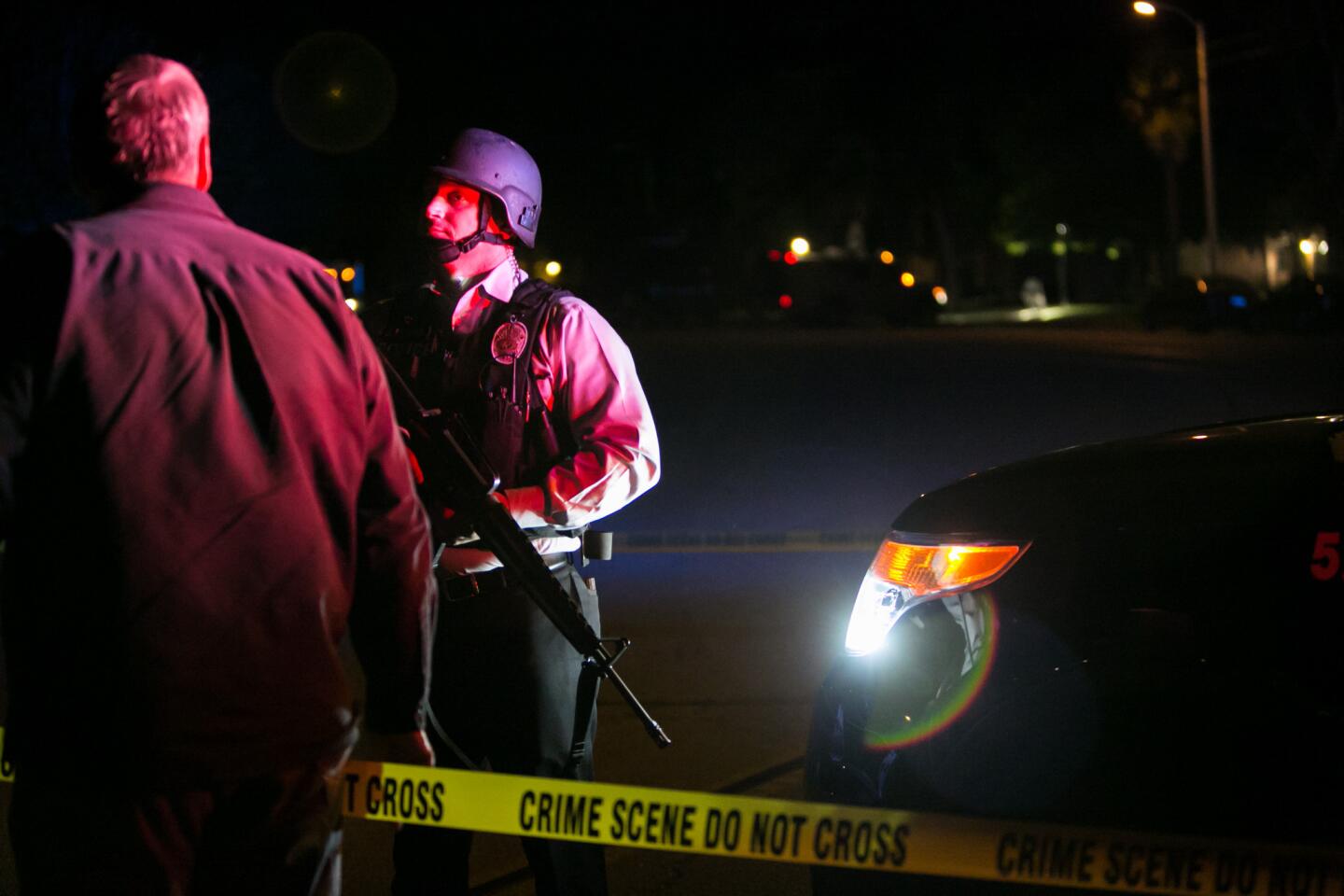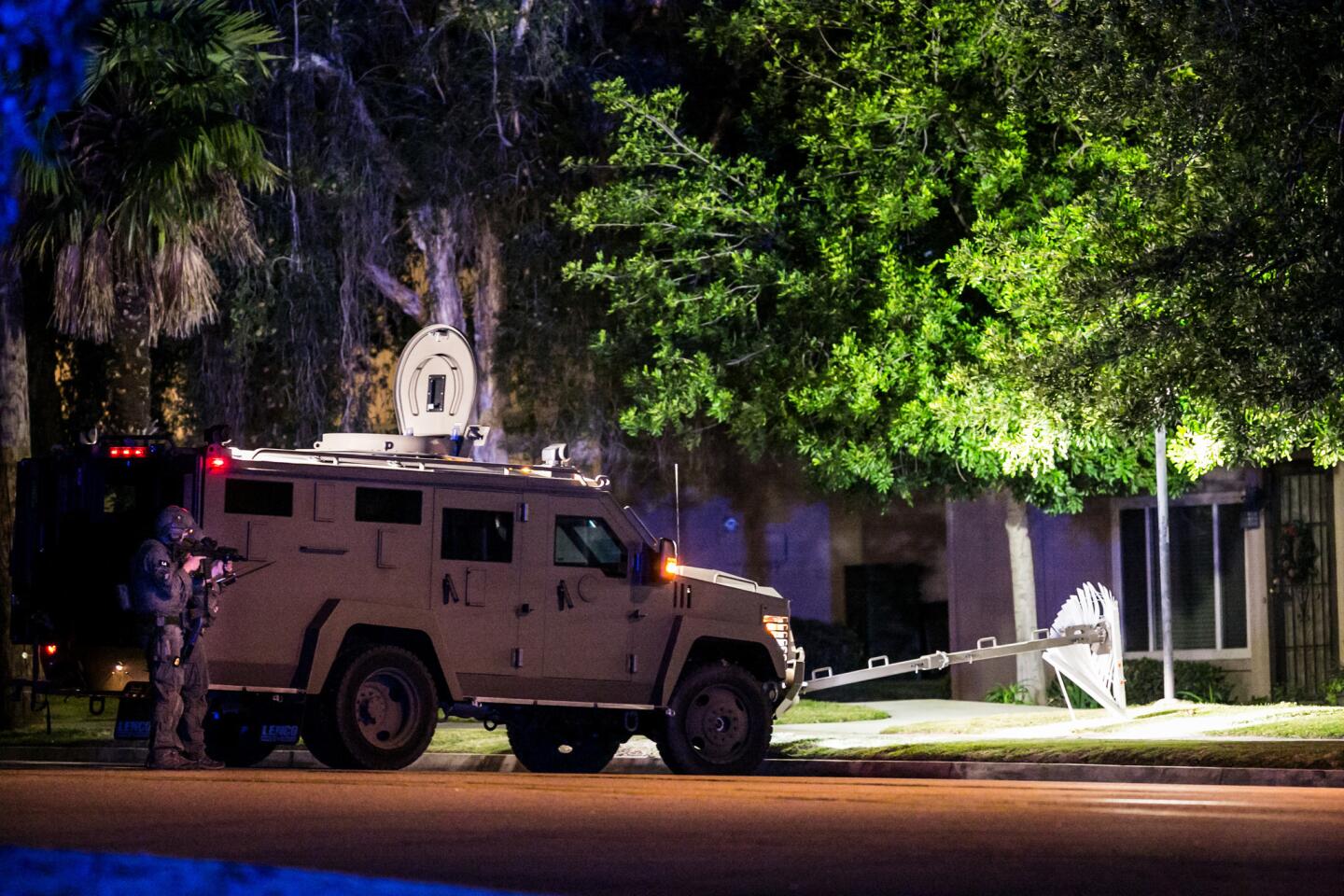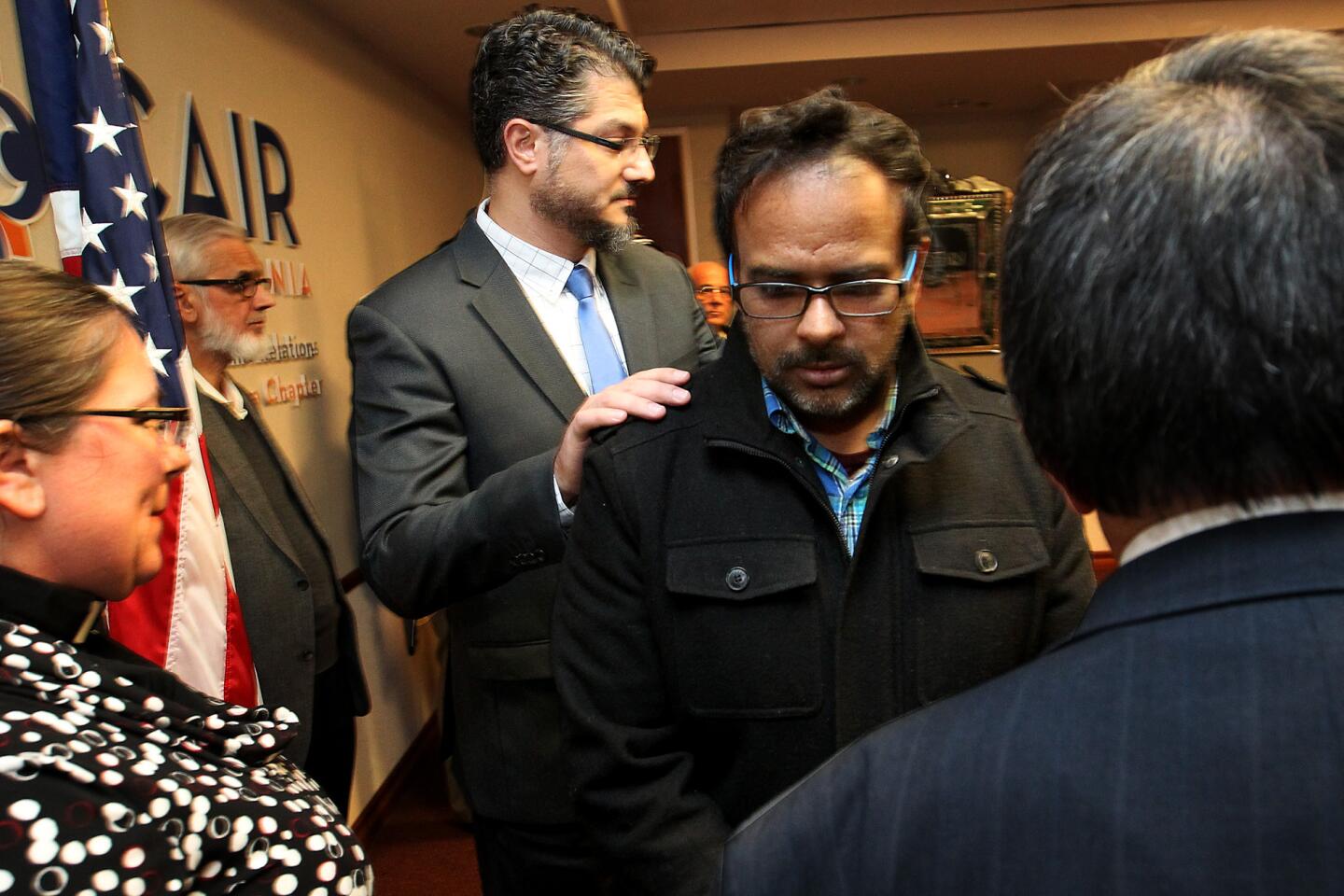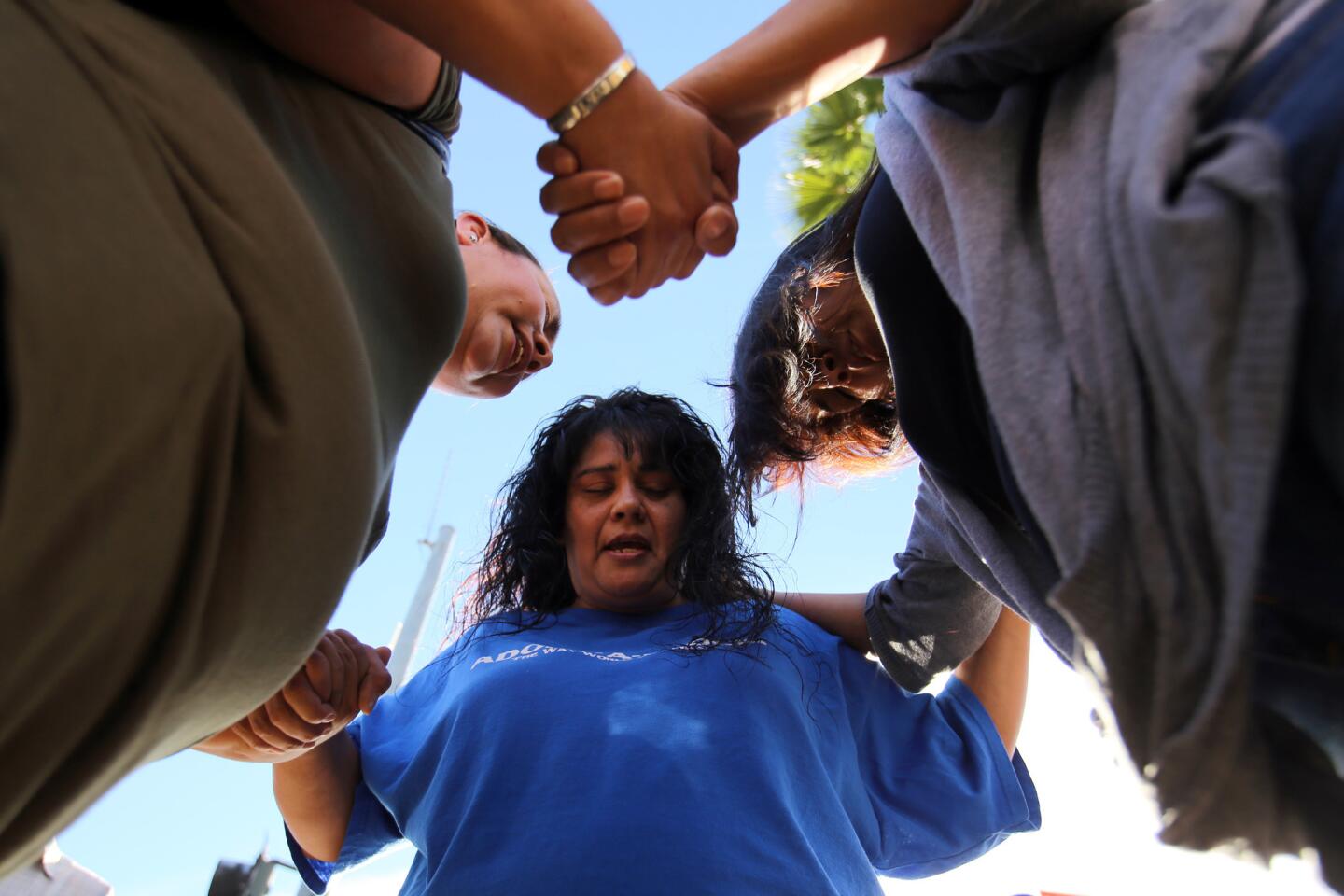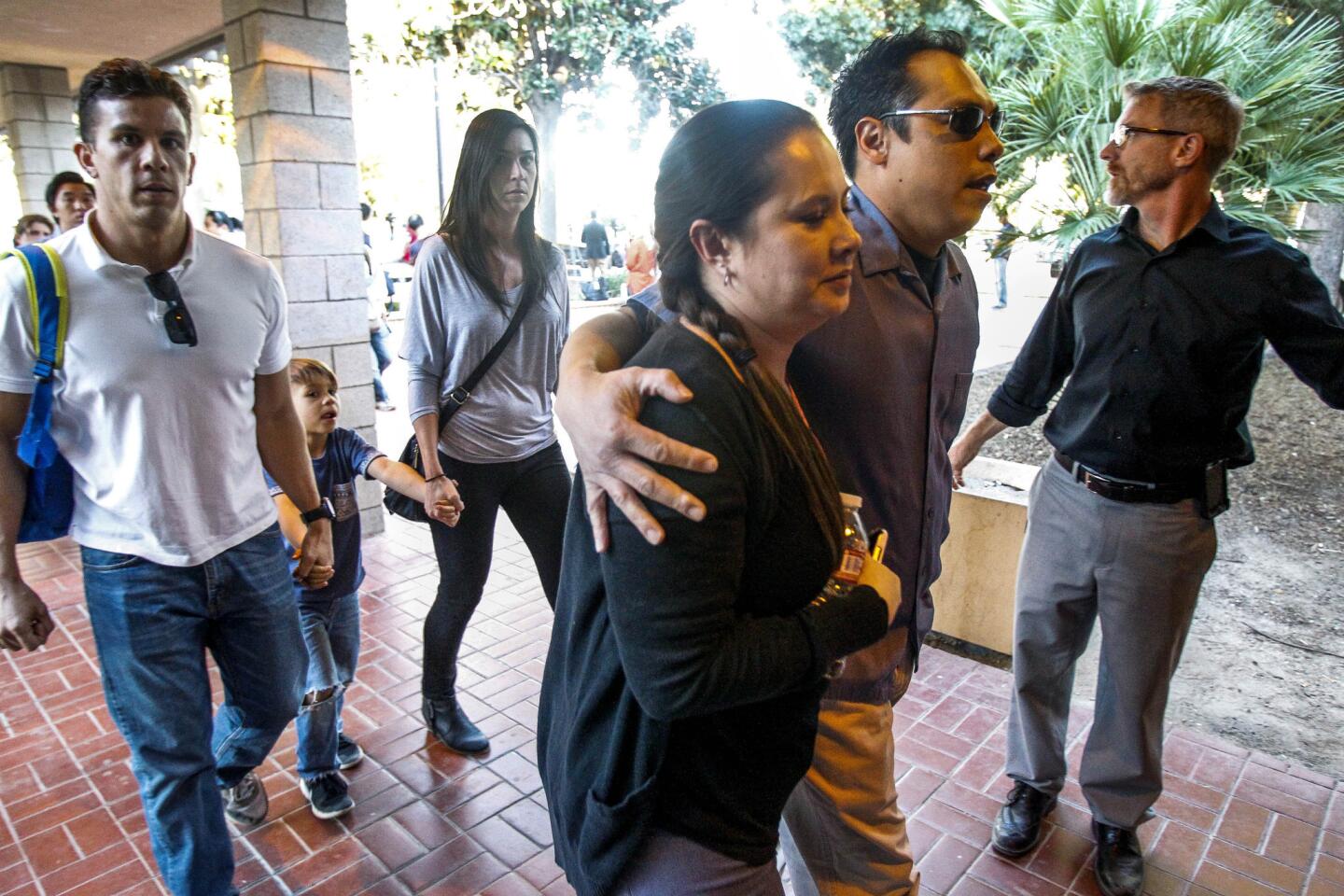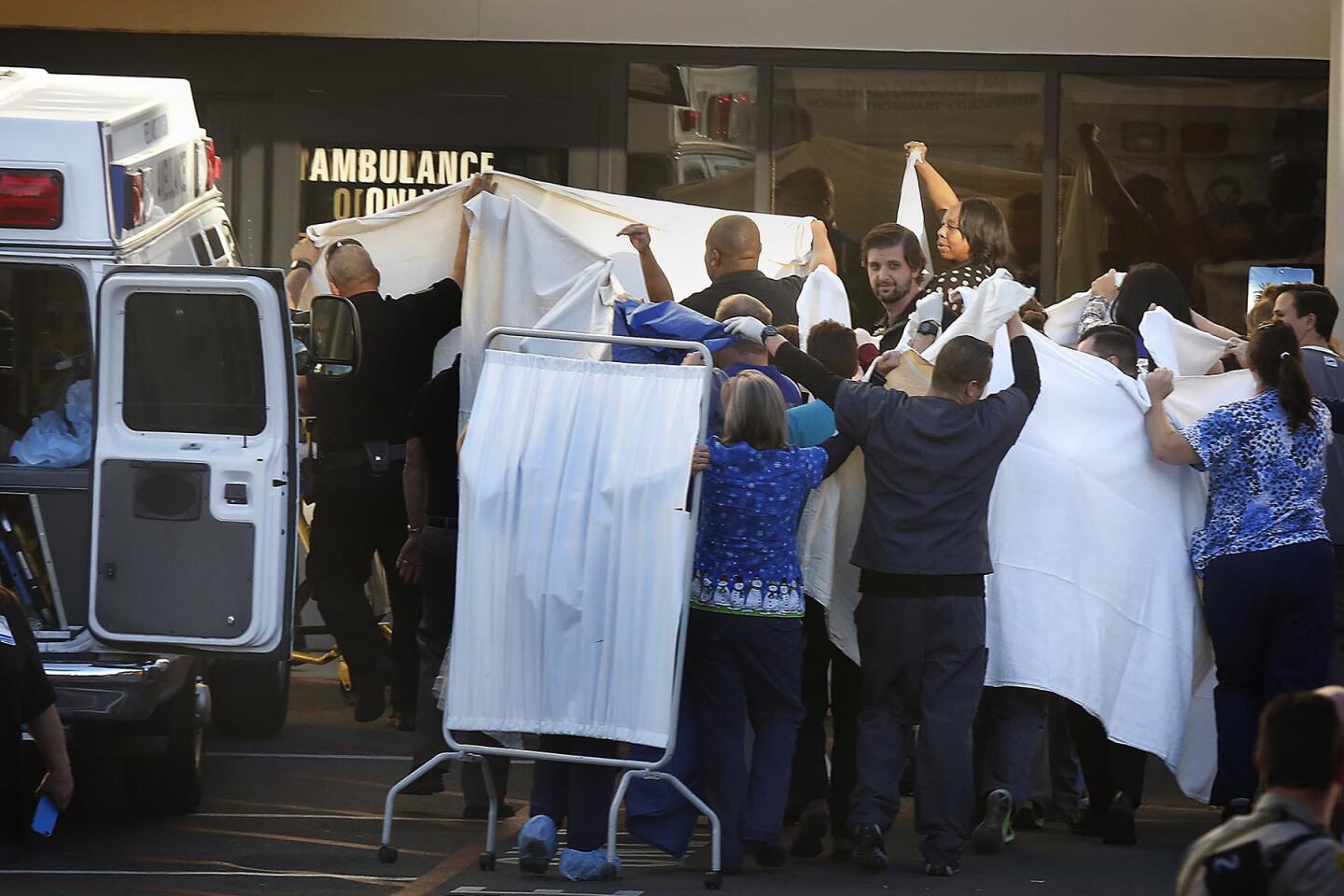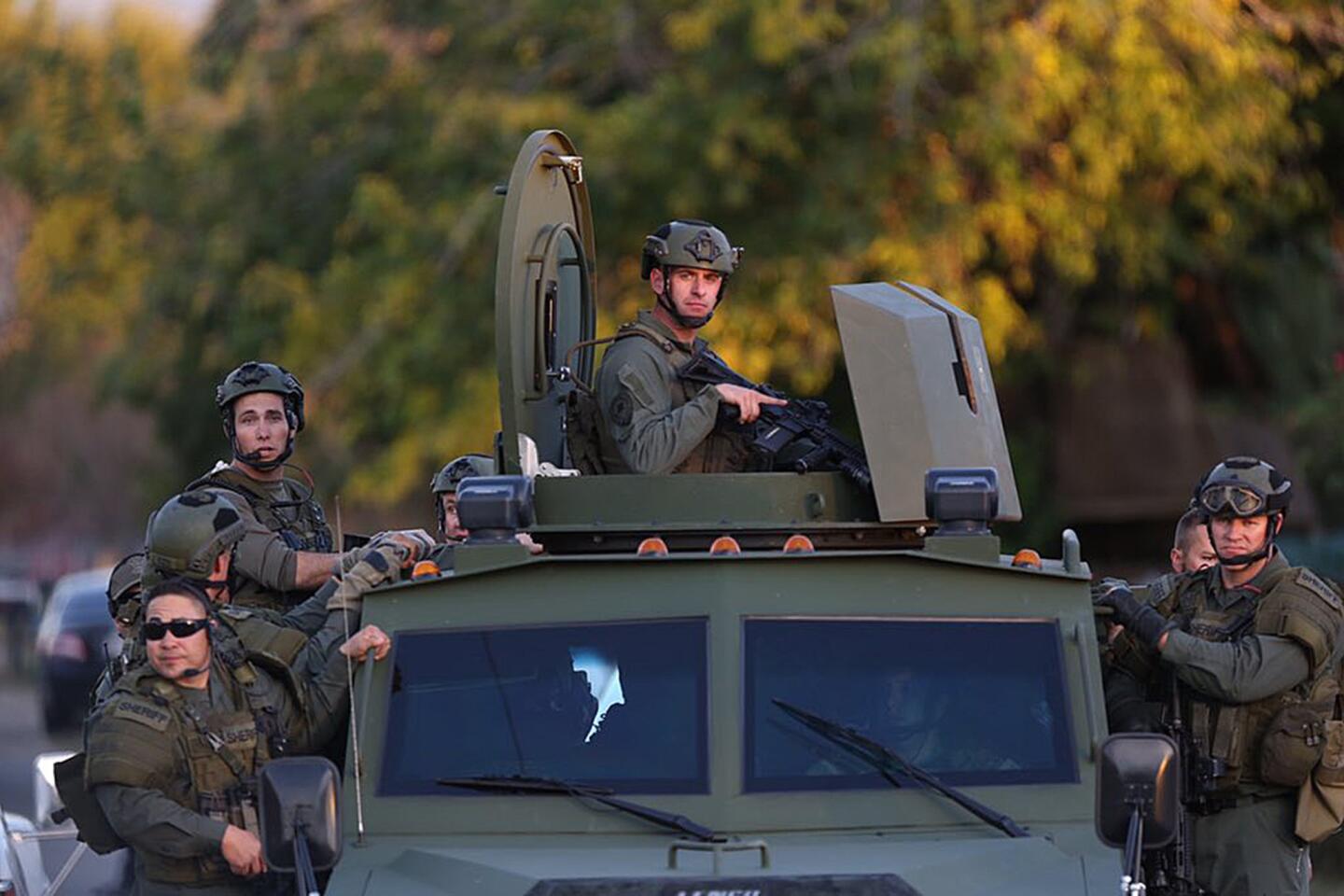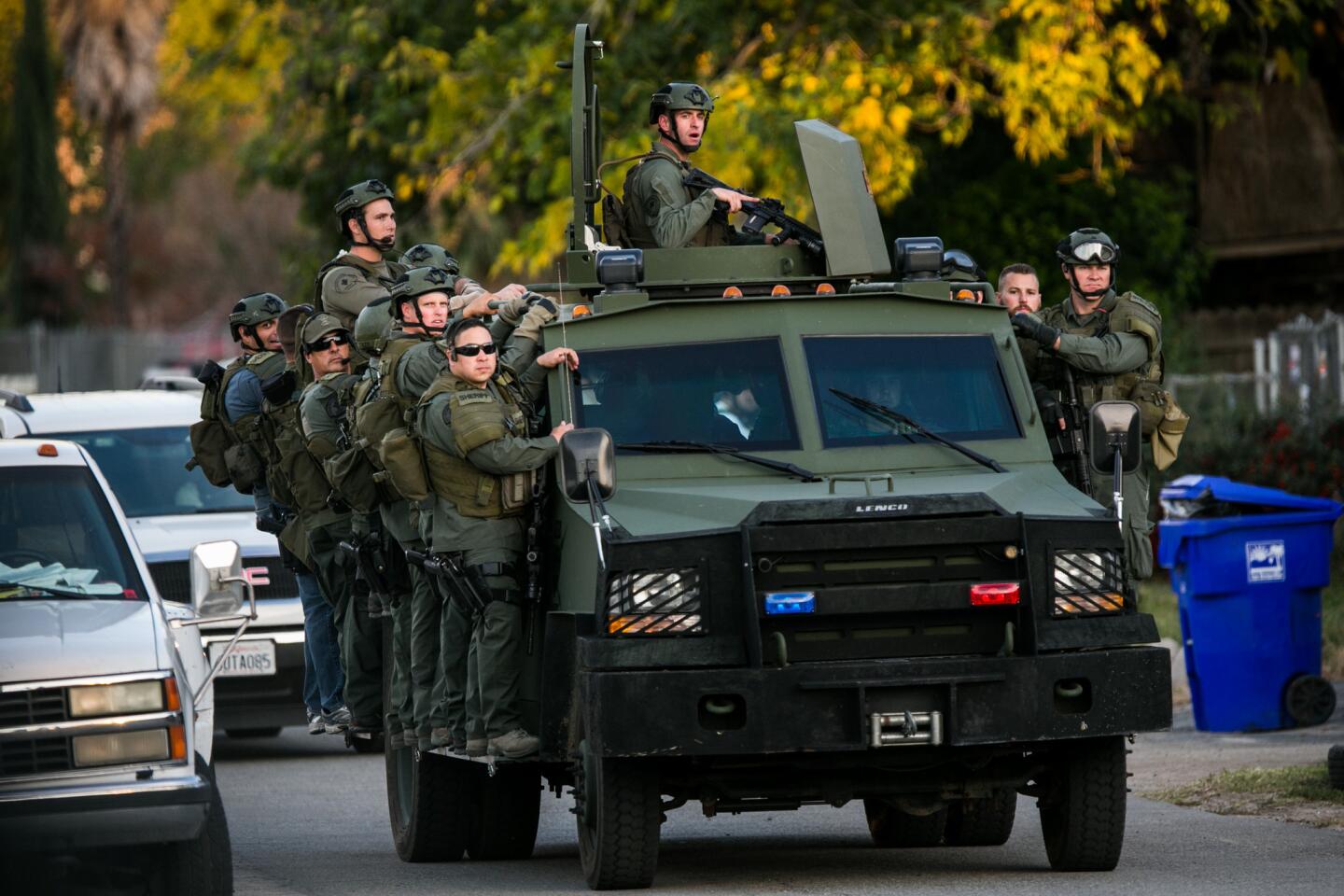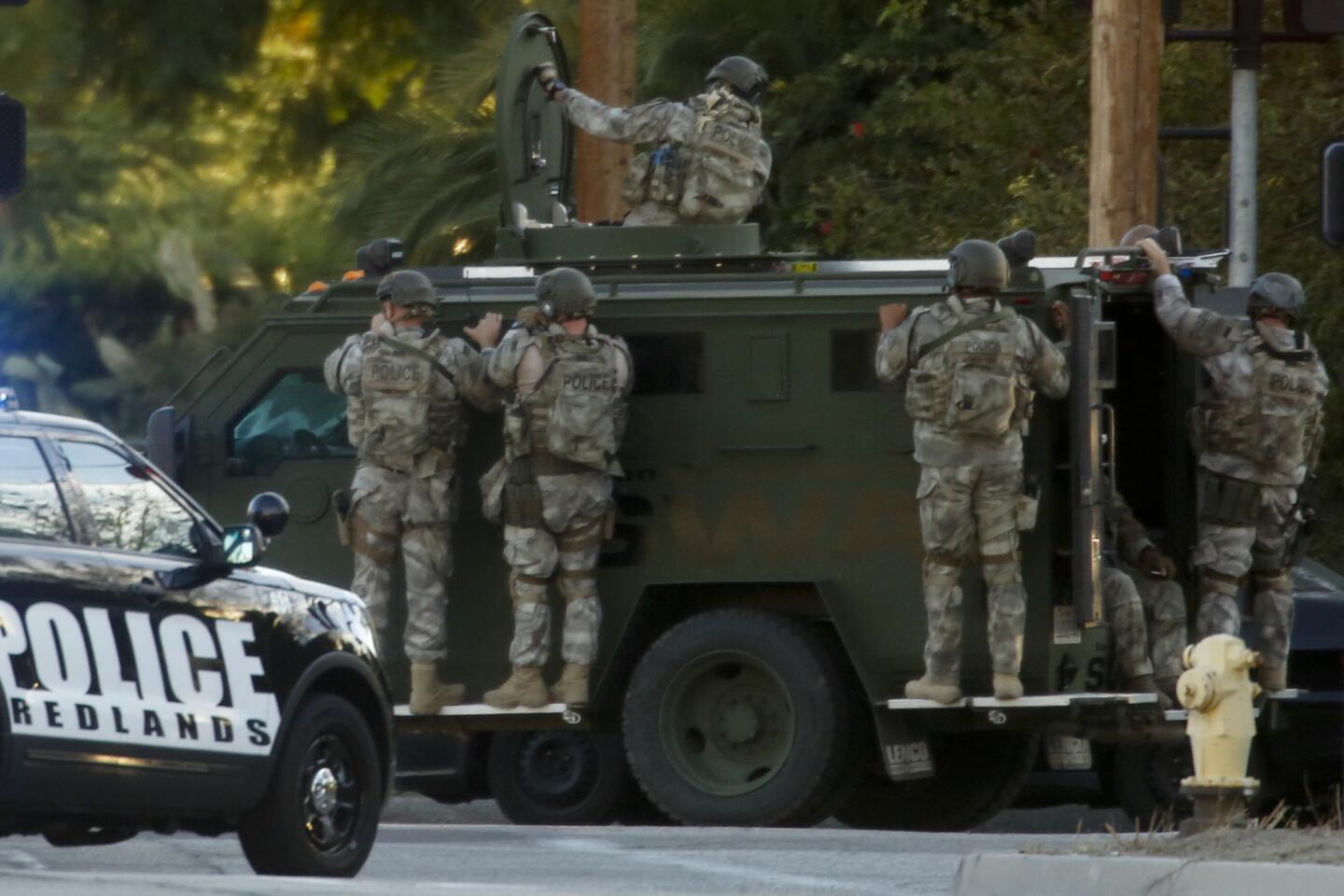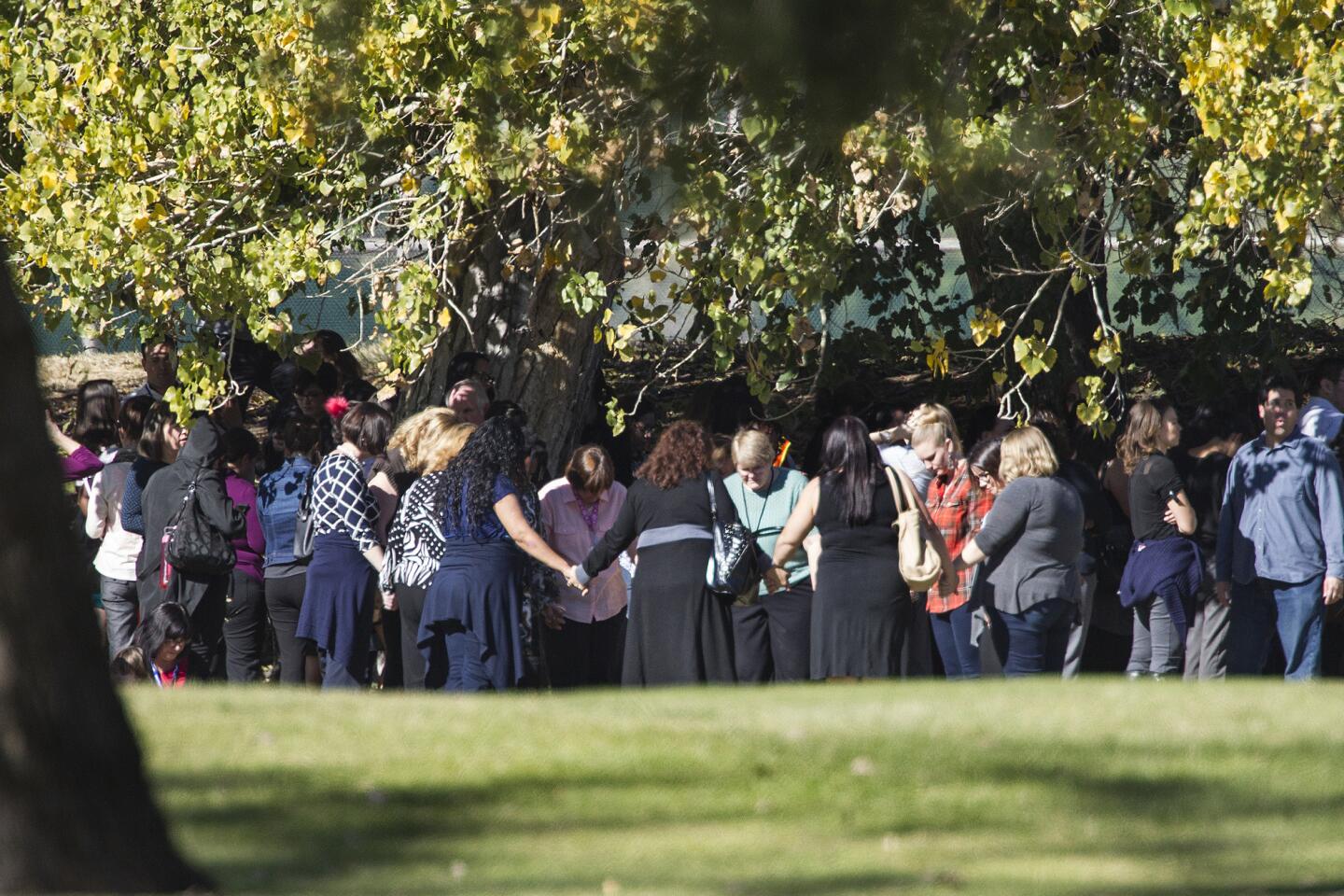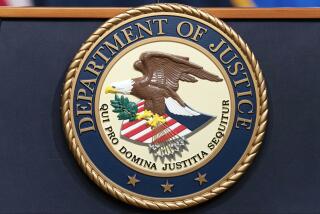Reporting from Washington — San Bernardino killers Syed Rizwan Farook and Tashfeen Malik began scheming to carry out a terrorist attack long before they were engaged or he moved her to the United States on a fiancee visa in July 2014, a widening and increasingly complex FBI investigation has found.
Testifying to the Senate Judiciary Committee, FBI Director James Comey said Wednesday that the FBI has determined “they were radicalized before they started courting or dating each other online, and as early
as the end of 2013 were talking to each other about jihad and martyrdom.”
See the most-read stories this hour >>
The couple thus evaded scrutiny by federal law enforcement, intelligence and counterterrorism agencies for two years before they shot and killed 14 people and wounded 21 others at a holiday party on Dec. 2. It also means they began communicating before the rise of Islamic State.
The couple jointly pledged allegiance to Islamic State on social media shortly before they were killed in a shootout with police, Comey said. Previous reports had indicated that only Malik had done so.
Comey said the FBI is “working very hard to see if anyone else was involved in assisting, equipping or helping them, and did they have other plans.”
Although evidence is still murky, it’s possible the seeds of the San Bernardino plot were planted far earlier.
Farook and possibly others may have planned a terrorist act as early as 2011 or 2012 but dropped it after four men were arrested — three of them in Chino — and ultimately convicted in a plot to kill Americans in Afghanistan, according to a government official briefed on the matter.
The official, who was not authorized to speak publicly, said the FBI has developed information that Farook told at least one associate in 2011 or 2012 that he was considering a terrorist plot.
“Farook was interested in guns then,” the source said FBI agents have learned. “He was going to gun ranges.”
Around that time, Farook’s friend and neighbor, Enrique Marquez, legally purchased the two semiautomatic rifles that Farook and his wife used in their rampage at the Inland Regional Center.
Farook, 28, and Marquez, 24, were next-door neighbors in Riverside until a few months ago. In November 2014, Marquez married the sister of Farook’s sister-in-law. The sisters came separately to the U.S. from Russia on J-1 visas, which allow foreigners to enter for work-study cultural exchange programs, said a federal official speaking on the condition of anonymity because the inquiry is ongoing.
The circumstances of the marriage are now under investigation, the official said. Marquez was interviewed by investigators after he checked himself in to a mental health facility following the shooting.
The FBI director’s comments suggest Farook, a U.S. citizen born in Illinois, may have specifically sought a confederate long before
Islamic State gained international attention in 2014 to help him plan and conduct the deadliest terrorist attack on U.S. soil since Sept. 11, 2001.
Malik, 29, who was born in Pakistan but lived for some time in Saudi Arabia, was “radicalized” before she met her future husband, Comey said, although it’s still unclear who was the driving force behind the plot.
Asked whether the marriage might have been purposely arranged by a foreign terrorist organization to sneak them into the United States to conduct an attack, Comey said, “I don’t know the answer to that yet.”
If it turns out a terrorist group had sent them that far in advance and had carefully kept them undercover for two years, “that would be a very, very important thing to know,” he acknowledged.
1/106
Friends and relatives of Sierra Clayborn gather for her funeral at Mt. Moriah Missionary Baptist Church in South Los Angeles.
(Luis Sinco / Los Angeles Times) 2/106
A memorial service was held for Nicholas Thalasinos on Saturday morning at the Shiloh Messianic Congregation in Calimesa.
(Michael Robinson Chavez / Los Angeles Times) 3/106
A Shabbat service was part of the memorial for Nicholas Thalasinos at Shiloh Messianic Congregation in Calimesa, where Thalasinos and his wife, Jennifer, were integral parts of the congregation.
(Michael Robinson Chavez / Los Angeles Times) 4/106
A hired mover carries out personal items from the home of San Bernardino shooters Syed Rizwan Farook and Tashfeen Malik.
(Gina Ferazzi / Los Angeles Times) 5/106
Residents turn out to greet President Obama’s motorcade in San Bernardino.
(Michael Robinson Chávez / Los Angeles Times) 6/106
President Obama and First Lady Michelle Obama greet San Bernardino Mayor R. Carey Davis, center, and Supervisor James Ramos outside Air Force One at the San Bernardino airport on Friday night.
(Wally Skalij / Los Angeles Times) 7/106
President Obama and First Lady Michelle Obama leave in a motorcade, after arriving at San Bernardino International Airport, to meet privately with the families of the victims of the San Bernardino terrorist attack.
(Gina Ferazzi / Los Angeles Times) 8/106
President Obama and First Lady Michelle Obama depart Air Force One at San Bernardino International Airport.
(Gina Ferazzi / Los Angeles Times) 9/106
San Bernardino residents Ashrie Matthews, left, Leah Brown and James Matthews line the street to cheer the president’s motorcade.
(Michael Robinson Chavez / Los Angeles Times) 10/106
President Obama stopped in San Bernardino on Friday evening to privately visit with the families of some of the victims of the Dec. 2 terrorist attack. Ashrie Matthews, left, Leah Brown and James Matthews joined others to cheer as the president’s motorcade passed.
(Michael Robinson Chavez / Los Angeles Times) 11/106
Anti-Obama protester Deann D’Lean, right, holds some of the many signs she brought to a small protest. In the background, Paul Rodriguez, Jr., with America First Latinos holds a bullhorn. Protesters were out on some San Bernardino street corners voicing their opposition to the president and Islamic State.
(Michael Robinson Chavez / Los Angeles Times) 12/106
People continue to visit the memorial just down the street from where the terrorist attack occurred.
(Michael Robinson Chavez / Los Angeles Times) 13/106
Family members and friends pay their respects to Robert Adams, one of the 14 victims killed in the San Bernardino shooting, during his graveside funeral service at Montecito Memorial Park in Colton.
(Gina Ferazzi / Los Angeles Times) 14/106
Summer Adams, center, grieves at the graveside ceremony for her husband, Robert Adams, at Montecito Memorial Park in Colton.
(Gina Ferazzi / Los Angeles Times) 15/106
A mourner sits on the curb with her head in her hands during the graveside ceremony for San Bernardino shooting victim Robert Adams at Montecito Memorial Park in Colton.
(Gina Ferazzi / Los Angeles Times) 16/106
Mourners embrace at the funeral for Aurora Godoy at Calvary Chapel in Gardena on Wednesday. Godoy was one of 14 killed in the attack in San Bernardino on Dec. 2. (Michael Robinson Chavez / Los Angeles Times)
17/106
Mourners embrace at the funeral for Aurora Godoy at Calvary Chapel in Gardena on Wednesday. Godoy was one of 14 killed in the attack in San Bernardino on Dec. 2.
(Michael Robinson Chavez / Los Angeles Times) 18/106
Mourners arrive for the funeral for San Bernardino shooting victim Aurora Godoy at Calvary Chapel in Gardena on Wednesday.
(Michael Robinson Chavez / Los Angeles Times) 19/106
Shemiran Betbadal, mother of Bennetta Betbadal, is hugged by family after funeral services at Sacred Heart Catholic Church in Rancho Cucamonga.
(Barbara Davidson / Los Angeles Times) 20/106
Pallbearers carry the casket of Bennetta Bet-Badal during funeral services Monday at Sacred Heart Catholic Church in Rancho Cucamonga. Bet-Badal was one of the 14 people killed in the San Barnardino shooting rampage.
(Barbara Davidson / Los Angeles Times) 21/106
The husband and children of Bennetta Bet-Badal hug Monday following her funeral services at Sacred Heart Catholic Church in Rancho Cucamonga.
(Barbara Davidson / Los Angeles Times) 22/106
Funeral services were held for Bennetta Bet-Badal, one of the 14 people killed in the San Barnardino shooting rampage, at Sacred Heart Catholic Church in Rancho Cucamonga.
(Barbara Davidson / Los Angeles Times) 23/106
Funeral services were held for Bennetta Bet-Badal at Sacred Heart Catholic Church in Rancho Cucamonga.
(Barbara Davidson / Los Angeles Times) 24/106
Funeral services were held for Bennetta Bet-Badal at Sacred Heart Catholic Church in Rancho Cucamonga.
(Barbara Davidson / Los Angeles Times) 25/106
Twelve days after the mass shooting attack at the Inland Regional Center in San Bernardino the flowers are beginning to wilt but hugs and paryers are still in abundance.
(Mark Boster / Los Angeles Times) 26/106
Gwen Rodgers, assistant pastor at the Church of Living God, hugs Cindy Quinones, cousin of the slain Aurora Godoy, during a vigil at the makeshift memorial for the victims of the terrorist attacks in San Bernardino, Calif.
(Marcus Yam / Los Angeles Times) 27/106
Visitors arrive to pay their respects at the makeshift memorial outside the fenced off Inland Regional Center, in the background, the site of the deadly terrorist attacks, in San Bernardino, Calif.
(Marcus Yam / Los Angeles Times) 28/106
San Trinh, the longtime boyfriend of Tin Nguyen, 31, one of the victims of the San Bernardino terrorist attack, is consoled by family members as Nguyen’s casket is loaded into a hearse at St. Barbara’s Catholic Church in Santa Ana.
(Marcus Yam / Los Angeles Times) 29/106
Cousins of Tin Nguyen -- Trang Le, left, Tram Le and Krystal Le -- hold onto some of her personal items and cry as they watch her casket being lowered into the ground at her funeral at the Good Shepherd Cemetery in Huntington Beach.
(Marcus Yam / Los Angeles Times) 30/106
Pallbearers stand guard over the casket of the Tin Nguyen, a Cal State Fullerton graduate, at the start of her memorial service at St. Barbara’s Catholic Church in Santa Ana.
(Marcus Yam / Los Angeles Times) 31/106
Van Thanh Nguyen shouts her daughter’s name during her funeral at the Good Shepherd Cemetary in Huntington Beach. Tin Nguyen was 31.
(Marcus Yam / Los Angeles Times) 32/106
Family members and friends write messages on the side of the Tin Nguyen’s burial vault.
(Marcus Yam / Los Angeles Times) 33/106
Van Thanh Nguyen places her hand on her daughter’s casket while surrounded by friends and family.
(Marcus Yam / Los Angeles Times) 34/106
The casket of San Bernardino shooting victim Isaac Amanios leaves the St. Minas Orthodox Church during his funeral service in Colton.
(Wally Skalij / Los Angeles Times) 35/106
Two women cry during Isaac Amanios’ funeral service at the St. Minas Orthodox Church in Colton. Amanios, 60, is survived by his wife and three children.
(Wally Skalij / Los Angeles Times) 36/106
Funeral goers cry during Isaac Amanios’ service. Amanios had shared a cubicle with the male shooter at the San Bernardino County Public Health Department.
(Wally Skalij / Los Angeles Times) 37/106
Frineds and family stand during the funeral service for Isaac Amanios.
(Wally Skalij / Los Angeles Times) 38/106
Trenna Meins, center with daughters after the funeral for her husband Damian Meins at St. Catherine Of Alexandria in Riverside.
(Mark Boster / Los Angeles Times) 39/106
Pallbearers escort the casket of Damian Meins at St. Catherine of Alexandria church in Riverside.
(Gina Ferazzi / Los Angeles Times) 40/106
Mourners gather at St. Catherine Of Alexandria in Riverside on Friday morning for the funeral of Damian Meins, one of 14 people killed in the San Bernardino shooting.
(Mark Boster / Los Angeles Times) 41/106
Trenna Meins places a cross on her husband’s coffin. Damien Meins was killed in a terrorist attack at the Inland Regional Center in San Bernardino.
(Mark Boster / Los Angeles Times) 42/106
Mourners gather for the funeral of Damian Meins.
(Mark Boster / Los Angeles Times) 43/106
Community members sing Amazing Grace during a candlelight vigil for Nicholas Thalasinos and the 13 other San Bernardino shooting victims at Fleming Park in Colton, Calif.
(Gina Ferazzi / Los Angeles Times) 44/106
COLTON, CA - DECEMBER 10, 2015: Jennifer Thalasinos,middle, fights back tears during a candlelight vigil for her slain husband Nicholas Thalasinos and the 13 other San Bernardino shooting victims at Fleming Park on December 10, 2015 in Colton, California.(Gina Ferazzi / Los Angeles Times) (Gina Ferazzi / Los Angeles Times)
45/106
A portrait of Yvette Velasco, one of the victims of the deadly San Bernardino terrorist attacks, is placed at her funeral service at Forest Lawn Memorial Park, in Covina, Calif.
(Marcus Yam / Los Angeles Times) 46/106
Robert Velasco, father of Yvette Velasco, consoles a family member during Yvette’s funeral service at Forest Lawn Memorial Park, in Covina, Calif.
(Marcus Yam / Los Angeles Times) 47/106
COVINA, CALIF.--December 10, 2015 - The coffin of San Bernardino shooting victim, Yvette Velasco, is carried to the hearse following a private viewing for family at Forest Lawn Mortuary in Covina, Calif.
(Barbara Davidson / Los Angeles Times) 48/106
An FBI dive team searches a lake located about two miles north of the Inland Regional Center in connection with last week’s terrorist attack and shootout that left the two attackers and 14 victims dead.
(Luis Sinco / Los Angeles Times) 49/106
An FBI dive team searches a lake near the Inland Regional Center in connection with last week’s terrorist attack.
(Luis Sinco / Los Angeles Times) 50/106
A memorial to victims of the terrorist attack in San Bernardino continues to grow near the Inland Regional Center, where the attack took place during a holiday party.
(Luis Sinco / Los Angeles Times) 51/106
One week after the mass shooting at the Inland Regional Center in San Bernardino, the public is posting signs of gratitude and thanks like this one found at the San Bernardino Police Department.
(Mark Boster / Los Angeles Times) 52/106
Family members and survivors paid their respects with a moment of silence at 11 a.m., exactly one week after the shooting occured at the Inland Regional Center.
(Mark Boster / Los Angeles Times) 53/106
Customers wait for the doors to open at Turner’s Outdoorsman in San Bernardino Wednesday morning.
(Wally Skalij / Los Angeles Times) 54/106
Speaking during a Dec. 8 news conference, dispatcher Michelle Rodriguez of the San Bernardino County Sheriff’s Department becomes emotional as she recounts the events of the deadly San Bernardino attack.
(Marcus Yam / Los Angeles Times) 55/106
Trenna Meins, right, of Riverside, hugs friends and family during a vigil t the Riverside County Health Complex for her husband, Damian Meins, and 13 others killed in the San Bernardino shooting rampage.
(Gina Ferazzi / Los Angeles Times) 56/106
On Dec. 8, people bring flowers, candles and remembrances to a memorial to the San Bernardino shooting victims near the Inland Regional Center, the scene of the attack.
(Brian van der Brug / Los Angeles Times) 57/106
Frank Cobet of the Get Loaded gun store in Grand Terrace shows a customer an AR-15 rifle on Dec. 8.
(Barbara Davidson / Los Angeles Times) 58/106
Monica Gonzales relights candles Tuesday morning at a memorial for victims of the shooting rampage in San Bernardino.
(Wally Skalij / Los Angeles Times) 59/106
Community members and students gather for a Dec. 7 vigil on the Cal State San Bernardino campus to remember the victims of the deadly attack in the city.
(Marcus Yam / Los Angeles Times) 60/106
Patricia Corona of Colton, Calif., holds her children, Dejah Salvato, 7, and Brandon Salvato, 9, as they attend a Dec. 7 vigil at the San Bernardino County Board of Supervisors headquarters to pay tribute to the victims of the city’s recent mass shootings.
(Rick Loomis / Los Angeles Times) 61/106
A prayer is said at the San Bernardino County Board of Supervisors headquarters to honor the victms of the city’s recent mass shootings.
(Rick Loomis / Los Angeles Times) 62/106
FBI agents put up a screen to block the view of onlookers as they investigate the building at the Inland Regional Center in San Bernardino.
(Joe Raedle / Getty Images) 63/106
Syed Farook, father of the suspect in the San Bernardino mass shooting, Syed Rizwan Farook, arrives at his home to a swarm of reporters in Corona, Calif.
(Marcus Yam / Los Angeles Times) 64/106
Roses are laid at the entrance to San Bernardino County headquarters as thousands of employees returned to work Monday, five days after Syed Rizwan Farook and Tashfeen Malik opened fire on a gathering of his co-workers, killing 14 people and wounding 21.
(Mark Boster / Los Angeles Times) 65/106
Trudy Raymundo, director the the San Bernardino County Department of Public Health, is surrounded by San Bernardino County supervisors as she addresses the media during a press conference Monday.
(Mark Boster / Los Angeles Times) 66/106
John Ramos of Riverside pays his respects Monday at a makeshift memorial site honoring Wednesday’s shooting victims in San Bernardino.
(Jae C. Hong / Associated Press) 67/106
Claudia Zaragoza writes a message on a banner at the ever-growing memorial site to the victims of the recent mass shootings near the Inland Regional Center.
(Marcus Yam / Los Angeles Times) 68/106
Caroline Campbell, from left, Jessie Campbell and Rylee Ponce embrace as they pay their respects at the ever-growing memorial site for the victims of the recent mass shootings.
(Marcus Yam / Los Angeles Times) 69/106
Caroline Campbell embraces her son, David Malijan, 6, as they pay their respects at the ever-growing memorial site to the victims of the recent mass shootings near the Inland Regional Center.
(Marcus Yam / Los Angeles Times) 70/106
The Zafarullah family of Chino, originally of Pakistan, watches Obama’s address. Arshia, at left, is holding her 18-month-old nephew, Sohail Ahmed.
(Barbara Davidson / Los Angeles Times) 71/106
One of several signs supporting the city of San Bernardino hang above the 215 Freeway on Sunday evening.
(Rick Loomis / Los Angeles Times) 72/106
Members of the Muslim community, such as Khadija Zadeh, lit candles and wrote messages to the families of victims of the San Bernardino shooting rampage during a memorial service at the Islamic Community Center of Redlands in Loma Linda.
(Barbara Davidson / Los Angeles Times) 73/106
Ajarat Bada prays during a memorial service at the Islamic Community Center of Redlands in Loma Linda to remember the victims of the San Bernardino shooting rampage.
(Barbara Davidson / Los Angeles Times) 74/106
Alaa Alsafadi, center, holds her son, Yousef, 4, during a memorial service at the Islamic Community Center of Redlands in Loma Linda.
(Barbara Davidson / Los Angeles Times) 75/106
Riders from the Christian Motorcycle Association in San Bernardino pray at a growing makeshift memorial for San Bernardino shooting victims near the Inland Regional Center.
(Allen J. Schaben / Los Angeles Times) 76/106
A candlelight vigil dubbed “United We Stand,” took place at Granada Hills Charter High School on Saturday evening. The event was organized by Muslim Youth Los Angeles and Devonshire Area in Partnership.
(Michael Robinson Chavez / Los Angeles Times) 77/106
Ryan Reyes, boyfriend of San Bernardino shooting victim Larry Daniel Kaufman, hugs members of Dar Al Uloom Al Islamiyah of America mosque who brought roses to a memorial at the Sante Fe Dam on Saturday.
(Wally Skalij / Los Angeles Times) 78/106
A bullet hole in the window of a pick up truck where the shootout took place on San Bernardino Avenue.
(Marcus Yam / Los Angeles Times) 79/106
A composite photo of the 14 victims of the San Bernardino shooting rampage. (Courtesy of family / Los Angeles Times)
80/106
People kneel in prayer for victims of the recent mass shootings at the Inland Regional Center, in San Bernardino.
(Marcus Yam / Los Angeles Times) 81/106
After sunset, people continue to arrive at the memorial site for the victims of the recent mass shootings at the Inland Regional Center in San Bernardino.
(Marcus Yam / Los Angeles Times) 82/106
The scene after landlord Doyle Miller opened the doors and allowed the news media inside the Redlands town home where Syed Rizwan Farook and Tafsheen Malik, suspects of the deadly the recent mass shootings in San Bernardino, lived.
(Marcus Yam / Los Angeles Times) 83/106
Josie Ramirez-Herndon, center, and her daughter, Chelsie Ramirez, bottom left, join other community members as they pray during a candlelight vigil.
(Marcus Yam / Los Angeles Times) 84/106
Fabio Ahumada, a San Bernardino EMT, attends a vigil at San Manuel Stadium
(Barbara Davidson / Los Angeles Times) 85/106
A couple embrace at the candlelight vigil to honor the victims of the mass shootings at the Inland Regional Center.
(Marcus Yam / Los Angeles Times) 86/106
Angel Meler-Baumgartner 11, who was a member of the Inland Regional Center, where the shooting occurred, attends a vigil at San Manuel Stadium for the victims.
(Barbara Davidson / Los Angeles Times) 87/106
The Ahmadiyya Muslim Community USA held a press conference and prayer vigil at Baitul Hameed Mosque in Chino. The group denounced the massacre.
(Michael Robinson Chávez / Los Angeles Times) 88/106
Amy Mahmood, right, holds hands with a woman named Shenaz during the vigil at San Manuel Stadium.
(Barbara Davidson / Los Angeles Times) 89/106
Ryan Reyes, center, breaks down after finding out his boyfriend of three years, Daniel Kaufman, 42, was one of those killed during Wednesday’s mass shooting at the Inland Regional Center in San Bernardino.
(Rick Loomis / Los Angeles Times) 90/106
Ryan Reyes holds an image of his boyfriend Daniel Kaufman who was confirmed as one of the 14 victims of Wednesday’s mass shooting at the Inland Regional Center in San Bernardino.
(Rick Loomis / Los Angeles Times) 91/106
Larry Jones, left, pastor of Crossover Outreach Church; Dr. Jeannetta Million, pastor of Victoria’s Believers Church; and Arnold Morales, pastor of King of Glory Church, pray for the victims and those involved in the mass shooting in San Bernardino.
(Marcus Yam / Los Angeles Times) 92/106
A coalition of church leaders comes together to pray for the victims and those involved in the San Bernardino shootings.
(Marcus Yam / Los Angeles Times) 93/106
FBI investigators inside the suspects’ Redlands home on Thursday morning.
(Irfan Khan / Los Angeles Times) 94/106
The investigation continues Thursday morning on San Bernardino Avenue, where two suspects in the mass shooting at the Inland Regional Center died in a shootout with police.
(Irfan Khan / Los Angeles Times) 95/106
Law enforcement stands guard at a police line as investigators work at a Redlands home after the San Bernardino attack.
(Marcus Yam / Los Angeles Times) 96/106
A SWAT team stands guard with a rifle pointed at a home that is being investigated by police after today’s San Bernardino’s mass shootings.
(Marcus Yam / Los Angeles Times) 97/106
Farhan Khan, second from right, who was identified as the brother-in-law of San Bernardino shooting suspect Syed Rizwan Farook, joins religious leaders during a news conference at the Council of American Islamic Relations in Anaheim.
(Luis Sinco / Los Angeles Times) 98/106
San Bernardino County sheriff’s deputies draw guns behind a minivan on Richardson St. during a search for suspects involved in the mass shooting of 14 people at the Inland Regional Center in San Bernardino.
(Gina Ferazzi / Los Angeles Times) 99/106
Marie Cabrera, Sonya Gonzalez and Christine Duran, all of San Bernardino, pray after the mass shooting in San Bernardino.
(Rick Loomis / Los Angeles Times) 100/106
A woman and a man enter the Rudy C Hernandez Community Center after they and other people, who were at the scene of a mass shooting, arrived by bus to be reunited with their familys.
(Hayne Palmour IV / San Diego Union-Tribune) 101/106
Emergency personnel bring in a wounded person into Loma University Medical Center after the shooting in San Bernardino on Wednesday.
(Barbara Davidson / Los Angeles Times) 102/106
A SWAT unit is on the move in San Bernardino.
(Marcus Yam / Los Angeles Times) 103/106
A member of the San Manual Fire Department takes the names of people evacuated from the scene of a mass shooting in San Bernardino before they are loaded onto buses and taken away from the area.
(Rick Loomis / Los Angeles Times) 104/106
Sheriff’s department SWAT members deploy on Richardson Street in San Bernardino on Wednesday.
(Marcus Yam / Los Angeles Times) 105/106
Sheriff’s department SWAT members deploy near San Bernardino Avenue and Richardson Street in San Bernardino on Wednesday.
(Mark Boster / Los Angeles Times) 106/106
Evacuated workers join in a circle to pray on the San Bernardino Golf Course across the street from where a shooting occurred at the Inland Regional Center.
(Gina Ferazzi / Los Angeles Times) Malik’s role came under additional scrutiny as investigators found a false address on part of her K-1 visa application, the so-called fiancee visa, that allowed her to enter the United States to marry Farook and become a U.S. resident.
“Our government apparently didn’t catch the false address in Pakistan she listed on her application or other possible signs that she was radicalized or an operative,” said Sen. Charles E. Grassley (R-Iowa), who chaired the Senate hearing.
Two government sources told The Times that Malik used the name of a neighborhood or street near her home in Pakistan, rather than her family’s home address. Investigators speculate that she sought to deflect any investigation of her family’s reputed ties to Islamic militants in Punjab.
Pakistani security officials questioned teachers and students at an Islamic seminary she had attended in 2013. They also searched the house where she apparently had lived in Multan, a small city in central Pakistan, where she attended a university from 2007 to 2013.
The Bush and Obama administrations used drones to conduct hundreds of lethal airstrikes against militant groups in northwest Pakistan during those years, stoking widespread public anger. The 2011 killing of Osama Bin Laden by U.S. Navy SEALs in Abbottabad, close to the capital city of Islamabad, led to furious anti-American protests.
But security officials in Islamabad said Wednesday that they have found no evidence showing that Malik had contact with Al Qaeda or other militant organizations.
Her ability to obtain the K-1 visa — which required her to give fingerprints and other information that was checked against U.S. immigration, terrorism and criminal databases — sparked concern in Congress.
The Senate Homeland Security Committee demanded more information on how her visa application was handled and whether Farook’s background was checked as well.
Sen. Ron Johnson (R-Wis.), the committee chairman, and the ranking Democrat, Sen. Tom Carper of Delaware, suggested the process was tilted toward approvals. The State Department processed 36,542 K-1 visas in fiscal year 2014 and denied only 618, they said.
For now, the FBI is focusing on how they missed the secret radicalization of Farook and his wife, and Farook’s apparent comments as early as 2011 that he was considering a terrorist attack.
The FBI believes Farook abandoned that plan after the arrests of three men in November 2012 as they left an apartment in Chino. They had allegedly planned to drive to Mexico, fly to Afghanistan and join radical Islamic militants. A fourth suspect was taken into custody by U.S. military personnel in Afghanistan.
Soheil Omar Kabir, a naturalized U.S. citizen born in Afghanistan and living in Pomona, and Ralph Deleon of Ontario, a legal permanent resident and citizen of the Philippines, were convicted in 2014 on charges related to providing material support to terrorists and plotting to kill Americans in Afghanistan.
The other two defendants, Miguel Alejandro Santana Vidriales and Arifeen David Gojali, previously had pleaded guilty.
In announcing the convictions last year, U.S. Atty. Stephanie Yonekura said the case showed the danger of local residents being influenced by foreign terror groups — precisely what appears to have happened in the San Bernardino massacre.
“Extremist ideologies can reach from Afghanistan to America,” Yonekura said, “demonstrating the clear need for continued vigilance in rooting out homegrown violent extremists.”
richard.serrano@latimes.com
brian.bennett@latimes.com
Contributing to this report were Times staff writers Christi Parsons in Washington, Kate Mather in Riverside and Shashank Bengali in Mumbai, and special correspondent Aoun Sahi in Islamabad.
MORE ON SAN BERNARDINO
U.S. worried about foreign fighters returning from Syria and Iraq
A look at the K-1 visa that gave San Bernardino shooter entry into U.S.
One brother hatched a terrorist massacre, the other served his country in the U.S. Navy

